



Geopolitics of the Energy Transition
Acknowledgements
This report was authored under the guidance of Elizabeth Press (Director, IRENA Planning and Programme Support) by Thijs Van de Graaf (IRENA consultant and lead author), Martina Lyons, Isaac Elizondo Garcia, Ellipse Rath (IRENA) and Benjamin Gibson (ex-IRENA).
The authors are grateful for the reviews, inputs and support provided by IRENA colleagues Roland Roesch, Rabia Ferroukhi, Anastasia Kefalidou, Claire Kiss (ex-IRENA), Deepti Siddhanti, Divyam Nagpal, Francis Field, Francisco Boshell, Griffin Thompson (IRENA consultant), Kathleen Daniel, Kelly Rigg (IRENA consultant), Michael Renner, Mirjam Reiner, Paul Komor, Sophie Sauerteig (ex-IRENA), Stephanie Clarke, Ute Collier and Zhaoyu ‘Lewis’ Wu.
Other valuable inputs were provided by Sara Geeraerts (IMEP); André Månberger, Dastan Bekmuratov, Gavkharkhon Mamadzhanova, Ida Dokk Smith, Indra Overland, Julia Loginova, Mari Tønnessen, Philip Swanson, Roman Vakulchuk and Tatjana Stankovic (NUPI).
Peer review was provided by Henry Sanderson (Benchmark Mineral Intelligence); Jan Morrill, Paulina Personius, Payal Sampat and Vuyisile Ncube (Earthworks); Sebastian Sahla (EITI); Yana Popkostova (European Centre for Energy and Geopolitical Analysis); Irina Patrahau (HCSS); Karsten Sach (IRENA consultant); Patrícia Alves Dias and Vangelis Tzimas (JRC); Hans Olav Ibrekk and Jonas Volden Weltan (MFA, Norway); Jean- Philippe Bernier and Jeffrey Akomah (Natural Resources Canada); David Manley (NRGI); Clarisse Legendre, Louis Marechal, Luca Maiotti and Przemyslaw Kowalski (OECD); Jim Krane (Rice University's Baker Institute); Kathryn Sturman (Sustainable Minerals Institute); Leonardo Buizza (SYSTEMIQ Ltd, ETC); Ligia Noronha and Maria Jose Baptista (UNEP); Matthew David Wittenstein (UN ESCAP); Virginie Nachbaur (University of Rouen Normandy); Aaron NG, Anna Wendt, Dennis Mesina and, Salim Bhabhrawala (US Department of Energy); and Dolf Gielen (World Bank).
IRENA is grateful to the following national representatives for their responses to the survey: Nirod Chandra Mondal (Bangladesh); Robbie Frank (Canada); Moussa Ousman (Central African Republic); Jarkko Vesa (Finland); Nicolas Leconte (France); Stefano Raimondi (Italy); Brian Richardson (Jamaica); Paul Mbuthi (Kenya); Harold Madriz (Nicaragua); Rosilena Lindo (Panama); Marco Antonio Santiváñez Pimentel (Peru); Josephine Bahr Ljungdell (Sweden); Brian Isabirye (Uganda); Mahek Mehta (United Kingdom); Aaron Ng (United States); and Sosten Ziuku (Zimbabwe).
IRENA also thanks the following expert survey respondents for their valuable inputs: Phung Quoc Huy (Asia Pacific Energy Research Centre); Paul Huggins (Carbon Trust); Coby van der Linde (Clingendael International Energy Programme); Sebastian Sahla (EITI); Leonardo Buizza (Energy Transitions Commission/Systemiq Ltd.); Yana Popkostova (European Centre for Energy and Geopolitical Analysis); Reed Blakemore (Global Energy Center; Atlantic Council); Elrika Hamdi (IEEFA); Veronica Navas Ospina (IFC); Christian Breyer (LUT University); Sohbet karbuz (OME); Mostefa Ouki (Oxford Institute for Energy Studies); James Bowen (Perth USAsia Centre); Ramona Liberoff (Platform for Accelerating the Circular Economy); Michael Reckordt (PowerShift e.V.); Jim Krane (Rice University's Baker Institute); Kingsmill Bond (RMI); Dirk Uwe Sauer (RWTH Aachen University); Rainer Quitzow (SWP); Irina Patrahau (The Hague Centre for Strategic Studies); Matthew Wittenstein (UN ESCAP); Rudiger Tscherning (University of Calgary); Karla Cervantes Barron (University of Cambridge); Dolf Gielen (World Bank); and Mirza Sadaqat Huda (Yusof Ishak Institute).
Editing was provided by Steven Kennedy, and design by weeks.de Werbeagentur GmbH.
Foreword
More so than any other sector or industry, energy is a core driver of socio-economic outcomes and geopolitical landscapes. As the world transitions toward more resilient, inclusive and clean energy systems, the essential role of renewable energy is clearer than ever before. This transition is set to induce far-reaching and transformative changes, and recent years have demonstrated yet again how the global energy system is intricately intertwined with geopolitics.
IRENA’s analytical work on geopolitics began in 2018 with the formation of the Global Commission on the Geopolitics of Energy Transformation, which culminated in a sweeping overview of the geopolitical implications of a global shift to renewables in the 2019 report, A New World: The Geopolitics of the Energy Transformation. In 2020, IRENA created the Collaborative Framework on the Geopolitics of Energy Transformation as a forum for dialogue on the geopolitical implications of this shift. In response to priorities voiced by IRENA’s members during those discussions, IRENA undertook a detailed study on the future of hydrogen in the 2022 report, Geopolitics of the Energy Transformation: The Hydrogen Factor.
In Geopolitics of the Energy Transition: Critical Materials, the focus pivots to a theme that embodies both the future and the past. Today, it is abundantly clear that the energy transition will require a dramatic increase in the supply of critical materials. Projections for rapidly growing materials demand create both opportunities and the spectre of geopolitical risks. Yet the rush for raw minerals and metals is not a new phenomenon; be it coal, gold or any other extractive commodity in human history, this is, in many ways, a familiar paradigm. Mining has all too often played out as a tale of extremes – simultaneously characterised by the newfound comforts and prosperities, and a legacy of poor labour records, displacements, polluted waterways and degraded land in the communities where mines operate. A renewables-based energy transition provides a chance to rewrite the script for extractive commodities and ensure their value chains are more inclusive, ethical and sustainable.
The report draws on a wide range of sources to provide a balanced and nuanced perspective on the many complex issues at play. It is intended as a resource for policy makers, industry leaders, researchers and civil society actors who seek to understand and address the geopolitical challenges of a renewables-based energy transition.
I would like to express my thanks to IRENA’s membership for supporting this work and to the many expert reviewers who provided valuable input and feedback throughout its production. I hope that this report will contribute to a more informed and constructive dialogue on critical materials and help the world advance towards a more sustainable and equitable future.
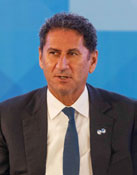
Director-General, IRENA
Summary for Policy makers
The energy transition will be a main driver of demand for several critical minerals. The transition will be mineral- and metal-intensive. At present, the bulk of the demand for such materials is for uses unrelated to the energy transition; but as the transition progresses, demand for many materials is projected to grow. IRENA’s 1.5°C scenario documents the vast scale of the energy transition infrastructure - and critical materials - needed to achieve climate stabilisation. This will include 33 000 GW of renewable power and the electrification of 90% of road transport in 2050. Already, a mismatch between supply and demand for several minerals is evident, with particularly high levels observed for lithium.
Assessment of the criticality of materials is dynamic and continuously changing owing to economic, geopolitical and technological factors. Presently there is no universally accepted definition of critical materials. Many countries and regions maintain lists of critical materials, which typically mirror current technologies, the prevailing global dynamics of supply and demand, and the context in which the assessments are conducted. The factors for determining criticality therefore remain subjective and location-specific. IRENA’s review of 35 lists of critical materials reveals that 51 materials used for the renewables-based energy transition appeared on at least one list.
Critical material supply disruptions have minimal impacts on energy security, but outsized impacts on the energy transition. The current notion of energy security revolves around the continuous accessibility of energy sources, primarily rooted in concerns over fossil fuel supply. By contrast, renewable energy technologies that are already built could continue to operate for decades, even if supplies of critical material inputs were disrupted. Therefore, the risk associated with disruptions in the supply of critical materials is less about energy security and more about the potential slowdown of energy transitions.
Dependency risks and supply dynamics of critical materials fundamentally differ from those of fossil fuels, given vastly different characteristics and patterns. A prominent concern is that energy transitions will entail trading dependency on fossil fuels for dependency on critical materials. However, significant differences in their production, trade and use do not warrant such an assumption (Figure S1). Moreover, projections of critical material demand and use are fraught with uncertainties across distant time horizons, so a careful assessment of associated risks is required to understand and proactively manage them.
There is no scarcity of reserves for energy transition minerals, but capabilities for mining and refining them are limited. In the short to medium term, market constraints are likely to emerge, partly due to underinvestment in upstream activities. It is unlikely that a worldwide shortfall of any one mineral will hinder the energy transition. Production has surged for many energy transition minerals, and reserves mined from economically viable sources have grown. Moreover, disruptive innovation - such as efficiency improvements and material substitutions - are already reshaping demand.
FIGURE S1 Critical materials are fundamentally different to fossil fuels
The mining and processing landscape of critical materials is geographically concentrated, with a select group of countries playing a dominant role. In the mining of critical materials, dominant positions are held by Australia (lithium), Chile (copper and lithium), China (graphite, rare earths), the Democratic Republic of Congo (cobalt), Indonesia (nickel) and South Africa (platinum, iridium). This concentration becomes even more pronounced in the processing stage, with China currently accounting for 100% of the refined supply of natural graphite and dysprosium (a rare earth element), 70% of cobalt, and almost 60% of lithium and manganese (Figure S2).
FIGURE S2 Key mining countries for select minerals
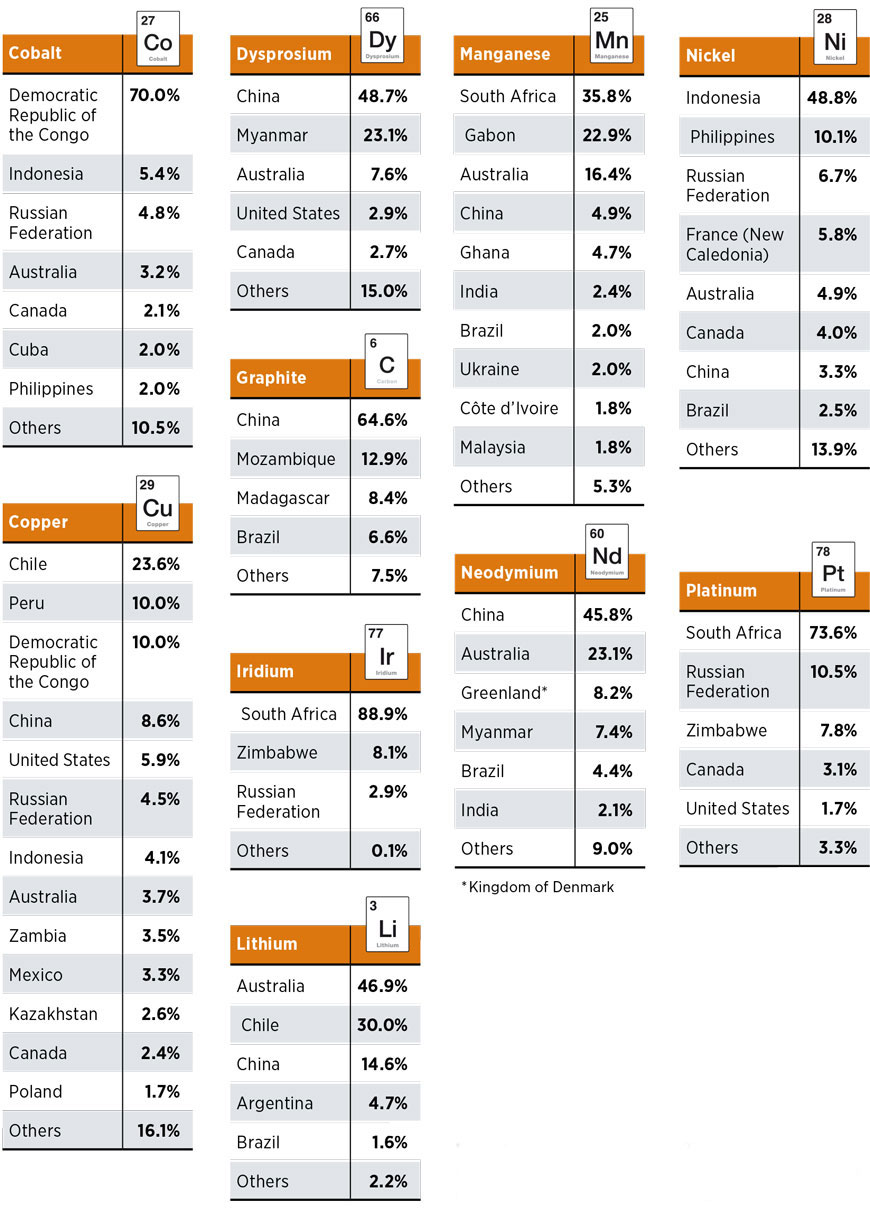
Source: (US Geological Survey and US Department of the Interior, 2023; JRC, 2020; USGS, 2023b).
The mining industry is dominated by a few major companies, yielding small and often oligopolistic markets. These large multinational corporations and state-owned or -controlled enterprises operate across multiple countries and possess the resources and skills needed to develop complex mines. As a result, the industry is highly concentrated, with a few companies controlling a significant portion of global production and trade. The top five mining companies control 61% of lithium output and 56% of cobalt output.
Trade in critical materials is many orders of magnitude smaller by value than trade in fossil fuels. Unlike oil, most critical materials are not widely traded on exchanges. While this limits opportunities to hedge against price volatility, it allows commodity traders to play a key role in matching producers and consumers.
FIGURE S3 Value of exports for selected commodities (2021)
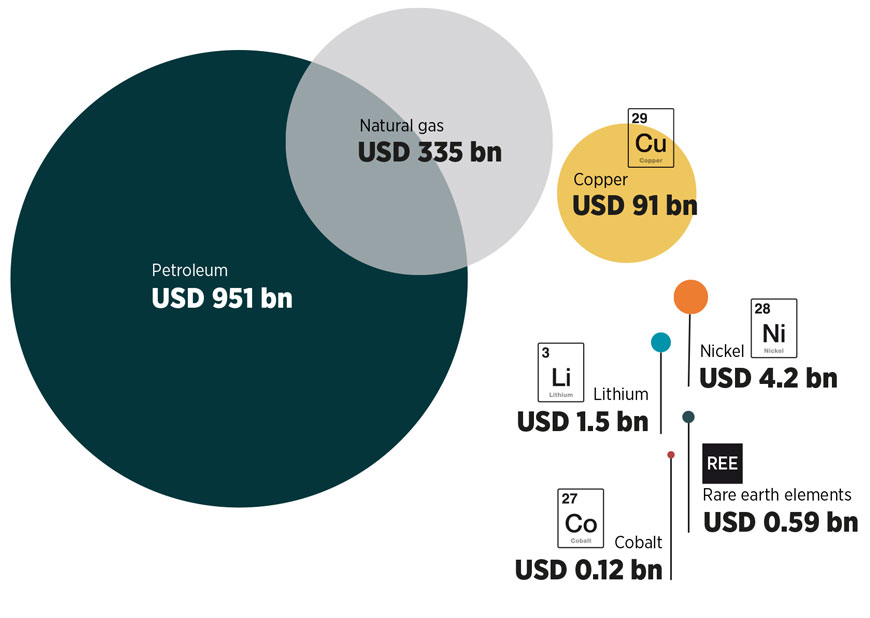
Note: Numbers represent trade in raw, unprocessed fuels and ores only.
The full extent of reliance and exposure to disruptions is not always obvious. Mineral commodities sourced from different countries can be embedded in imported finished and semi-finished products, thus obscuring potential links and vulnerabilities. Moreover, import transactions are sometimes attributed only to the country of the last shipment, not to the country in which the material was originally mined or manufactured.
Each critical material has a unique geography of trade which, on an aggregate level, entangles countries in a broader web of interdependence. All countries rely on a functioning global market for critical materials and related technologies, given that they either import these commodities or rely on a steady demand for their materials, components or finished products. Trade patterns vary enormously across countries, sectors and technologies, and reveal the true interdependence of countries in terms of mineral supply and demand.
Supply chains are currently vulnerable to diverse geopolitical risks (Figure S4). Interruptions in the supply of minerals can affect multiple industries and reverberate throughout the economy. Supply shortages and related risks could arise, particularly in the short to medium term, as demand for selected materials increases, and mining and processes remain concentrated. In the medium to long term, trade flows for critical materials are unlikely to lend themselves as easily to geopolitical influence as oil and gas. This is because reserves of such materials are abundant, geographically widespread and can be processed in many locations.
FIGURE S4 Key geopolitical risks to the supply of materials
Critical materials trade flows are not likely to be cartelised. Mineral supply is concentrated geographically, and corporations with large market shares in key segments of mineral value chains dominate their mining and refinement. This concentration of production could potentially lead to the formation of commodity cartels. However, previous attempts to establish such cartels have mostly failed, serving as a significant deterrent for many producer countries.
Geopolitical considerations should consider structural trends that could have long-term implications for the availability of, and demand for, mineral commodities. These trends include not only the geographical concentration of mining and processing but also the decline in mineral ore grades, the substitution possibilities for certain materials, and end-of-life management, among others. These factors have the potential to magnify the impact - and in some instances the probability - of geopolitical risks.
The centralised supply chains for many materials are likely to remain as they are for the foreseeable future. Many countries are trying to restructure supply chains, but new mining and processing facilities have long lead times, making it difficult to rebalance supply and demand dynamics (Figure S5). Moreover, adjusting these supply chains necessitates careful balancing of economic factors, environmental impacts and the well-being of local populations.
FIGURE S5 Mining and refining supply for selected critical materials, 2022 and 2030
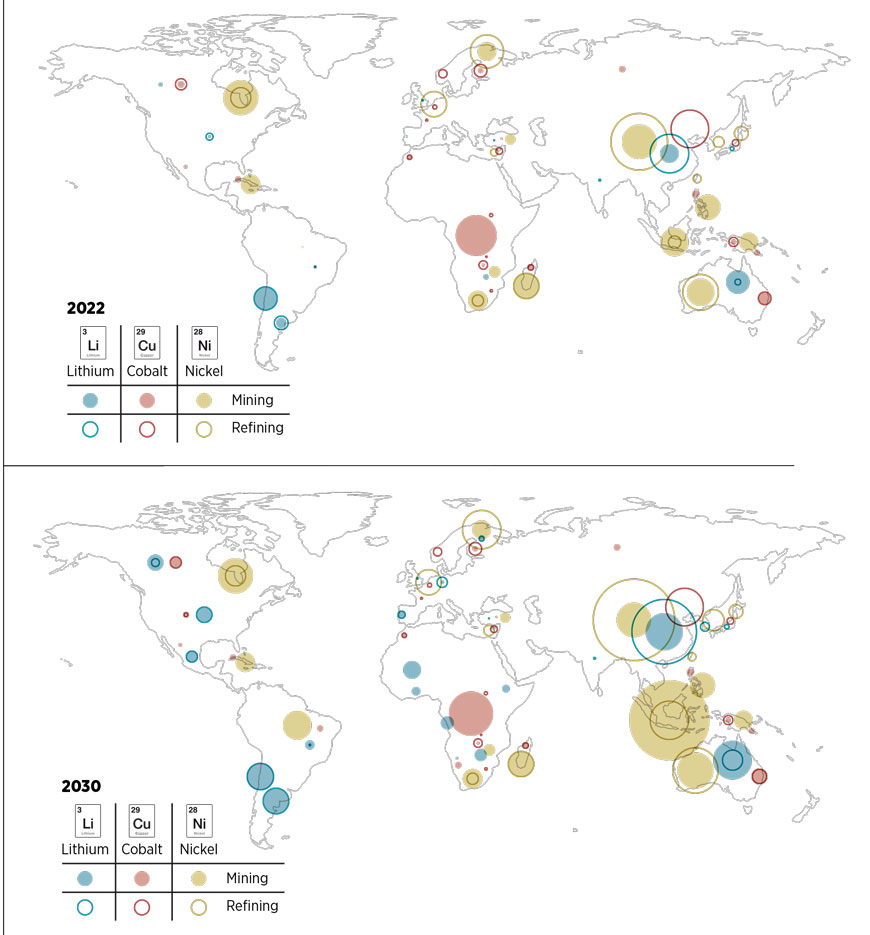
Disclaimer: These maps are provided for illustration purposes only. Boundaries and names shown on the maps do not imply any endorsement or acceptance by IRENA.
Innovations in technology can influence demand by introducing substitutes, enhancing efficiency, optimising designs and incorporating new materials. Disruptive innovation is adding to the uncertainty of future demand. For example, changes in electric vehicle battery chemistry over the past eight years have significantly reshaped the demand for specific materials. As new technologies continue to emerge, the market is likely to experience further shifts before eventually consolidating around a limited number of dominant materials and technologies. Consequently, predicting future demand for certain materials can be quite difficult, particularly in the long term.
Stockpiling of critical materials is not a robust solution for mitigating supply risks. Critical materials are indispensable for manufacturing and constructing energy assets. This brings into question the efficacy of stockpiling transition minerals for the energy sector compared to other sectors, such as defence. If not handled judiciously, stockpiling can exacerbate market limitations, drive up prices, and lead to an uneven energy transition that excludes poorer countries and delays climate action.
Critical material reserves are widely distributed, opening opportunities to diversify the mining and processing of materials. Developing countries currently account for much of the global production of the materials needed for the energy transition, and their share in reserves is even greater, but not fully explored (Figure S6). For example, Bolivia has 21 million tonnes of lithium reserves - more than any other country - but it produced less than 1% of world supply in 2021. Countries can utilise their mineral resources to draw in industries involved in the middle stages of production (processing) or even in the end stages (battery and electric vehicle manufacturing).
FIGURE S6 Share of global exploration budget for materials by country, 2012 and 2022
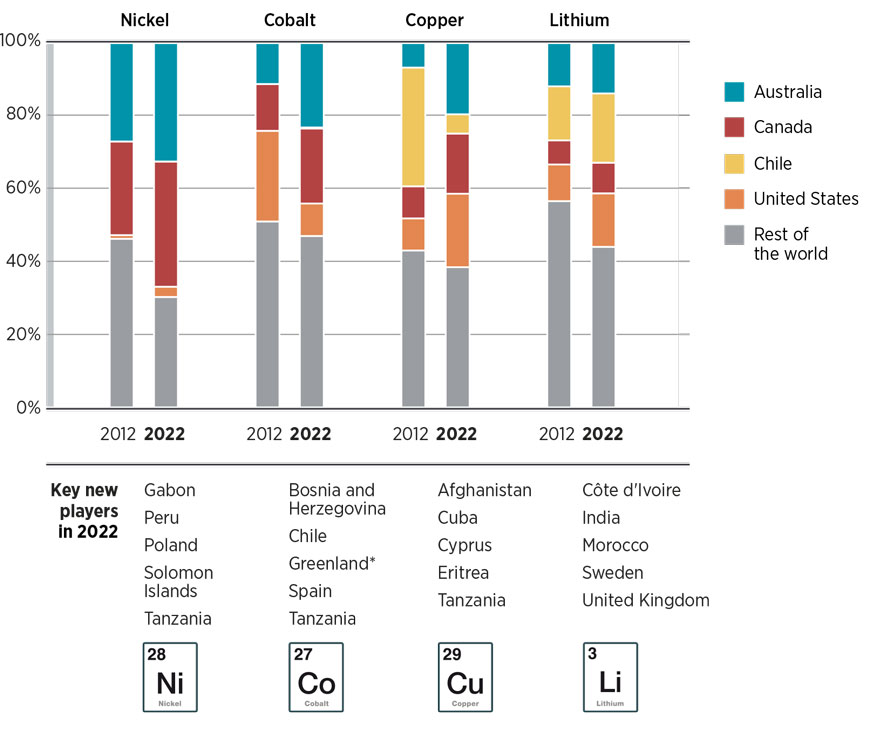
Based on: (S&P, 2023).
An estimated 54% of energy transition minerals are located on or near indigenous peoples’ land, underscoring the need for robust and early community engagement. Over 80% of lithium projects and more than half of nickel, copper and zinc projects are located in the territories of indigenous peoples. More than a third of mineral projects relevant to the energy transition are on, or near, indigenous territory or farmers’ land that faces a combination of water risk, conflict and food insecurity. Over 90% of platinum reserves and resources, for example, are on, or near, indigenous peoples’ or rural land facing these three risks, followed by molybdenum (76%) and graphite (74%).
The pursuit of critical materials could spark geopolitical competition in areas known to contain significant deposits, such as the Arctic, outer space and the deep sea. The Arctic is known to have vast reserves of critical materials such as nickel, zinc and rare earths, and the region’s mineral abundance contributes to its strategic importance. Given the presence of ample terrestrial reserves, a cautious approach is warranted in the case of outer space and the deep sea, due to uncertainties surrounding potential environmental impacts and regulatory frameworks.
Helping developing countries to realise new opportunities in supply chains could improve resilience while narrowing the global decarbonisation divide. A key question is whether the energy transition supports developing countries to not just increase their exports of primary ores but to also move up the value chain and attract higher-margin activities such as mineral processing. Processed materials like steel and alumina do not just command significant price premia over unrefined ores; they also reduce the input cost of infrastructural and industrial projects, spurring local economic development.
Regional co-operation could help countries capture a greater share of the value of producing minerals. Rather than pursuing one-on-one deals with - often - foreign companies, co-ordinated regional approaches could be more effective in ensuring that conditions attached to foreign investment are favourable for mineralrich countries. Co-ordination across regions is also important, as most countries would benefit from pooling respective mineral supplies if they intend to build downstream industries.
The patchwork of international and transnational initiatives requires greater coherence to bring about more responsible, sustainable and transparent supply chains. The growing recognition of challenges associated with the critical materials supply chain has spurred the development of an array of initiatives and regulatory frameworks by governments, businesses and civil society groups. Most of these are voluntary. The result is a patchwork of standards that risks sowing confusion for stakeholders and highlights the need for greater visibility and coherence.
A renewables-based energy transition, if well-planned and executed, can rewrite the legacy of extractive industries. As has been the case with extractive industries for centuries - and even with today’s awareness and standards - mining activities and processes carry risks for local communities such as labour and other human rights abuses, land degradation, water resource depletion and contamination, and air pollution. Stronger international co-operation to raise and enforce standards and longer-term corporate views will be essential for sustainable development and social license.
1.1 Critical materials and the energy transition
Demand for critical materials is projected to grow rapidly with the renewables-based energy transition. IRENA’s 1.5°C Scenario posits that renewables will constitute 91% of the energy mix by 2050, a shift that would increase renewables-based installed capacity from 3 300 gigawatts (GW) in 2022 to 33 000 GW in 2050. Under this scenario, 90% of all road vehicles will be electric by 2050 and hydrogen will account for 14% of total final energy consumption. These shifts would require annual tripling of new renewables, to an average deployment of 1 000 GW (IRENA, 2022a, 2023a).
Such a buildout of clean energy technology and infrastructure will greatly increase demand for certain minerals and metals, grouped in this report under the term “critical materials”. Critical materials are today the focus of much international dialogue and diplomacy. Their production and processing are highly concentrated geographically, posing challenges related to resource security and geopolitical dynamics. Strategies to diversify the supply and production chains for these materials are starting to emerge, reflecting multiple economic, political and social considerations.
Presently there is no universally accepted definition of critical materials (Figure 1.1). The factors for determining criticality remain subjective and location-specific. Core criteria typically include economic importance (for a specific economy of interest) and level of supply risk, as influenced by factors such as scarcity and proximity of supply, complexity of extraction and refining processes, concentration of supply across different parts of the value chain, and lack of viable substitutes (IRENA, 2022a).
For the purposes of this report, “critical materials” refers to minerals and metals generally viewed as highly important as inputs for a renewables-based energy transition, including but not limited to cobalt, copper, graphite, iridium, lithium, manganese, nickel, platinum, and selected rare earth elements. Various other materials are mentioned in this report in reference to real-world energy technology as well as policy examples and case studies with geopolitical relevance.
FIGURE 1.1 Energy transition materials defined as critical by countries and regions (35 lists, 51 materials), 2023
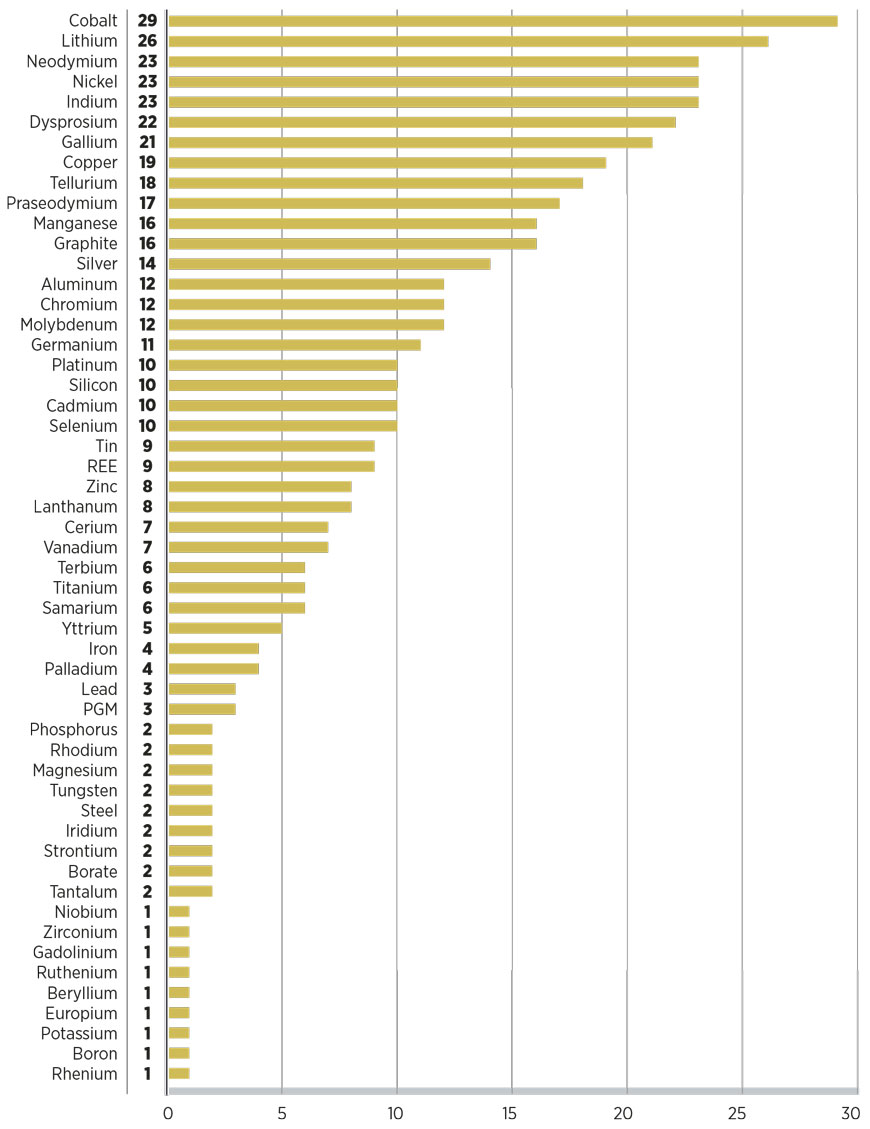
Notes: REE = rare earth elements; PGM = platinum group metals.
Critical materials are valuable commodities, but their economic value is not as significant as that of fossil fuels, which today account for 2% of global GDP (IRENA, 2022b). With the exception of copper, the most valuable base metal in terms of market size, the value of trade flows for other minerals and metals is many orders of magnitude smaller than oil and gas markets (see Figure 1.2). The sector will grow in coming years, but volumes and values will not be comparable to fossil fuels today.
With supply bottleneck risks and long development cycles for mining projects, a prominent concern is that the renewables-based energy transition will entail trading the dependency on imported fossil fuels for dependency on imported critical materials. However, the dependency risks and supply dynamics of critical materials differ fundamentally from those pertaining to fossil fuels. Fossil fuels are consumables primarily used for energy production, whereas critical materials are essential inputs for energy transition components, equipment and devices.
FIGURE 1.2 Value of exports for selected commodities (2021)
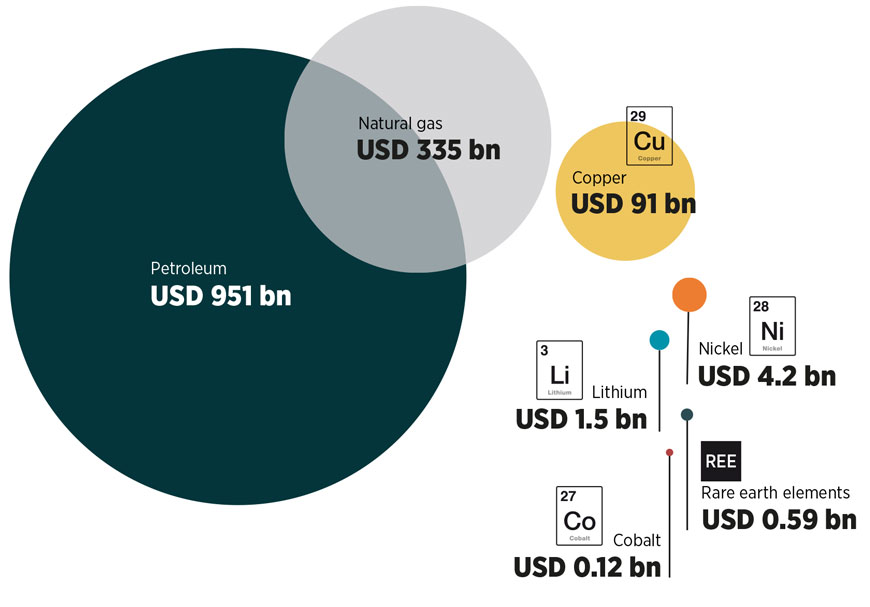
Note: Numbers represent trade in raw, unprocessed fuels and ores only.
In case of a supply disruption, the operation of energy infrastructure and machinery that run on coal, gas or oil would come to a halt. Such disruptions would have an immediate impact on consumers and households, triggering a gamut of social, political and financial challenges. In contrast, disruptions in critical materials would not have an impact on the existing energy infrastructure and equipment, though they would potentially slow the speed and increase the cost of decarbonisation. The risk of disruptions in the supply of critical materials is therefore less an energy security risk than a risk to the speed of the energy transition (see Figure 1.3).
FIGURE 1.3 Critical materials are fundamentally different from fossil fuels
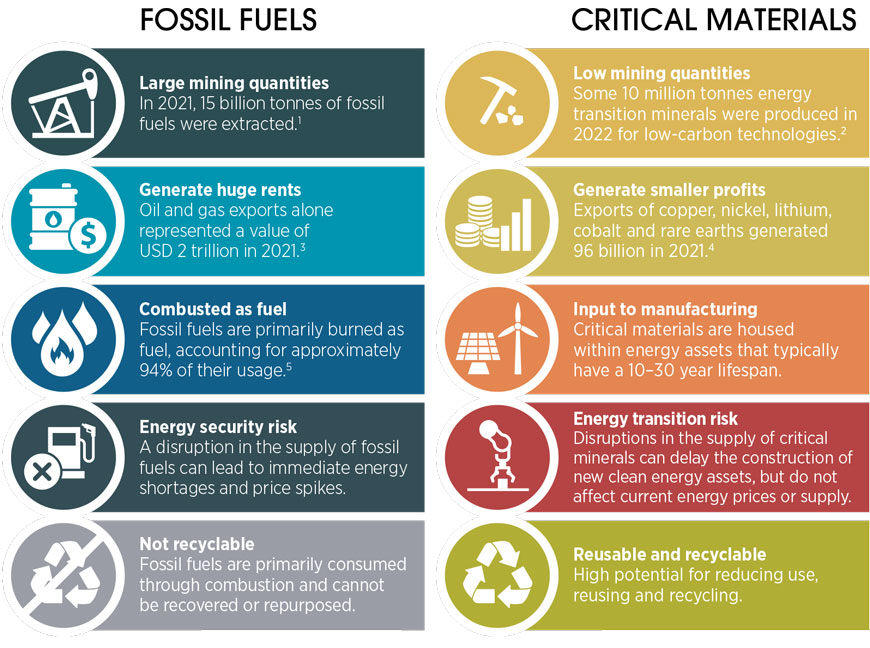
IRENA expects the technical evolution of critical materials to be shaped by three shifting and overlapping dynamics. The first dynamic, most dominant in the short to medium term, will be marked by physical constraints and challenges in keeping up with rising demand for certain critical materials. The second – which is already occurring at scale – will bring disruptive innovation, with new ideas and experiments to reduce materials consumption. The third dynamic – still nascent – will usher in a larger role for circular economy, including more advanced and widely adopted methods of reducing, reusing and recycling critical materials.
FIGURE 1.4 Three dynamics of critical materials development for energy transition

1.2 Physical constraints
Potential undersupply in the short to medium term is a result of the lack of investment in upstream activities. This is due to numerous factors including long lead times in opening new mines and processing of manufacturing plants, uncertainty regarding future demand, price volatility, a lack of downstream transparency, and local opposition, among others (IRENA, forthcoming). Moreover, the mining and processing of critical materials are heavily concentrated in a handful of countries (see Chapter 2).
Market demand for critical materials in 2022 predominantly originated from non-energy transition uses, except for lithium. For example, over 90% of nickel was used in iron and steel production; over 80% of graphite was used for steel, aluminium and ceramics; and over 80% of manganese was used in steel and chemical production, and foundry and welding (IRENA, forthcoming). However, energy transition technologies are increasingly requiring critical materials, and may exceed the demand from non-energy uses in some cases (IRENA, forthcoming). This trend is especially notable for lithium, cobalt, graphite and dysprosium. IRENA’s short-term scarcity ratio (see Figure 1.5) compares the supply of materials in 2022 with the demand expected in 2030. 1
FIGURE 1.5 Assessing disparity between current supply and anticipated demand in 2030 for selected materials*
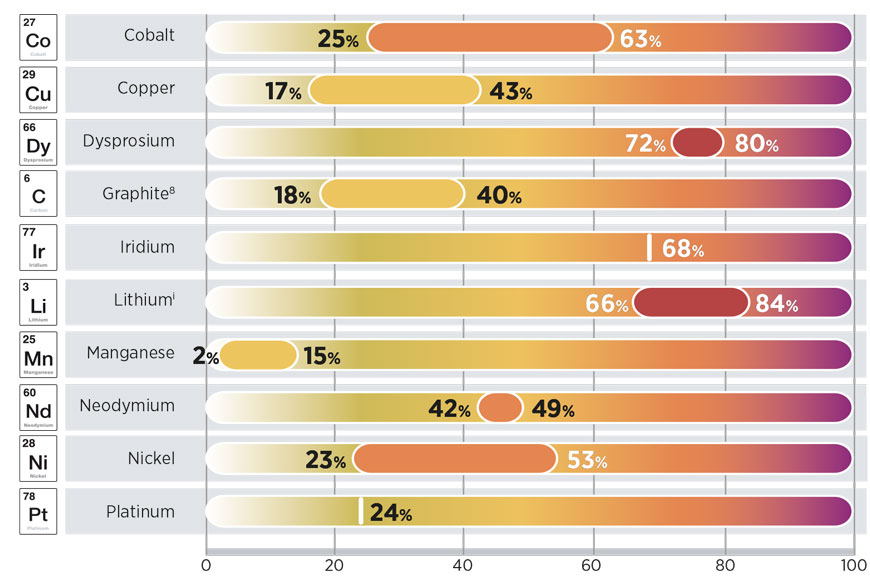
Note: *A short-term scarcity ratio compares the mine production of selected material in 2022 with the demand expected in 2030; see Annex for calculation methodology.
To avoid a demand-supply gap for materials with a high scarcity ratio, increasing the mining and processing capacities is essential. There is no scarcity of geological reserves and they are geographically widespread. As the focus on critical materials increases, so are new discoveries. For instance, Norge Mining recently announced that the phosphate, titanium and vanadium deposits found in Norway could supply the current global demand for at least 50 years (The Economist, 8 June 2023).
Apart from boosting mining and processing, bridging the gap requires improving material recovery from tailings and recycling technologies. Such advancements require government investment in infrastructure, the design of enabling legal frameworks, including mandates through public policy, and research and innovation in recycling technologies.
1.3 Disruptive innovation
Technological innovation affects the demand for materials through factors such as substitution, efficiency improvement, design optimisation and the introduction of new materials. There are multiple uncertainties in projecting and assessing the demand-supply gap for critical materials in energy transition technologies. A prime example is electric vehicle (EV) batteries. Significant shifts in the EV battery chemistry mix occurred since 2015 (Figure 1.6).
FIGURE 1.6 Rapidly changing global EV battery chemistry mix between 2015 to 2022
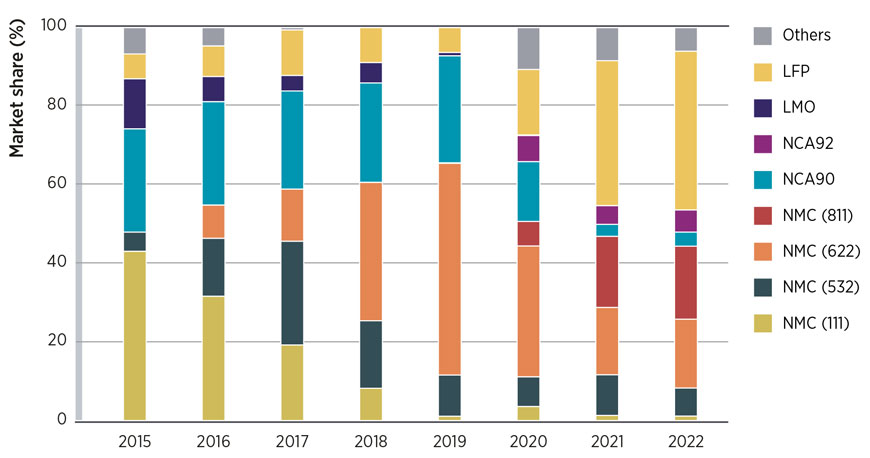
Note: The numbers following NCA indicate nickel's proportion in the NCA battery chemistry, whereas the numbers following NMC indicate nickel's proportion in the NMC battery chemistry; for example, NMC (622) means 6 parts of nickel, 2 parts of manganese and 2 parts of cobalt. LFP = lithium iron phosphate; LMO = lithium manganese oxide; NCA = nickel cobalt and aluminium; NMC = nickel manganese and cobalt.
Today, the EV battery industry is dominated by lithium-ion batteries, a technology that has undergone multiple advancements in key components that significantly influence material demand. Graphite-based anode chemistry holds a 70% market share due to its high performance. However, emerging anode chemistries, such as 100% silicon-based anodes, lithium metal anodes and aluminium or aluminium alloy anodes, have the potential to reduce or eliminate the demand for graphite, depending on the speed of research and development (IRENA, forthcoming). For cathodes, the most commonly used chemistries include nickel manganese cobalt oxides (NMC), nickel cobalt aluminium oxides (NCA) and lithium iron phosphate (LFP). NMC and LFP are expected to remain the most prevalent batteries in this decade, although which technology will ultimately prevail remains a question (see Box 1.1). Emerging battery technologies, such as sodium-ion batteries, have the potential to disrupt the EV battery market by replacing critical materials such as lithium and cobalt with less expensive or more abundant options, such as sodium (IRENA, forthcoming).
BOX 1.1 Uncertainties in projecting the demand and supply gap for critical materials: The example of electric vehicle batteries
Lithium iron phosphate (LFP) batteries emerged in the 1990s from the laboratory of John Goodenough, who had won the Nobel Prize for lithium-ion batteries, at the University of Texas–Austin. Several start-ups (e.g. A123 Systems) saw an opportunity to shift away from cobalt and nickel, but LFP’s lower energy density did not draw the interest of automakers such as Tesla and General Motors causing start-ups like A123 Systems to go bankrupt. (McFarland, 2022). However, later, as cobalt and nickel became significantly more expensive, automakers began exploring battery chemistries with fewer critical materials. LFP batteries started to replace nickel manganese cobalt (NMC) batteries in entry-level, inexpensive vehicles, while NMC remained the chemistry of choice for high-performance vehicles. As an indication of this change, the market share of LFP batteries grew significantly from a single digit in 2015 to 40% in 2022 (BNEF, 2022a).
Rapid expansion of LFP, however, cannot be linked solely to innovation. China is the key market for LFP batteries, where they are used in over 40% of EVs, compared to 6% in Europe and 3% in the United States and Canada (BMI, 2022). China’s preference for LFP results from uncertainties regarding the availability of cobalt and nickel at affordable prices. China thus concluded a long-term agreement between the patent owners – a consortium of universities in the United States (University of Texas–Austin and MIT) and Canada (University of Montreal and CNRS) – and Chinese battery manufacturers, BYD and CATL. The agreement lifted license fees if LFP batteries were used exclusively in China (IRENA, forthcoming). These patents expired in 2022.
Rare earth elements, namely, neodymium and dysprosium, are ubiquitously used for permanent magnets in electric generators (i.e. wind energy) and electric motors (i.e. EVs). Rare earth permanent magnets are used for onshore as well as offshore wind applications, and are likely to become more common in turbines. However, significant efforts are being made to replace neodymium with other rare earth elements, including praseodymium, dysprosium and terbium, or to develop rare earth free permanent magnets (electromagnets). This could potentially change the demand outlook for neodymium and dysprosium (Gielen et al., 2022a).
Similarly, innovation in solar photovoltaic technology may alter the demand for raw materials, prompting a shift away from silicon in conventional crystalline silicon and less-efficient thin-film solar power technologies. For instance, perovskite solar cells have garnered increased research and development focus, resulting in rapid efficiency improvements over their crystalline silicon counterparts (up to 25%) (Wu et al., 2021). Other promising technologies include organic solar cells, copper indium gallium selenide cells, dye-sensitised solar cells and quantum dot solar cells. Even though these technologies hold significant potential, they are still in the process of being developed and commercialised, and their performance, durability and cost-effectiveness are still being studied and improved upon.
TABLE 1.1 Selected energy-related technology applications, 2023
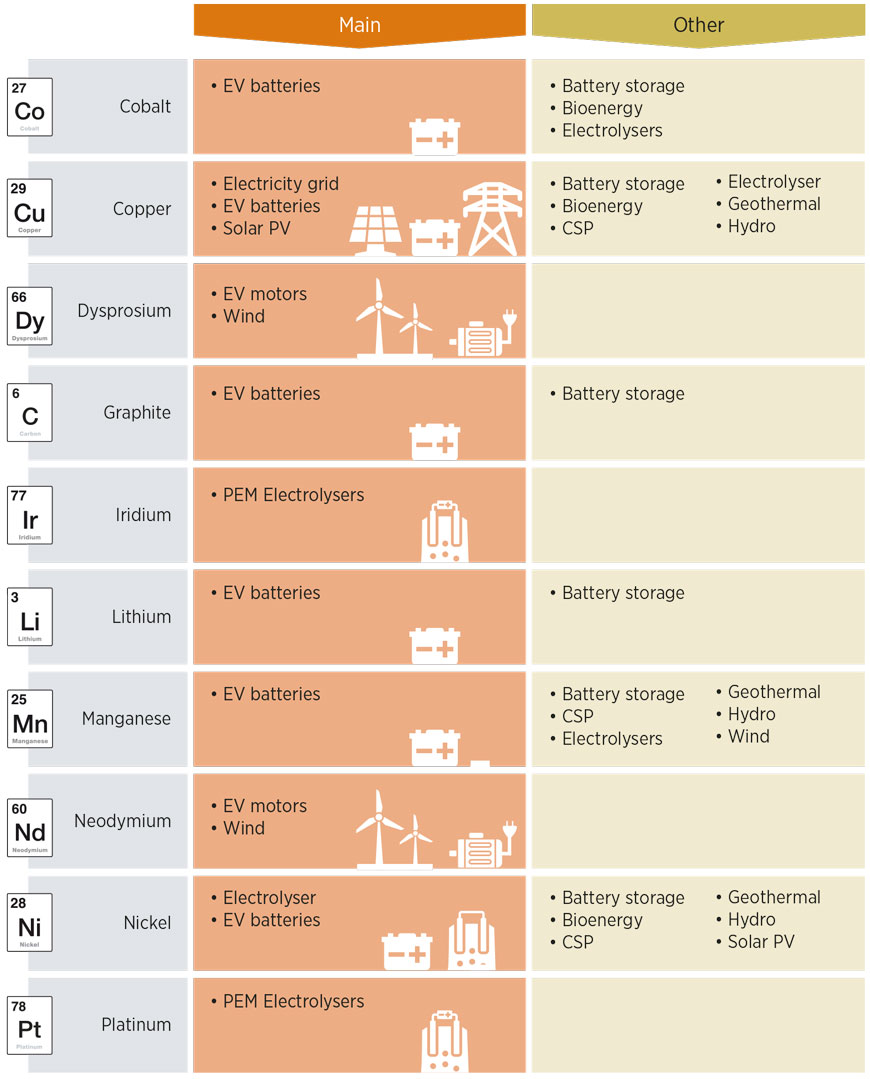
1.4 Report scope
This report expands on the above providing a forward-looking examination of geopolitical and geoeconomic considerations and implications of the anticipated scale-up of demand and supply of critical materials. It builds on IRENA’s work to date and analyses the evolving landscape of supply chains and trade patterns, the socioeconomic and sustainability considerations surrounding extraction and processing around the globe, and the strategic importance of critical materials for economic competitiveness and the speed of a renewables-based energy transition.
Chapter 2 examines the geopolitical themes of trade, security, and interdependence. These have always been closely connected with extractive industries in a broad sense, and will remain so with the scale-up of materials critical to the energy transition.
Considerations around sustainability, communities and livelihoods are the focus of Chapter 3, reviewed under the broader term of human security. The chapter sharpens lines of connection between extractive industries and implications for the social economy, environment, and climate in exporting countries, their neighbours and, ultimately, the world.
Chapter 4 shifts the focus from diagnosis to strategic responses and policy considerations. This closing chapter does not provide a universal set of recommendations, but rather reviews the main strains of policy approaches to the challenges and opportunities presented by the scale-up of critical materials for the energy transition.
Highlights
- The mining of critical materials is highly concentrated in specific geographical locations. Australia (lithium), Chile (copper and lithium), China (graphite, rare earths), the Democratic Republic of Congo (cobalt), Indonesia (nickel) and South Africa (platinum, iridium) are the dominant players. Processing is even more geographically concentrated, with China accounting for more than 50% of the world’s refined supply of (natural) graphite, dysprosium (a rare earth), cobalt, lithium and manganese.
- Reserves are distributed relatively evenly, presenting opportunities to diversify supply chains in the long run. One solution would be increased investment in exploration, especially in underexplored regions such as Africa. International collaboration in conducting geological surveys could help these regions attract exploration investments.
- Trade in critical materials is many orders of magnitude smaller by value than trade in fossil fuels. Unlike oil, most critical materials are not widely traded on exchanges. While this limits opportunities to hedge against price volatility, it allows commodity traders to play a key role in matching producers and consumers.
- Each material has a unique trade geography, which, when viewed collectively, interconnects multiple countries in a wider network of interdependence. No country can insulate itself fully from the risks of price shocks or supply disruptions related to critical materials, since these factors may adversely affect the cost and pace of the energy transition.
- The availability of materials is influenced by several structural conditions, including the geographical concentration of mining and processing, decline in mineral ore grades, the limited extent of end-of-life recycling, the dependence on by-product production for many critical materials and the limited short-term substitution possibilities for certain materials.
- Six geopolitical risks to the supply of materials in the short to medium term are identified and assessed: external shocks (e.g. war), resource nationalism (e.g. expropriation), export restrictions (e.g. export bans), mineral cartels (e.g. co-ordination of production), political instability (e.g. social unrest) and market manipulation (e.g. short squeezing).
- The pursuit for critical materials could spark geopolitical competition in areas known to contain significant deposits, such as the Arctic, outer space and the deep sea. However, a cautious approach is warranted in the case of outer space and the deep sea, due to uncertainties surrounding the environmental impact and regulatory frameworks, along with the presence of ample terrestrial reserves.
This chapter provides a comprehensive overview of the key players involved in the value chains of critical materials. In doing so, it highlights the high geographical concentration of supply but also the crucial role of the private sector and commodity traders. Moreover, it scrutinises prevailing trade trends and the corresponding supply risks and vulnerabilities, which encompass the potential perils associated with the weaponisation or cartelisation of supplies, as well as non-political disruptions, such as climate-related hazards and pandemics. Further, it highlights the intensifying geopolitical contestation for critical materials, especially within the global commons, including the exploration and extraction activities unfolding in the deep sea.
2.1 Key players in mineral and metal trading
The critical material supply chain
The pathway of minerals from mines to finished products involves a complex, and often opaque, network of actors and processes. 2 Figure 2.1 shows some of the key stages in the value chains of the mineral and metal industries.
FIGURE 2.1 Schematic representation of a mineral- or metal-dependent value chain
The geological presence of resources alone is not sufficient for undertaking mining projects and the actual mining of mineral ores is preceded by multiple stages. These require meeting several enabling conditions, including compliance with mining and environmental regulations, and the acquisition of necessary permits and licenses. After fulfilling legal requirements, mining companies undertake several steps before extracting resources from the ground. This includes assessing the resource base, conducting feasibility studies and, in some instances, constructing demonstration plants. These processes can take several years and involve significant costs.
Subsequently, the mining stage begins, where mineral ores are extracted from either open-pit or underground mines using drilling and/or blasting techniques. The extracted ores are then transported (typically on conveyors or trucks) to a nearby processing plant, where they are converted into shippable products through multiple steps, which vary depending on the raw material and may involve processes such as grinding, crushing and chemical processing. It is worth noting that while these processes are typical for larger-scale mining operations, artisanal and small-scale mining may employ more rudimentary methods, such as manual labour and simple tools. The involvement of traders in the purchase and transport of the refined minerals further underscores the complexity of the mineral supply chain.
The next stage is metallurgy or refining, which is crucial to remove residual impurities from metal to meet the purity requirements of different markets. This process involves various techniques, such as smelting, roasting and electrolysis, and can generate substantial waste and emissions. The final product from refining is sold to manufacturers, who use the metal in a wide range of areas, including electronics, batteries and construction material. Increasingly, there is a growing trend of recycling products, including certain waste products that are generated during their life cycles.
Geography of mineral mining and processing
The mining of materials is highly concentrated in specific geographical locations (Figure 2.2). For example, more than 70% of platinum is mined in South Africa; 70% of cobalt is mined in the Democratic Republic of Congo; more than 60% of natural graphite in China; almost 50% of nickel in Indonesia; almost 50% of lithium in Australia and almost 50% of dysprosium in China. Mineral processing is even more concentrated (Figure 2.3). China is the dominant player, with a 100% share of global refined supply for natural graphite and dysprosium (a rare earth element) over 90% for manganese, 70% for cobalt, almost 60% for lithium and approximately 40% for copper.
FIGURE 2.2 Key mining countries for select minerals
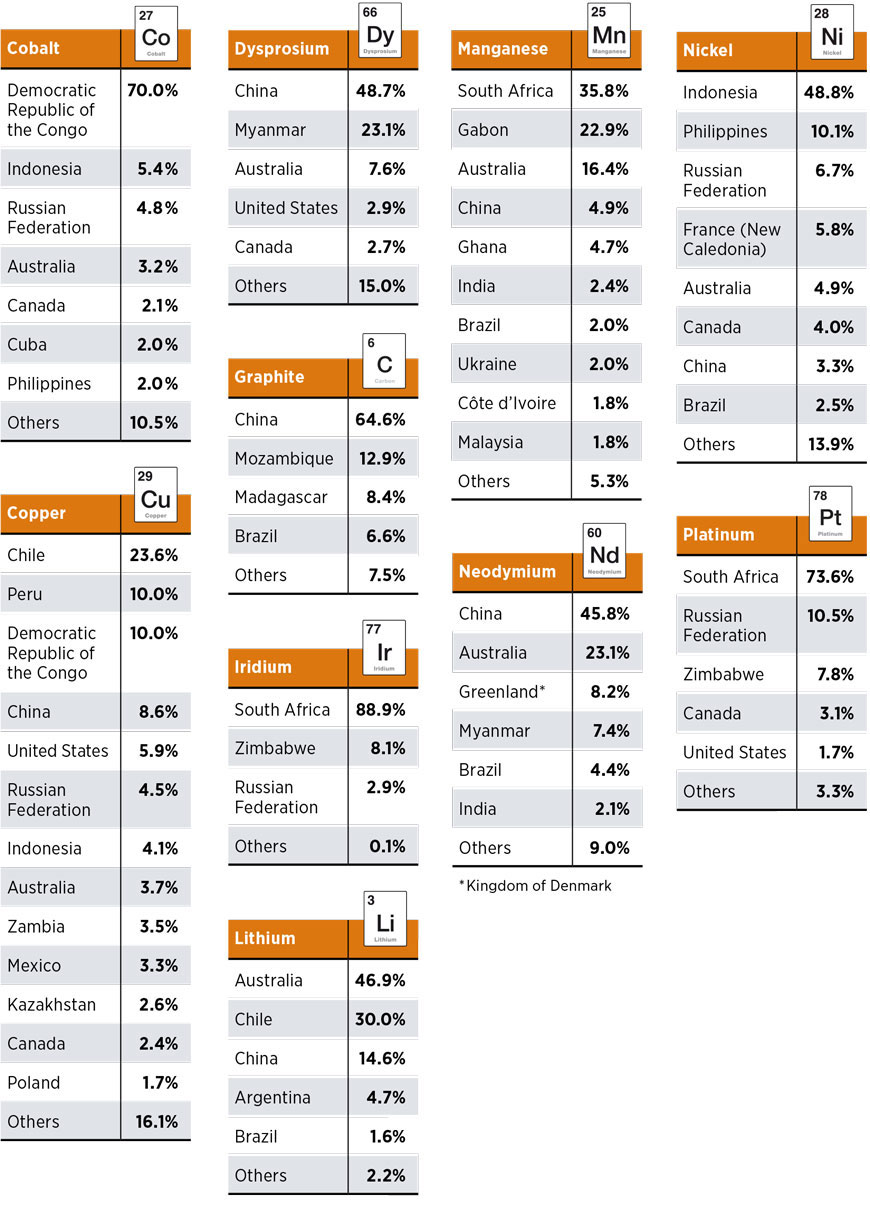
Source: (US Geological Survey and US Department of the Interior, 2023; JRC, 2020).
FIGURE 2.3 Key processing countries for selected minerals
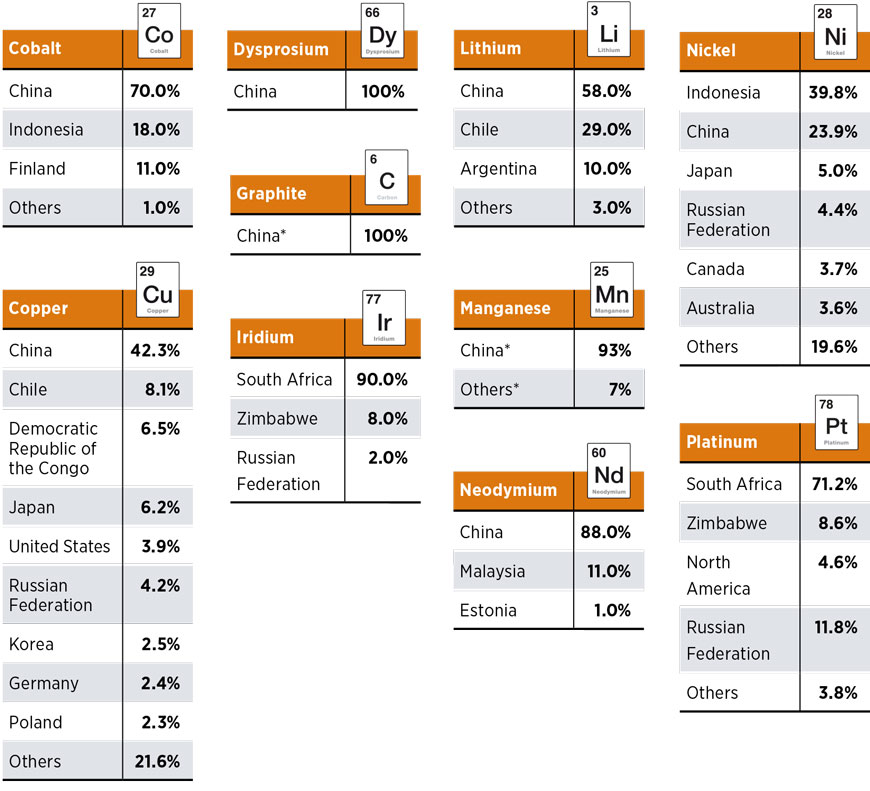
* latest data available as of 2023; America = Canada, Mexico and the United States; * 2021.
Any country’s dominance in metallurgy poses significant challenges for resource security and geopolitical dynamics. The envisaged increase in demand presents an opportunity to make the existing value chains more resilient, positively impact national balance sheet and support the global transition to a low-carbon economy (Figures 2.4 and 2.5). Mineral-rich countries stand to gain from the growing demand for critical materials. For example, the Australian government expects lithium and base metal exports to equal the value of its coal exports by 2027-2028 (The Hon Madeleine King MP Media Releases, 2023). Diversifying processing towards countries with abundant renewable energy sources can reduce the emission footprint. Countries such as Chile, which have abundant solar energy resources, are exploring the use of solar power to decarbonise copper refining (Lyng, 2022). Western Australia, a renewable energy hotspot, is attracting new investments in midstream critical mineral projects, including three rare earth and three lithium processing facilities (see Figure 2.4) (Government of Western Australia, 2022).
Global critical mineral reserves are relatively more evenly distributed than current mineral production. This opens opportunities for diversifying supply. Large parts of the Earth’s crust, predominantly in developing countries, remain unexplored. For instance, Africa, which has about 20% of the global land mass area, has attracted only about 14% of global mineral exploration investment (Ericsson and Olöf, 2019). Addressing this situation requires not just increasing global exploration spending (Box 2.1), but also continuous collection and sharing of mineral resource data across continents. At present, most of the work is undertaken by countries that are members of the Organisation for Economic Co-operation and Development (OECD). For example, the Australian, Canadian and US geological surveys jointly launched the Critical Minerals Mapping Initiative, which covers over 60 countries (Calam, 2020). Geological work in countries that are not members of the OECD could benefit from increased regional as well as global collaboration. An example is the African Union’s Africa Mining Vision, which was launched in 2009 and is being hindered from realising its full potential due to a lack of resources (Ushie, 2017).
FIGURE 2.4 Mining and refining supply for selected critical materials, 2022
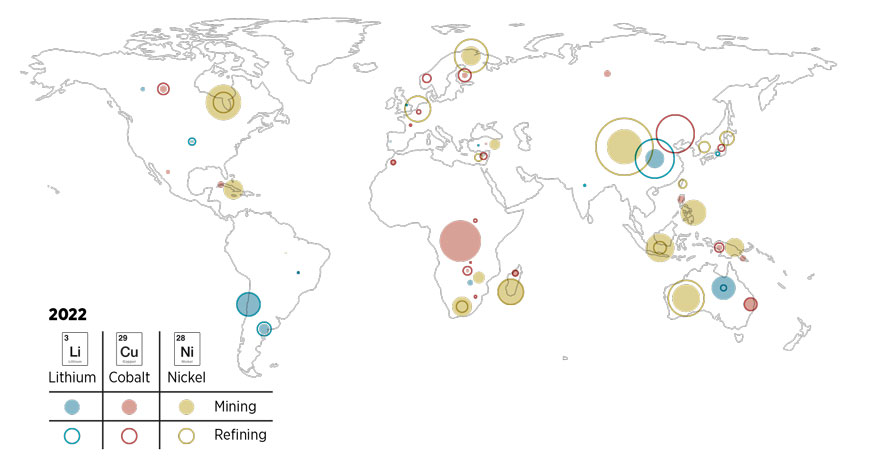
FIGURE 2.5 Mining and refining supply forecasts for selected critical materials, 2030
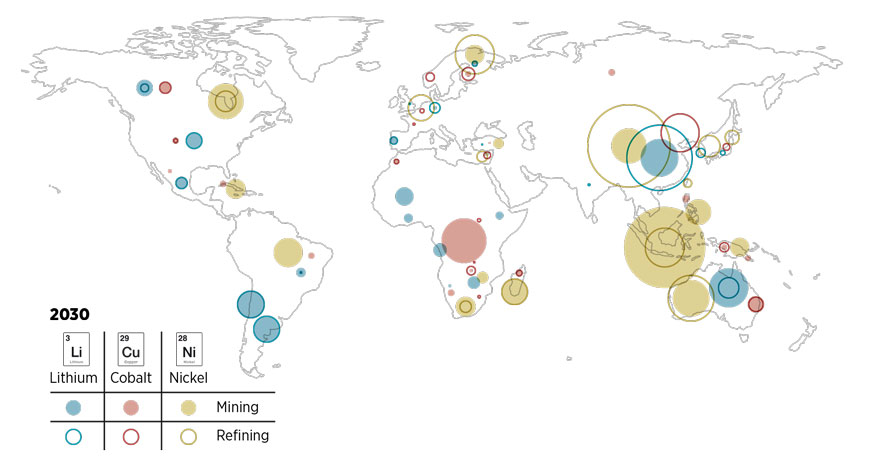
Disclaimer: These maps are provided for illustration purposes only. Boundaries and names shown on the maps do not imply any endorsement or acceptance by IRENA.
BOX 2.1 Mineral exploration budget
An exploration budget refers to the funds allocated to identifying potential mineral deposits in an area. Not all exploration projects result in a new mine, and even if they do, it takes several years from discovery to opening the mine.
A large majority of the exploration budget for selected minerals comes from countries of the OECD, dominated by Australia, Canada, Chile and the United States who increased their exploration budgets for nickel, cobalt, lithium and copper in the past ten years (Figure 2.6). China and Viet Nam increased their budgets for nickel; DR Congo, Morocco and Zambia increased their budget for cobalt; Peru, Germany and Zimbabwe increased their budgets for lithium; DR Congo and Ecuador increased their budgets for copper. South Africa dominates exploration budgets for platinum, with Zimbabwe increasing its budget in recent years.
FIGURE 2.6 Share of global exploration budget for select materials by country, 2012 and 2022
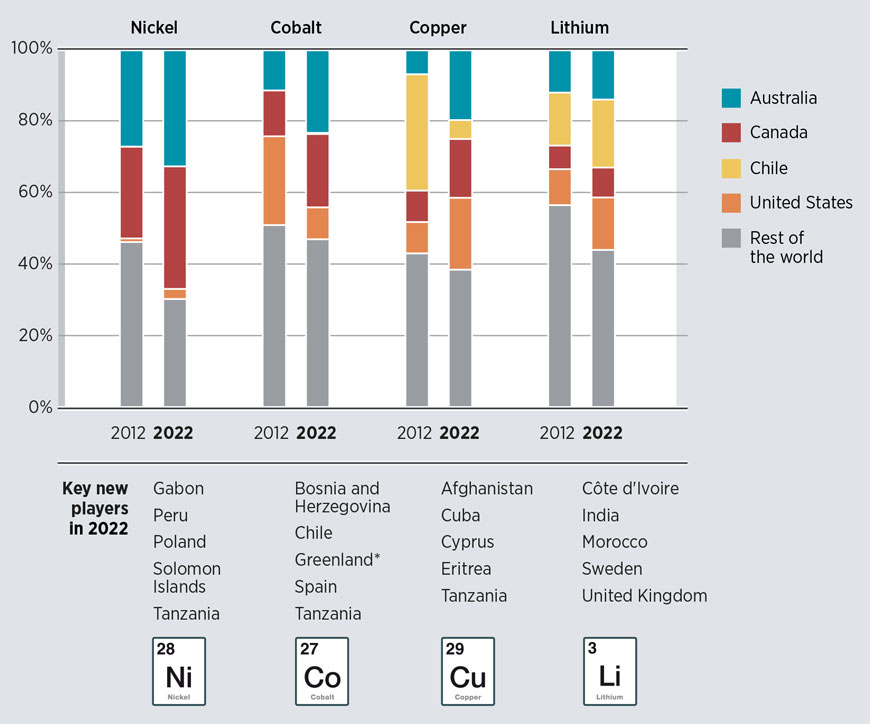
Based on: (S&P, 2023).
The mining sector does not sufficiently invest in exploration. Between 2012 and 2022, junior mining companies’ share of global exploration budgets grew from 31% to 56% for battery cathode materials (lithium, cobalt and nickel), while majors’ share shrunk from 52% to 34% in the same period. Governments’ share in exploration budgets was constant, at about 6% (Figure 2.7).
FIGURE 2.7 Share of global exploration budget for select materials by type of investment, 2012-2022
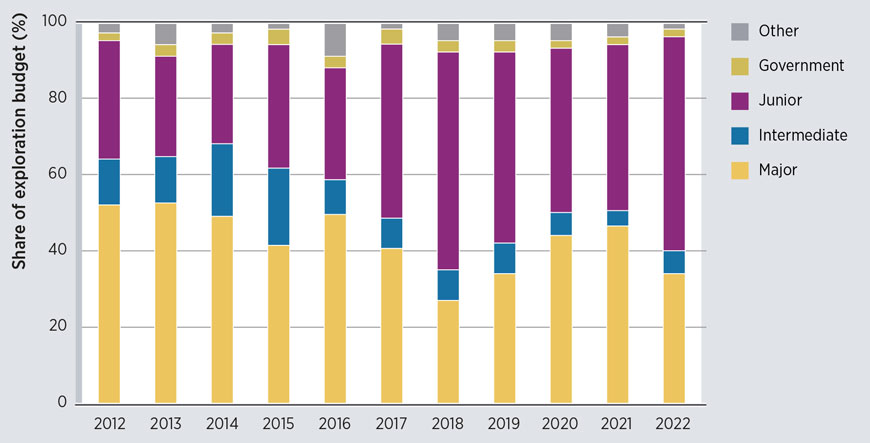
Based on: (S&P data, 2012-2022).
Industry players
The mining industry is dominated by a few large multinational corporations and state-owned/controlled enterprises (SOEs), which operate across multiple countries and possess the necessary resources and skills to develop complex mines. The industry is highly concentrated, with these corporations and SOEs controlling a significant portion of global production and trade. For example, the top five mining companies control 61% of lithium output and 56% of cobalt output (see Figure 2.8).
FIGURE 2.8 Market share of major mining companies in select materials, 2021
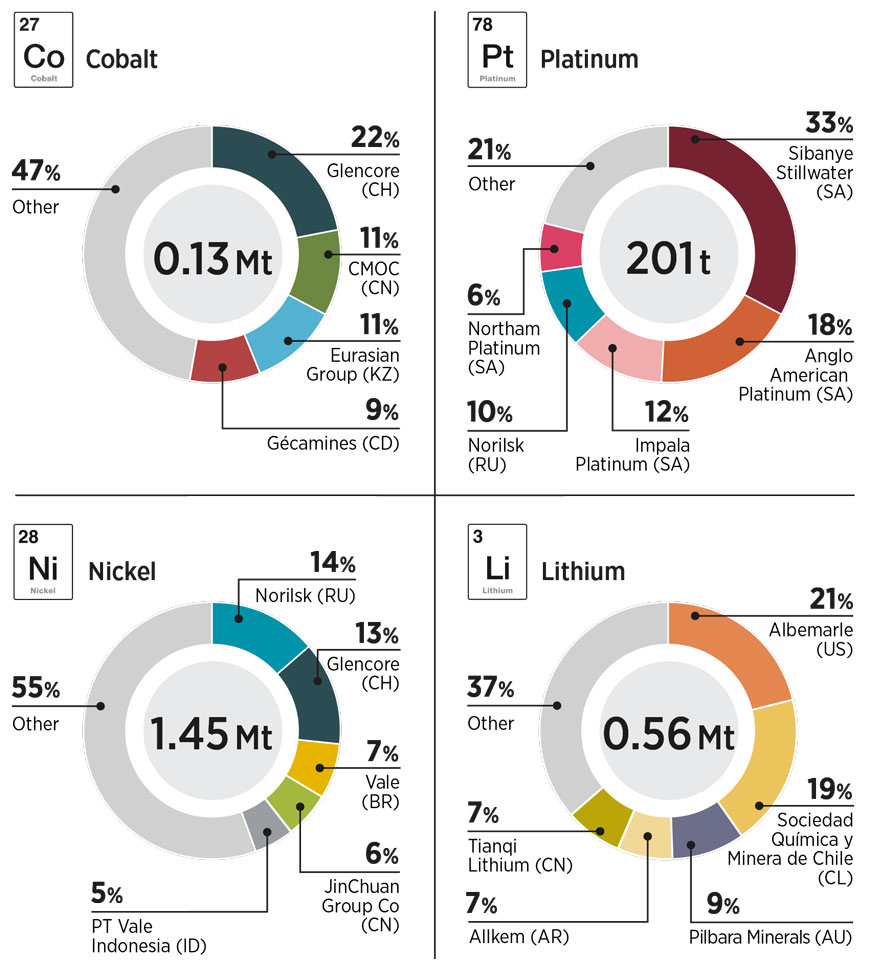
Note: a) Total global production in megatonnes (Mt) and tonnes (t) provided for each mineral. b) AR=Argentina; AU=Australia; BR = Brazil; CD=Democratic Republic of the Congo; CH=Switzerland; CL=Chile; CN=China; ID=Indonesia; KZ=Kazakhstan; RU=Russian Federation; SA = South Africa; US=United States of America.
The ownership structure of a mining company can impact its risk tolerance and the environments in which it operates. SOEs may be more willing to invest in riskier environments that publicly listed companies may avoid. A notable example of this are Chinese SOEs, which have a significant presence in Africa’s mining industry, including in countries where risks, real or perceived, may deter other investors (Ayuk et al., 2020).
Some of the largest companies in the mineral and metal industry value chain are vertically integrated, meaning they operate across multiple stages of the value chain (e.g. BHP, Rio Tinto and Freeport-McMoRan). Other companies specialise in specific stages. For instance, some specialise in mineral extraction but do not have the facilities to process or refine them. Other companies specialise in refining raw materials into metals but do not have the facilities to mine or process minerals. Many recycling companies specialise in collecting and processing specific types of waste materials rather than operating across the other parts of value chains.
The energy transition is changing corporate strategies and value chains in the mining industry. For instance, BHP, the world’s largest mining company by market capitalisation, is divesting its oil and gas business and positioning itself as a mining company focused on the energy transition (Quiggin, 2021). The growing demand for critical materials is also attracting companies from outside of the traditional mining industry. Tesla, an EV manufacturer, is building a lithium refinery in Texas and is looking to expand its footprint in the minerals mining and processing business (Agatie, 2023). Some mining companies are keen to invest in new businesses linked to the energy transition. For example, the Fortescue Metals Group has created a new unit to invest in renewables, green hydrogen and green ammonia.
Metal exchanges
Unlike commodities such as oil, many transition metals and minerals are not widely traded on exchanges. Copper is an exception and is widely traded in spot and futures markets. Other specialty commodities, such as cobalt, lithium and rare earths, are primarily sold through negotiated bilateral contracts between producers and consumers (World Bank, 2022). The low liquidity and product heterogeneity of certain metals pose challenges to the development of effective hedging tools (Azevedo et al., 2018).
Selected exchanges for minerals and metals have been created. An example of this is the London Metals Exchange (LME), which was set up in 1877 by merchants and financiers to facilitate international metal trading. Given that metals took three months to arrive from Chile (copper) and Malaysia (tin), the three-month contract became the primary traded futures contract on the LME (Buchan and Errington, 2018).
Today, the LME remains the world’s foremost metal trading platform, setting global reference prices for critical materials such as copper, nickel and cobalt. 3 The LME platform facilitates the daily trading of more than USD 60 billion in futures (Burton, 2022), and the range of metals and minerals traded on the exchange continues to be expanded (Table 2.1). For example, the LME began trading copper in 1877, followed by nickel in 1979, cobalt in 2010 and lithium in 2021 (Table 2.2) (LME, 2023).
TABLE 2.1 Key materials and year of introduction on the London Metals Exchange
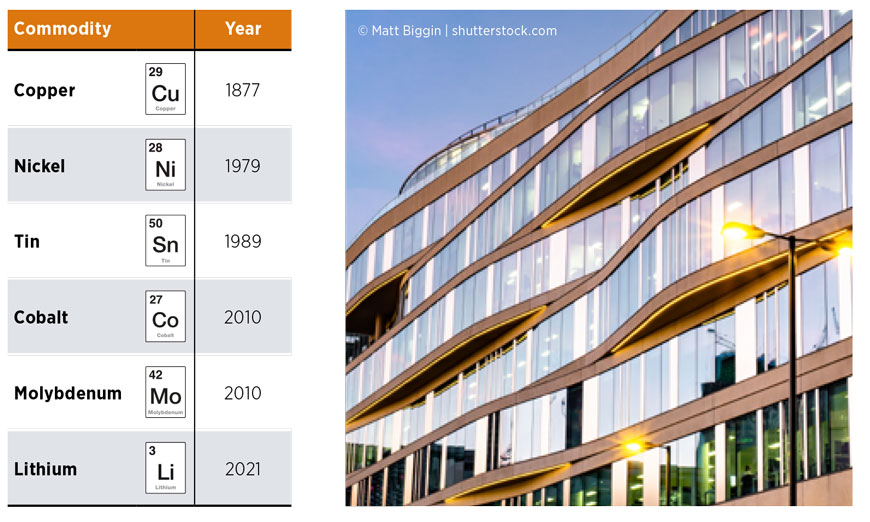
Commodity futures and derivatives are also traded on other, smaller exchanges, including the Shanghai Futures Exchange and the Dubai Gold and Commodities Exchange. Cobalt and lithium contracts were introduced recently on metal exchanges but have not yet received wide acceptance as hedging tools by industry participants. This situation presents a challenge for companies seeking to hedge their exposure to these critical metals, for instance, car manufacturers that want to lock in lithium prices (Sanderson, 2021).
Metal exchanges play a crucial role in price signalling. It is easy to access unambiguous price information for metals traded widely on exchanges. By contrast, it is difficult to ascertain the actual agreed-upon price for metals that are often traded directly between parties and not traded widely on exchanges. While some companies specialise in posting price listings, they rely on buyers and sellers voluntarily disclosing their prices, which may not always be timely or reliable. This situation gives trading companies a significant advantage as they have access to metals’ true market prices as well as transaction-related information.
Commodity traders
Independent traders have a key role to play given the fragmented nature of some mineral markets and the remoteness of some producers (Table 2.2). Apart from companies that trade physical commodities, metals markets have often attracted significant attention from investors, including hedge funds, investment banks and commodity index funds (Humphreys, 2011). These traders and speculators often do not produce or use commodities as such but play a role in matching producers and consumers in different parts of the market. In recent years, commodity traders have faced calls for greater oversight and regulation (Blas, 2022).
TABLE 2.2 Top commodity trading houses by revenue
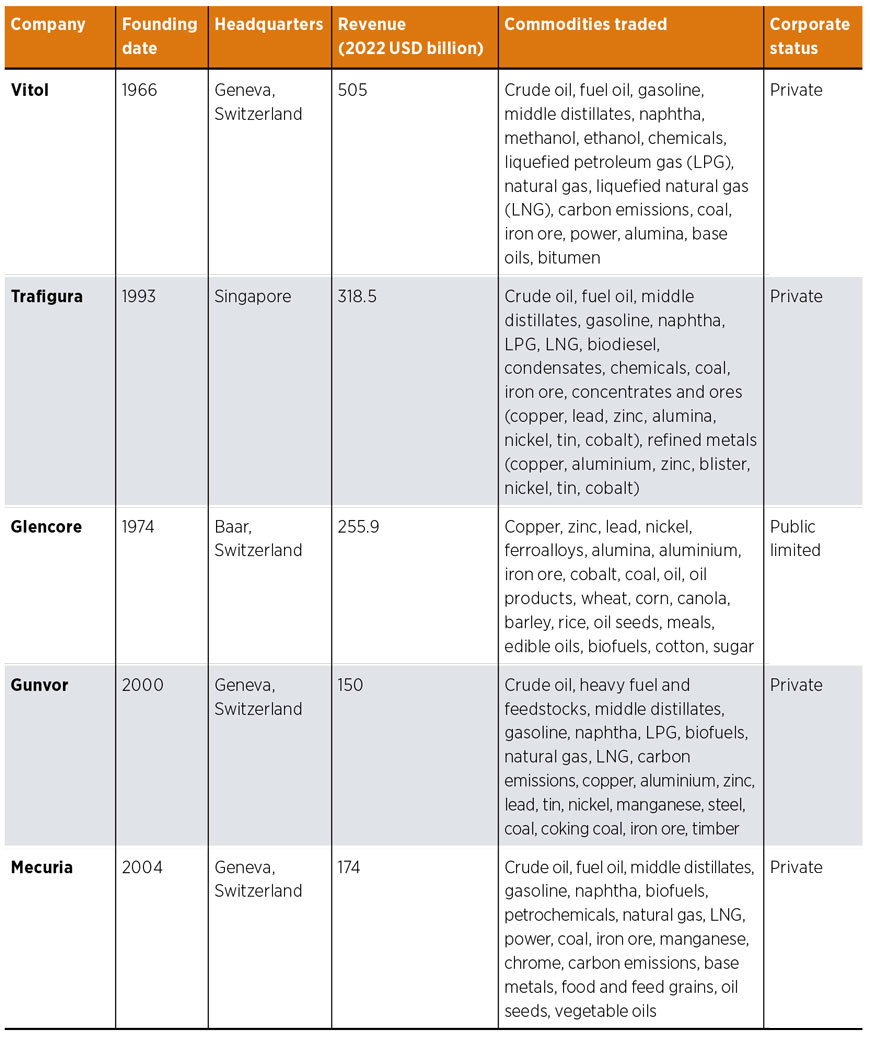
Note: Glencore was founded as Marc Rich and Co. AG.
Trade dependencies
This section presents an analysis of the bilateral trade flows related to critical materials. Figure 2.9 shows the top bilateral trade flows by value for five critical materials in 2022: copper, lithium, manganese, nickel and platinum. It shows how copper is the most valuable material by trade value. The graph also demonstrates the geographic diversity of mining countries, but also how important mining is to several, relatively small economies such as Chile and Peru.
Finally, the data indicates that China is among the top importers, even though it is commonly perceived as dominating critical material supply chains. It is the world’s largest importer of raw or unprocessed nickel, copper, lithium, cobalt and rare earths. As such, the country relies on imports for inputs but dominates large portions of the midstream and downstream capacity for many critical materials.
Three caveats must be considered when examining trade dependencies (Nassar et al., 2015). First, in trade statistics, import transactions are at times attributed only to the country of last shipment rather than the country where the material was originally mined or produced. Second, mineral commodities sourced from a different country can be embedded in imported finished and semi-finished products, thus obscuring the true import reliance and exposure to foreign supply disruptions. For example, neodymium and other rare metals are embedded in permanent magnets; any country importing these magnets would still be vulnerable to disruptions in rare earth supply. Third, foreign firms can own and control mineral assets and operations partially or completely. Chinese firms, for instance, have equity stakes in lithium projects in Australia and Chile, a rare earth deposit in Greenland 4 and cobalt operations in the Democratic Republic of Congo, Papua New Guinea and Zambia. Research found a 2% to 14% increase in the share of global cobalt production and an 11% to 33% increase for cobalt intermediate materials (Gulley, 2022) when accounting for the equity stakes of Chinese firms. Foreign mineral assets are also owned by American, British, Canadian, Japanese, Korean and other companies.
FIGURE 2.9 Bilateral trade flows by value for select materials in 2022
Notes: All data refer to unprocessed ores and concentrates, except for lithium, where we rely on data for lithium carbonates and lithium oxide and hydroxide. Import data was used and only individual EU countries were included.
2.2 Supply risks and vulnerabilities
Nearly all countries are susceptible to unforeseen supply interruptions since none are self-sufficient in all materials. Even countries with a smaller manufacturing base are prone to trade disruptions. Although they may not rely heavily on direct raw material import, they nonetheless rely on a functioning global market for critical materials and technologies since they import parts or finished goods (e.g. solar panel modules) for renewable energy installations (Patterson, 2018).
The risk of supply chain disruption directly affects companies using imported minerals or finished goods to manufacture solar panels, wind turbines and batteries. However, multiple industries can be affected by supply interruptions, which could reverberate throughout the economy. The impact could be widespread given multiple sectors – from industry and digital infrastructure to agriculture – rely on minerals and metal commodities for manufacturing goods.
The probability of, and vulnerability to, supply disruptions is measured using various indicators. One review identified no less than 30 indicators of supply risk (Schrijvers et al., 2020). Risk assessments can also be conducted at different levels, including for a single or a group of countries, companies, products and economic sectors.
Figure 2.10 presents six sources of supply risk for critical materials. While not exhaustive, the list covers some of the most widely discussed geopolitical risks to the supply of critical materials in the short to medium term (i.e. five to ten years), especially for countries that rely heavily on imports (Nassar et al., 2020). Other types of risks, such as environmental and social risks, are discussed in Chapter 3.
Geopolitical risks should be assessed considering certain structural trends that could have long-term implications on the availability of mineral commodities. These trends include the geographical concentration of mining and processing, the decline in mineral ore grades, the limited extent of end-of-life recycling, the dependence on by-products for many critical minerals and the limited short-term substitution possibilities for certain materials (Nassar et al., 2020). These structural factors have the potential to magnify the impact and, in some instances, the probability of the geopolitical supply risks discussed above.
FIGURE 2.10 Key geopolitical risks to the supply of materials
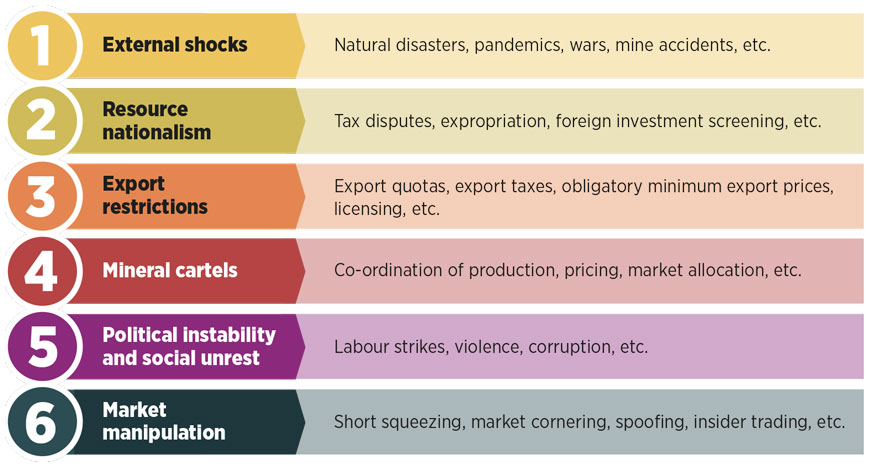
1. External shocks
Global critical material supply chains, which are interconnected, are susceptible to disruptions that may be caused by natural events, such as earthquakes, or could result from human action, either intentional (e.g. trade disputes) or unintentional (e.g. power outages). In recent years, for example, global raw material supply chains have been disturbed by shocks such as the COVID-19 pandemic, the war in Ukraine and the global energy crisis.
In 2020, the COVID-19 pandemic led entire economies to go into lockdown, resulting in a sharp decline in the global demand for metals. At the same time, supply was disrupted by the closure of hundreds of mines, smelters and refineries. For example, Peru, which accounts for 12% of the global copper supply, closed all its mines between March and early June of 2020 – the longest government-mandated mine closure (Yu et al., 2021). South Africa’s 21-day mine closure disrupted 75% of the global platinum supply (Njini and Biesheuvel, 2020).
Although metal markets swiftly recovered from the initial price and demand collapse in March 2020, they faced several major disruptions ever since. One major shock came in the form of the 2021-2022 global energy crisis. In the second half of 2021, for example, Chinese magnesium plants were partially closed due to nationwide energy shortages, as a response to the country’s power crisis. Since China accounts for about 85% of the world’s magnesium production, the effects reverberated globally and prices skyrocketed (Hume, 2021). This was felt especially strongly in Europe, which depends on China for 95% of its magnesium supply. European industry groups warned of an imminent supply depletion, threatening thousands of businesses and their workers (Burton, 2021). Similarly, in South Africa, frequent power cuts since 2022 have curbed the output of platinum group metals (Njini, 2023).
The war in Ukraine was another external shock. It disrupted certain commodities, such as nickel and aluminium, and led to price surges, even though metal markets may have been less affected by it than other commodity markets, especially food and energy. Before 2022, Ukraine was a key exporter of pig iron. The Russian Federation was the world’s largest exporter of pig iron, enriched uranium, palladium and nickel. It also accounted for a significant share of platinum and refined aluminium exports. The sanctions have so far avoided blanket restrictions on the import of key metals, instead introducing selected import duties and tariffs. 5 For instance, Russian metals giant Norilsk Nickel, a key supplier of nickel and palladium, has largely been exempted from the sanctions (MacDonald, 2022). Looking further into the future, sanctions limiting access to high-tech imports could hinder mining and processing companies since they rely on equipment and software licenses from foreign firms (Bloomberg News, 2022).
Parts of the critical material value chain are also exposed to the physical effects of climate change – from sea level rise to more frequent and severe weather events. Some materials, for example, nickel, cobalt and rare earths, are mined and processed in areas that are likely to be at a greater risk of heavy rainfall and floods. An example of this could be found in 2020, when a “once-in-a-century” flood in China’s southwest province of Sichuan shut down rare earth processing plants and damaged inventory (Daly and Zhang, 2020). Other mining activities are likely to be hit by drought and water scarcity. For example, approximately 50% of lithium mining is in high water stress areas. Given that lithium mining has a substantial water requirement, this could create conflicts surrounding the use of water (IEA, 2022).
2. Resource nationalism
In recent years, numerous governments have increased state control over their mineral resources to enhance the benefits from extraction or address its adverse impacts. This has been accomplished through, for example, tax regime strengthening, royalty renegotiation, creation of state-owned mineral companies, nationalisation of critical material industries and restrictions on foreign investments. This trend can be observed in many countries, including Australia, Canada, Chile, Mongolia, Namibia, Peru, South Africa and Zambia, among others.
Policies aimed at revising ownership and access rights over natural resources can impact global supply. For example, a royalty payment dispute brought supply from the Democratic Republic of Congo’s Tenke Fungurume copper and cobalt mine to a standstill for several months after mid-2022. This disrupted 15% of the global cobalt supply (White and Hook, 2023). Chile’s announcement in April 2023 of its decision to nationalise the lithium industry raised concern among some analysts and industry groups, even though longterm impact on global supply is not visible (see Box 2.2) (Dempsey and White, 2023).
The broad banner of “resource nationalism” is widely used to describe this trend. However, it is worth noting that the term puts together a diverse set of policies and obscures the complex set of motivations that can drive them (Ward, 2009). The recent trend of stricter mineral sector regulations is reminiscent of the 1970s, when many mineral-rich countries, including newly independent ones, adopted state-interventionist policies and set up state-owned natural resource companies in the minerals sector. As commodity prices declined in the 1980s and 1990s, and the global political consensus shifted in favour of unfettered markets, the minerals sector was swept by a wave of liberalisation, deregulation and privatisation of state assets (Dietsche, 2014). By the early 2000s, there were only a few state-owned metal mining companies left. In 2005, for example, the state had a majority ownership stake in just three of the world’s top 25 metal mining companies (Codelco in Chile, Alrosa in the Russian Federation and Debswana in Botswana). Eighteen of the top 25 metal mining companies were fully private (UNCTAD, 2007).
BOX 2.2 Chile’s strategy for lithium
In April 2023, Chilean President Gabriel Boric announced the country’s decision to nationalise its lithium industry. Chile holds the world’s largest lithium reserves and ranks second in lithium production. President Boric stated that the country’s lithium reserves represent “an opportunity for economic development that will likely not be repeated in the short term” and that nationalising the industry will enable the country to build “a Chile that is more just, more sustainable, and more democratic” (Sharp, 2023). The government would look to protect biodiversity and share mining benefits with indigenous and surrounding communities.
At present, two companies are mining in Chile: Sociedad Quimica Y Minera de Chile (SQM) and Albemarle. Under the plan, a separate state-owned company would be created to produce lithium – a move that would need to be approved by Congress. The plan envisages the issue of future lithium contracts through publicprivate partnerships, in which the state would hold a majority share (Stott and Bryan, 2023). The government would also not terminate current contracts (Government of Chile, 2023), but has expressed hope that companies would be open to state participation before they expire. SQM’s contract is currently set to expire in 2030 and Albemarle’s in 2043.
Some analysts are concerned that nationalisation of the lithium industry may deter potential partners, shift foreign direct investments to other countries and adversely affect the Chilean lithium industry as well as global supply (Innovation News network, 2023; Sharp, 2023). However, the government has indicated a gradual and pragmatic approach to bringing the sector under state control through partnerships. Chile has a positive track record with Codelco, the state copper company, which was established after the nationalisation of Chilean copper mining in 1971 during the Allende administration (Malone and Bazilian, 2023). Codelco is the world’s largest copper mining company and, according to the Chilean think tank Cenda, generates over three times the tax revenue per unit of production compared with private companies (Mining.com, 2022).
Many countries have also increased scrutiny of foreign investments, not just in the mining industry but across various sectors (UNCTAD, 2023). Australia and Canada, for instance, have recently implemented stricter foreign investment regulations in their mineral sectors. In Australia, foreign investment in the mining sector is subject to screening by the Foreign Investment Review Board, while the Canadian government has introduced a new national security review process for foreign investment. This trend of increased government scrutiny of foreign investments reflects concerns about national security, environmental sustainability, and local ownership and control over natural resources. Table 2.3 shows a few illustrative examples of how foreign investment in the mining sector is facing increased scrutiny across different jurisdictions.
TABLE 2.3 Illustrative examples of increased foreign investment scrutiny in the minerals sector
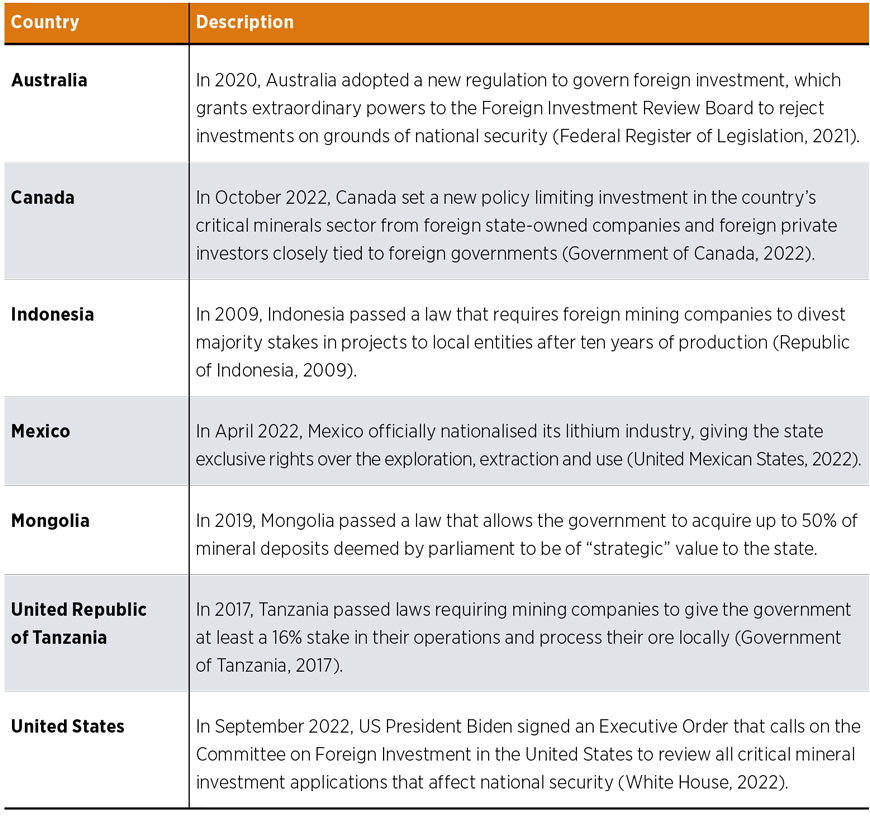
3. Export restrictions on critical materials
Export restrictions on raw materials are a growing concern in international trade. Incidences of such restrictions have grown more than fivefold over the past decade (Figure 2.11) (OECD, 2023). According to the OECD, about 10% of the global value of critical raw material exports has faced at least one export restriction measure in recent years (OECD, 2023). 6 Export restrictions take multiple forms, including export quotas, export taxes, obligatory minimum export prices, or licensing.
FIGURE 2.11 Global incidence of export restrictions on raw materials, 2009-2020
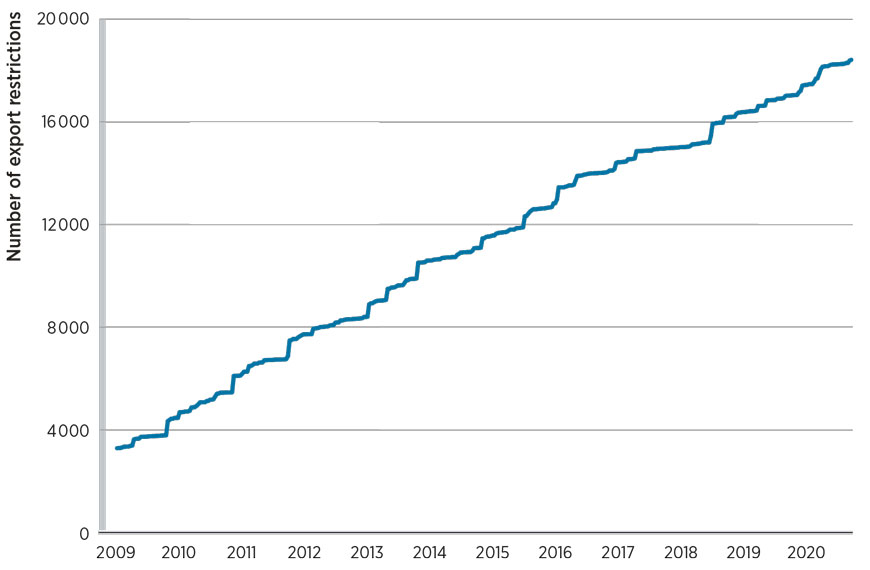
Notes: The y-axis shows the number of export restrictions in force. The database covers information on 65 industrial raw materials and 80 exporting countries, which accounted for 97% of the world’s mineral and metal production in 2018. The methodological note available at www.oecd.org/trade/topics/trade-in-raw-materials/documents/methodological-noteinventory- export-restrictions-industrial-raw-materials.pdf.
Export restrictions especially for critical materials appear to be on the rise, with several countries implementing major export bans. Zimbabwe banned the export of raw lithium in December 2022 (Marawanyika and Ndlovu, 2022). Similarly, Indonesia banned bauxite export in June 2023 (Shofa, 2023). Around the same time, Namibia prohibited the export of raw lithium and other critical materials (Nyasha Nyaungwa et al., 2023). These recent measures reflect a growing trend of countries taking steps to encourage domestic processing and attract downstream industries.
Export restrictions on raw materials are not a new phenomenon. In 1937, the League of Nations constituted a Committee for the Study of the Problem of Raw Materials to assess the incidence of export restrictions and export duties (League of Nations, 1937). Such restrictions vary significantly based on the raw material (Figure 2.12). They are not solely implemented by mineral-rich countries. Countries seeking to reduce reliance on raw material imports often impose export restrictions to retain secondary sources, such as waste and scrap (OECD, 2023).
FIGURE 2.12 Share of global exports subject to an export restriction, 2020
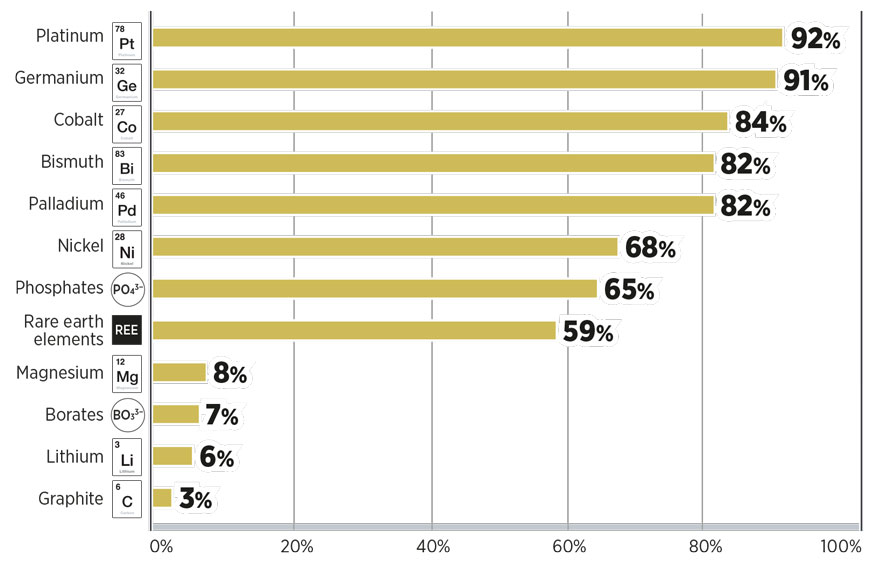
Notes: For ease of reading, the label “Germanium” has been used to denote the following group of materials: germanium, niobium, vanadium, gallium, indium and hafnium.
Quantitative import and export restrictions are largely prohibited under Article XI of the WTO’s General Agreement on Tariffs and Trade, except under certain limited exceptions, such as environmental conservation, national security or assuring raw material supply. These exceptions must meet specific conditions, for example, not protecting domestic industries or discriminating against other countries. The measures should also not unfairly restrict international trade.
The growing trend of export restrictions on critical materials has triggered a series of trade conflicts, some of which are being addressed at the World Trade Organization (WTO) (Table 2.4). These disputes cannot be linked solely to the energy transition given that the materials involved have a much wider application beyond the energy sector, such as steelmaking (molybdenum) or the chemical industry (fluorspar). The mineral trade dispute that received the most attention was the rare earth crisis of 2010-2011 (see Box 2.3).
TABLE 2.4 Recent World Trade Organization (WTO) trade disputes over export restrictions on critical materials
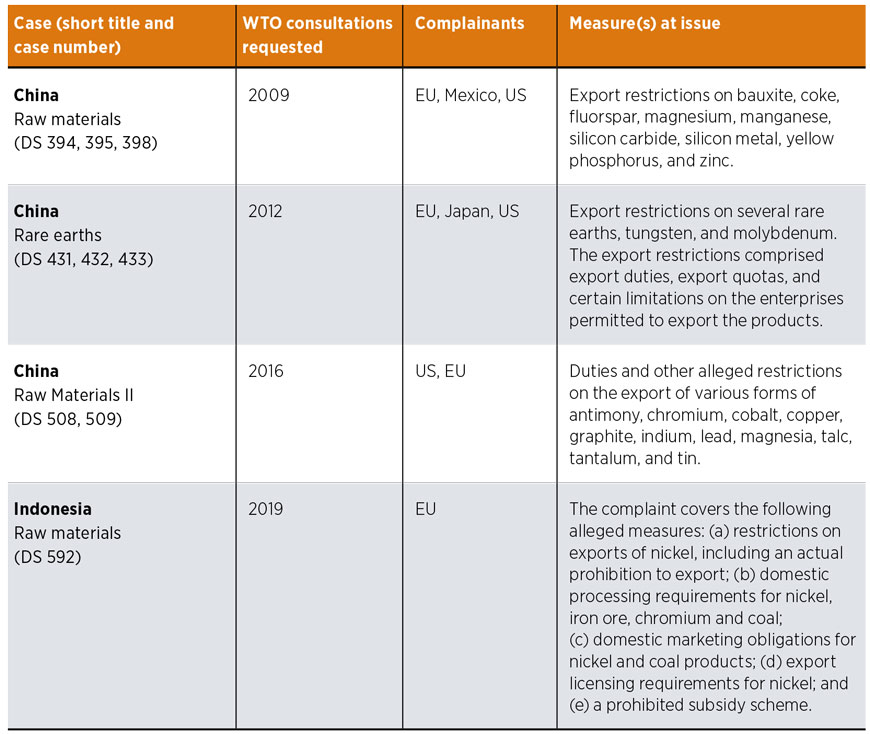
The existing international trade framework has traditionally focused on reducing import restrictions. While import tariffs have decreased over time through multilateral trade negotiations, export taxes are not subject to any WTO regulations, except for some recently acceded members, which have agreed to reduce or eliminate them under their WTO accession agreements.
BOX 2.3 The rare earth crisis of 2010-2011
Rare earths are a group of 17 chemical elements whose properties make them valuable for use in modern, high-tech applications. Today, they are used mostly in permanent magnets electric motors (for electric vehicles) and generators (e.g. in wind turbines) (Garcia, 2020). The United States dominated global rare earth production until the 1990s, after which China became the biggest producer.
By the early 2000s, China had a near monopoly, mining approximately 95% of the world’s rare earth elements (US Geological Survey and US Department of the Interior, 2010). However, increasing concerns over environmental pollution, illegal mining and resource depletion led the government to decide on developing a downstream industry (Wübbeke, 2013). Starting in 2006, the country introduced several regulations, including export quotas, production quotas, export taxes and restrictions on foreign investment (Shen et al., 2020). Export quotas were introduced gradually, but in 2010, China decreased its export quota for rare earths by 37%, resulting in a surge in rare earth oxide prices since alternative supplies were lacking (see Figure 2.13).
Apart from export quotas, Chinese shipments to Japan were reportedly interrupted for a few weeks between September and November 2010 after the detention of a Chinese fishing trawler’s captain amid a maritime dispute (Wilson, 2018). Reports on the number of delayed rare earth exports, the length of delays and the parties responsible for them continue to be conflicting. Analysis of customs data from the Japanese Ministry of Finance shows that Japanese imports of Chinese rare earths did not decline uniformly following the trawler incident (Johnston, 2013).
The 2010-2011 price spike caused major shifts in rare earths’ supply and demand, leading to price attenuation by 2012. Recycling and substitution reduced demand substantially, while trade deflection, inventory management, the opening of new mines and smuggling ensured residual supply (Gholz and Hughes, 2021).
In March 2012, Japan, the European Union and the United States requested a World Trade Organization consultation over Chinese rare earth export restrictions. China defended the restrictions as necessary for conservation, whereas the complainants countered that they were, “designed to achieve industrial policy goals rather than conservation”. In 2014, the World Trade Organization Appellate Body decided in favour of the complainants, and China was required to lift its rare earth export restrictions.
FIGURE 2.13 International rare earth metal oxide prices, 2007-2016
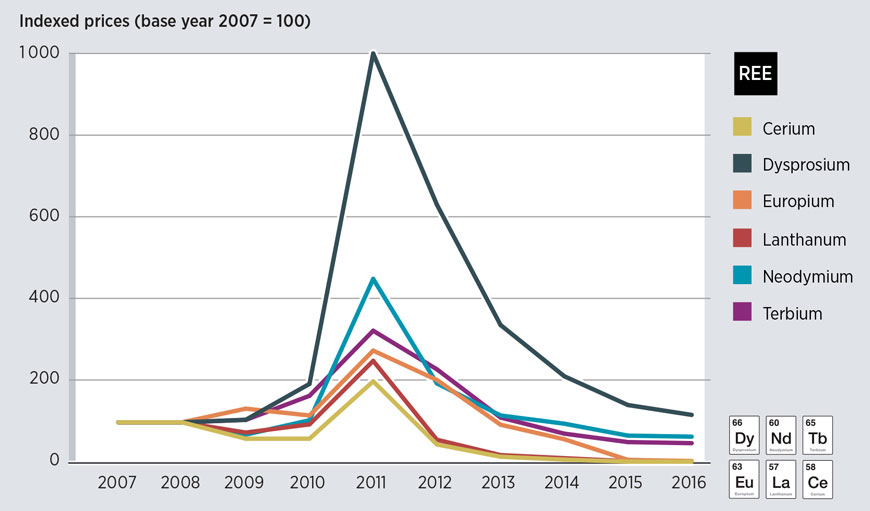
Note: REE = rare earth elements.
4. Mineral cartels
The high concentration of mineral production raises concerns of market cartelisation and collusion. Mineral supply is concentrated geographically, and corporations with large market shares in key segments of mineral value chains dominate their mining and refinement. This concentration of production could potentially lead to the formation of commodity cartels, groups of major producers that maximise their profits by co-operating on the production, pricing and/or distribution of commodities.
Historically, producer groups and governments have made various attempts to influence mineral markets through collusion (World Bank, 2022). In the early 20th century, there were active producer cartels in the aluminium, copper, nickel, steel, zinc and lead industries (Barbezat, 1989; Bray, 1997; Storli, 2014; Tsokhas, 2000; Walters, 1944). A number of these cartels were created in the 1930s in response to the extremely low prices that prevailed during the Great Depression.
The 1960s to 1970s saw another wave of cartelisation, in the aftermath of decolonisation and a booming world economy, with the creation of several cartels and producer clubs to govern metal markets such as for bauxite, copper, iron ore, tin, tungsten and uranium (see Table 2.5). Many of these attempts were, however, short-lived, 7 as they were plagued by issues such as internal discord, non-participation of major producers, and mineral substitution or innovation in supply and demand technologies.
In addition to producer clubs, there have been several international commodity agreements involving both producers and consumers. For instance, a series of international commodity agreements governed the tin market from 1956 till 1985, when the last international tin agreement collapsed (Hillman, 2010). These agreements aimed to stabilise the tin market by establishing a buffer stock system that would allow producers to store excess supplies during periods of oversupply and release them during periods of shortages. While this system kept tin prices elevated for several years, it also encouraged the substitution of tin with aluminium, especially in the beverage can industry (World Bank, 2022).
In recent years, several mineral producing countries have again considered the idea of cartelisation, although plans and proposals for new mineral cartels do not meet the criteria for establishing commodity cartels (Box 2.4).
TABLE 2.5 Metal producer clubs in the 1970s to 1980s
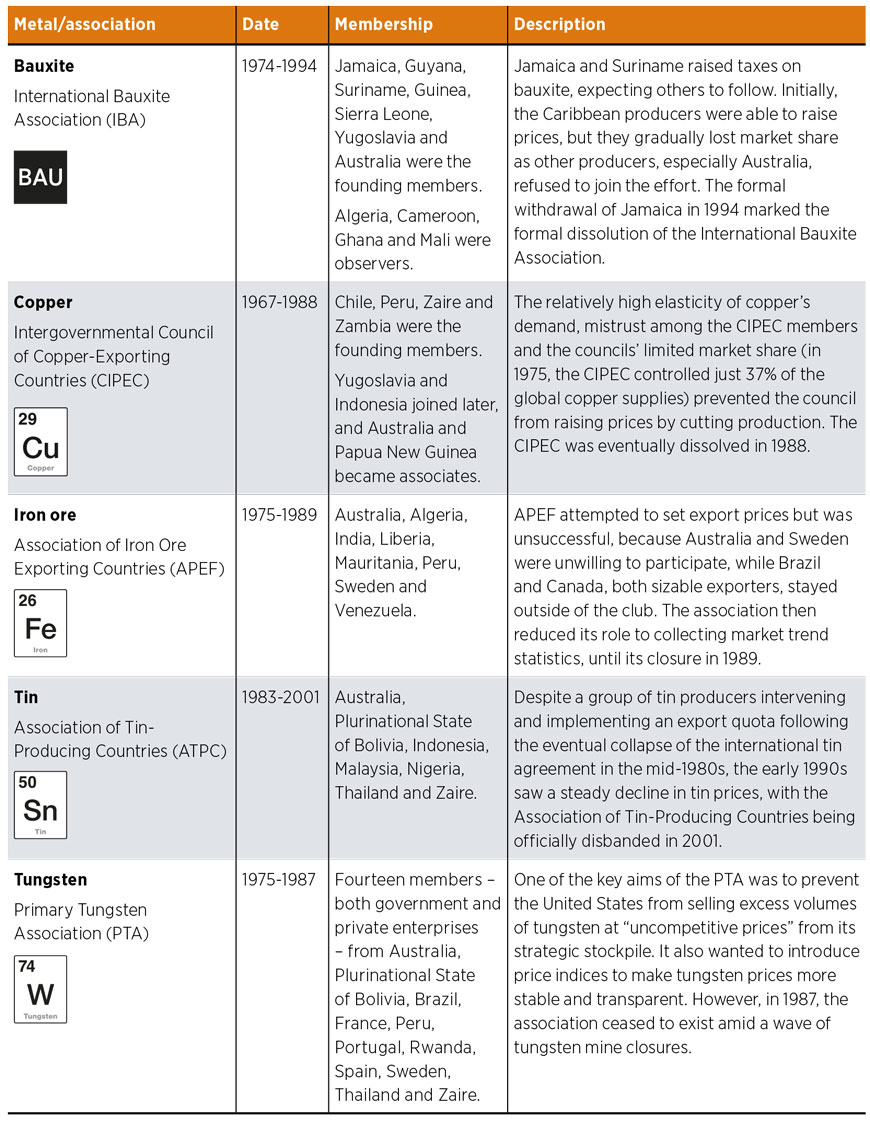
BOX 2.4 Prospects for cartelisation in the platinum, nickel and lithium markets
Most new proposals will struggle to meet all the conditions for a successful commodity cartel. For a commodity cartel to be successful, it must bring together dominant producers with substantial market shares that have firm ownership of mineral production within their respective states. There must exist high entry barriers, preventing new producers from entering the market and competing with existing producers. Product homogeneity is another important factor, where commodities standardised to the point where they are virtually identical across producers. This attribute is essential for the members of a successful commodity cartel to co-ordinate production and pricing strategies effectively.
Demand elasticity is another crucial factor that affects the feasibility of a commodity cartel. It refers to how quickly and to what extent a product’s demand might shift in response to high prices. A commodity cartel has limited control over price if a product is highly elastic, meaning consumers are willing to reduce its consumption at higher prices or could swiftly shift to substitutes. Conversely, a commodity cartel may have greater control over price if a product is relatively inelastic, meaning consumers have few or no substitutes.
Platinum
The Russian Federation and South Africa signed a memorandum of understanding on platinum group metals (PGMs) at the March 2013 BRICS (Brazil, Russia, India, China and South Africa) summit. Together, they hold a substantial share of the PGM market – over 80% of global platinum supply and over 96% of global PGM reserves – hindering the entry of potential competitors (US Geological Survey and US Department of the Interior, 2022).
In practice, however, there are major obstacles to the creation of a PGM cartel since none of the countries has a state-owned company monopolising PGM mining. Any production cuts would require the buy-in of several private companies, including Norilsk Nickel, Anglo-American Platinum and Impala Platinum. Further, production cuts designed to increase prices could lead to job losses in the labour-intensive PGM industry, which is the largest mining employer in South Africa. 8 The alternative of purchasing platinum from producers and storing it to support prices could strain government finances (Stoddard, 2013).
Finally, sustained high prices would likely adversely impact demand as industrial users would intensify efforts to reduce, reuse or recycle PGMs in catalysts and other applications (Kooroshy et al., 2014). Although the Russian Federation and South Africa reaffirmed their commitment to the 2013 memorandum of understanding in 2018, few details have since emerged.
Nickel
Indonesia, the world’s largest nickel miner, is considering the potential establishment of an Organization of the Petroleum Exporting Countries (OPEC)- style organisation for certain battery metals, including nickel, cobalt and manganese (Dempsey and Ruehl, 2022). While the country accounts for almost half of the global nickel production, a share larger than that of OPEC countries in oil production, replicating the OPEC model would not be without challenges.
For instance, major nickel producers such as Australia, Canada and the Philippines are not supportive of the idea of the OPEC-style organisation (Listiyorini and Harsono, 2022; Serapio Jr and Lopez, 2023). In addition, the existence of untapped reserves outside of Indonesia presents opportunities for supply diversification. Further, multiple private companies, not a single state-owned entity, control Indonesia’s nickel mining. 9 Nationalisation of the country’s nickel industry would therefore have financial and political challenges especially considering that Chinese firms have a strong position in it.
Product heterogeneity could be another obstacle to creating a nickel supply cartel. Nickel ores exist in two types of deposits: sulphide and laterite. Sulphide deposits are mainly found in Australia, Canada and the Russian Federation, and contain higher-grade nickel, which can be processed more easily into Class 1 batterygrade nickel. The laterite deposits of Indonesia and the Philippines contain lower-grade nickel, which requires additional energy-intensive processing for conversion into battery-grade nickel (Paraskova, 2022). Low- and higher-grade nickel ores act as imperfect substitutes and compete in distinct but related markets (Kooroshy et al., 2014).
Unlike petroleum, which has long been an unrivalled transportation fuel, there are ample opportunities to shift demand away from nickel. Although nickel-rich cathodes held a 60% share of the EV battery market in 2022, the share of lithium-iron-phosphate batteries, which do not require nickel, increased from 7% in 2019 to 40% in the same year (BloombergNEF, 2022). Innovation in battery chemistry, for example, manganeserich cathodes, and recycling could further reduce the demand for nickel.
Lithium
Argentina, Bolivia and Chile are in talks to establish a “lithium OPEC”. Collectively known as the lithium triangle, these three countries hold around 65% of the world’s known lithium resources and accounted for almost 30% of the global production in 2020 (Gielen and Lyons, 2022b). However, there are challenges to the formation of a lithium cartel. Australia, the world’s largest lithium producer and second in terms of lithium reserves, is unlikely to participate in such an endeavour (Mares, 2022). Additionally, many countries have identified significant untapped lithium reserves and resources through ongoing exploration. Further, like platinum and nickel, most lithium mining is under private control, often by foreign companies.
Lithium is primarily mined from brines (mainly in South America and China) and hard rock ore, especially spodumene, which is spread more widely (in Australia, Canada and elsewhere). EV batteries use either lithium carbonate (lithium-iron-phosphate batteries) produced from brines, or lithium hydroxide (nickelmanganese- cobalt batteries) produced from hard rock ore or from lithium carbonate through chemical processing. Australian producers have an advantage since their spodumene ore is cheaper and easier to convert into lithium hydroxide, which battery makers increasingly prefer (Gielen et al., 2022b; Mares, 2022). Finally, lithium compounds can be substituted in batteries, the primary use of lithium. Sodium, and air metals, including zinc, can replace lithium wholly or partially as battery materials for some EVs, although every change comes with trade-offs in terms of cost, performance and security of supply (Blakemore et al., 2022; IRENA, forthcoming).
5. Political instability and social unrest
Political or social unrest in producing countries, including coups, labour strikes and civil wars, could disrupt mineral supply. The majority of minerals are extracted in countries categorised as either extremely unstable or unstable in the Worldwide Governance Indicators, which measure the quality of governance across six major dimensions, including absence of violence, control of corruption and rule of law (see Figure 2.14).
Examples of such supply-disrupting instability are numerous. For instance, in 1978, the Angolan civil war spilled over to Zaire’s Shaba province (now Katanga in the Democratic Republic of Congo), triggering a sevenfold cobalt price surge in a two-year period due to fears of global cobalt shortages (Gulley, 2022). This “cobalt crisis” prompted a shift from cobalt to rare earths for manufacturing permanent magnets, in a way foreshadowing the “rare earth crisis” of 2010.
Another example is Myanmar, where the mining sector saw protests and strikes erupt following a coup in February 2021. These instabilities caused an 80% decline in export earnings from minerals for the country, which is a major rare earth producer (Frontier, 2022). A further example is Guinea, which witnessed political crisis in 2021, causing supply disruptions and uncertainty in the global aluminium market given that it is the world’s largest bauxite producer.
Critical material supply can also be disrupted due to labour strikes. Labour strikes in the South African platinum sector significantly disrupted global supply chains, with one major strike in 2014 lasting five months and causing a 40% drop in global platinum production (Stoddard, 2014). Chile, the world’s largest copper producer, has also witnessed production disruptions and supply shortages due to labour strikes, of which a major one in 2017 lasted 44 days, causing a significant drop in global copper production (Iturrieta, 2017). In Peru, strikes by copper mine workers have recently led to production shutdowns and delays, causing supply shortages and price volatility in the global copper market (Attwood, 2023). These labour strikes often highlight the workers’ legitimate concerns about poor working conditions (see Chapter 3).
FIGURE 2.14 Political stability of mineral producing countries, 2020
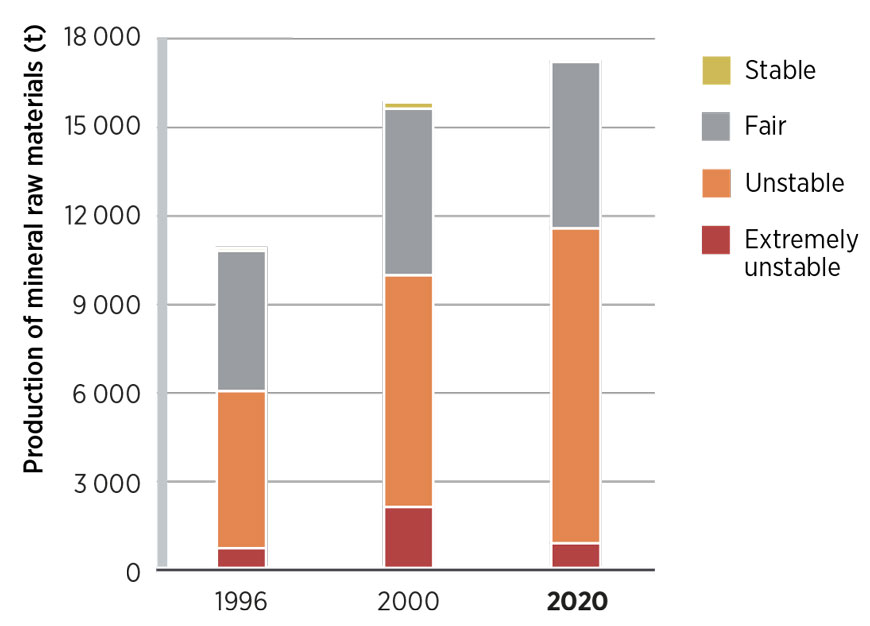
6. Market volatility and manipulation
Critical material markets, like other commodity markets, demonstrate a cyclical nature, exhibiting a classic boom-bust pattern. This is partly due to the extended lead times required to establish new mines, causing a supply-demand gap, especially during periods of rapid demand growth. For major new greenfield mines, advancing from resource discovery to actual production typically takes seven to ten years. This means that technological advancements can trigger resource demands much faster than producers can raise supplies, resulting in periodic price surges.
This dynamic is compounded by the fact that critical minerals are often by-products of other mined base metals. For example, cobalt is typically a by-product of nickel and copper mining, nearly all indium is a byproduct of zinc mining and most rare earth elements are by-products of iron ore mining. The production of these minor metals is therefore strongly influenced by the production of the base metals, which often generate more revenues. For example, investments in new cobalt projects are often linked more to market dynamics for copper than cobalt. In other words, a higher cobalt price does not necessarily incentivise copper miners enough to produce more of it. Supply responses for metals such as cobalt, indium and tellurium are indirectly influenced by price increases due to the peculiar nature of by-product production (Nassar et al., 2015).
In addition to supply and demand dynamics, mineral and metal markets are also prone to market manipulation, which can exacerbate price volatility and supply chain disruptions. Between 2000 and 2010, there were at least 15 cases where antitrust authorities uncovered and penalised attempts to form international private cartels in mining and primary metals (Connor, 2012).
Considering mineral markets are small with relatively little liquidity, there are ample opportunities for traders to develop market-cornering positions that can constrict supply and cause price spikes (Hendrix and Bazilian, 2022). In the past, there were numerous attempts to manage the market and influence prices, creating concerns over corporate market manipulation. For instance, in the 1985 tin crisis, the tin market collapsed when a group of traders, who tried to corner the market, could not find buyers for their large tin holdings due to the unprecedented price surges (Anderson and Gilbert, 1988). Similarly, in the 1996 Sumitomo copper affair, copper prices rose sharply after a single trader at Sumitomo Corporation accumulated a significant amount of copper futures contracts. Sumitomo and other market participants suffered heavy losses when the trader’s positions were revealed, causing a market crash (Kozinn, 2000).
More recently, the LME suspended nickel trading in March 2022 after prices surged by over 250% in just two days. The price surge was attributed to a short squeeze, where traders who had bet against the price of nickel were forced to buy back their positions at higher prices, driving the price even higher (Farchy et al., 2022; Oliver Wyman, 2023). Over a year later, the nickel market remains unstable, with trading volumes falling sharply and prices experiencing frequent uncontrolled swings (Cang and Farchy, 2023).
These incidents have prompted financial regulators and exchanges to launch probes to increase market oversight, transparency and risk management. For example, the LME has introduced new rules to prevent short squeeze and other forms of market manipulation. These include, for example, limits on the amount of nickel that can be delivered on futures contracts. However, the effectiveness of these efforts in preventing market manipulation remains to be seen.
2.3 The race for critical materials and the potential for conflict
Mining and international conflict
Access to natural resources is a key aspect of strategic interest for many countries and is reflected in their foreign policy doctrines and actions. The pursuit of critical materials has been a major motive for states seeking territorial expansion. Now, the global demand for critical materials could lead to increased competition especially in deposit-rich areas, potentially sparking geopolitical tensions in the Arctic, outer space and the deep sea, as countries scramble to secure access to these resources (Fox, 2022).
The Arctic is known to have vast reserves of critical materials such as nickel, zinc and rare earths (Boyd et al., 2016). Mining is not a new activity in the region, which is home to several well-established mines, such as the Red Dog zinc mine in Alaska and the Polar Division nickel mines in Arctic Russia (Loginova et al., 2023). New deposits are being discovered. In January 2023, the Swedish mining company LKAB announced the discovery of the largest known rare earth elements deposit in Europe. The rapid melting of the Arctic sea ice, due to the region warming at twice the global average rate, has exposed previously inaccessible resources, triggering heightened competition among countries (IPCC, 2021; Paul Taylor, 2020). 10 While the region has seen increased military presence, most scholars see a low likelihood of conflict over resources (Tunsjø, 2020). Nonetheless, the region’s mineral bounties contribute to its strategic importance.
Outer space is also becoming a new frontier in the race for critical materials. Asteroids and other celestial bodies are believed to be extremely rich in rare metals, including platinum and gold. This has spurred increased investment in space exploration and mining, with countries such as China, the Russian Federation and the United States vying for a foothold in this emerging industry. NASA’s OSIRIS-REx mission, for instance, gathered a small sample from asteroid Bennu and will return to Earth on 24 September 2023 (NASA, 2023). A rapid take-off of commercial space mining is, however, unlikely due to unresolved questions about its costeffectiveness, technical feasibility, legal governance, and environmental and safety implications.
The race for minerals could also trigger geopolitical conflicts over ocean seabeds, which hold some of the largest estimated mineral deposits on the planet. Some countries have already initiated deep-sea exploration within their exclusive economic zones or extended continental shelves. Norway, for instance, is planning to open an area of ocean nearly the size of Germany to deep-sea mining (Bryan and Milne, 2023). However, these areas often overlap between neighbouring countries, triggering disputes over resource ownership and extraction rights. Deep-sea mining in waters beyond national jurisdiction is regulated by the International Seabed Authority, created by the United Nations Convention on the Law of the Sea. However, a regulatory framework remains incomplete, and member countries have opposing views on how to proceed (see Box 2.5).
BOX 2.5 Governing deep-sea mining
A growing number of countries and corporations are showing interest in deep-sea mining for critical materials, that is, extracting mineral resources from the ocean floor. To date, 22 state and private contractors hold 31 mining exploration contracts to search for polymetallic nodules, polymetallic sulphides and cobaltrich ferromanganese crusts (Figure 2.15) (International Seabed Authority, 2023), which are extremely rich in valuable metals with high-grade ore, such as cobalt, copper and manganese.
Deep-sea mining raises concerns regarding environmental impacts, including marine habitat destruction and the release of toxic chemicals. Deep-sea ecosystems are crucial for global climate regulation and form an important part of oceanic food webs (Environment Justice Foundation, 2023). While some proponents of deep-sea mining argue that it is more eco-friendly than land-based mining, others argue that it is not sustainable and could cause irreversible environmental damage (Levin et al., 2020). This has prompted several calls for a moratorium on deep-sea mining. In September 2021, the International Union for Conservation of Nature’s World Conservation Congress adopted a motion calling for a moratorium on deep-sea mining (Resolution 122, IUCN, 2021).
FIGURE 2.15 Geographical distribution of the three types of mineral deposits targeted by deep-sea mining
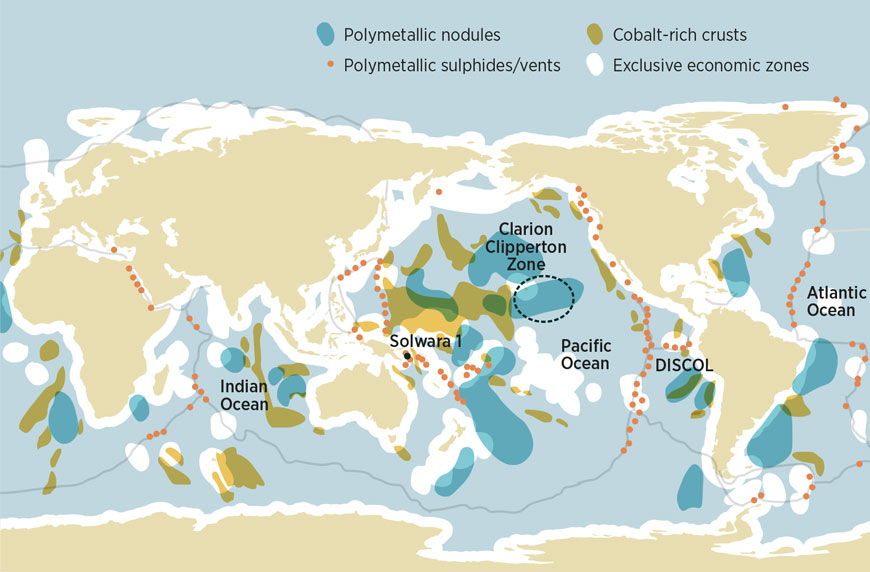
Disclaimer: This map is provided for illustration purposes only. Boundaries and names shown on this map do not imply any endorsement or acceptance by IRENA.
Several countries also have called for a moratorium or precautionary pause on deep-sea mining in international waters (Deep Sea Conservation Coalition, 2022). The European Commission wants deepsea mining to be prohibited until “scientific gaps are properly filled, no harmful effects arise from mining and the marine environment is effectively protected” (Directorate-General for Maritime Affairs and Fisheries, 2022).
Deep-sea mining is regulated by the International Seabed Authority (ISA), an intergovernmental body of 167 member states and the European Union established under the 1982 United Nations Convention on the Law of the Sea. The ISA has the exclusive right to issue exploration and exploitation contracts for minerals in the international seabed, although it is also required to ensure protection of the marine environment from the potential harmful impacts of deep-seabed-related activities. While the ISA has developed regulations governing prospecting and exploration activities for minerals, it is still working on a more comprehensive mining code that would cover commercial-scale exploitation of these resources.
In July 2021, the Pacific Island nation of Nauru triggered the “two-year rule”, which gave the ISA two years to finalise rules and regulations for deep-sea mining. This expedited ISA’s efforts to complete its mining code before the deadline stipulated in Nauru’s submission, 9 July 2023, potentially enabling the approval of commercial mining applications as early as mid-2023.
Mining and local conflict
The race for minerals can exacerbate or contribute to local armed conflict in multiple ways. In countries with weak governance and political instability, mineral extraction can be linked to local grievances, conflict and human rights abuse (Church and Crawford, 2018). This has been observed with certain other high-value resources, such as diamonds, gold and timber. In fact, the United Nations Environment Programme estimates that at least 40% of all intrastate conflicts in the past 60 years can be linked to natural resources (UNEP, 2009).
Mineral riches can contribute to conflict in several ways (UNEP, 2009). For example, mineral exploitation can stir conflict over the fair distribution of benefits and costs among the local population. Mining wealth can also be exploited to sustain local conflicts, and in areas with weak state authority, it can help armed groups fund their activities by exploiting green mineral deposits, leading to increased violence and instability. This is especially true in regions with a history of conflict or where ethnic or religious tensions exist.
In Colombia, for example, Revolutionary Armed Forces of Colombia (FARC) rebels, who have been fighting an insurgency since 1987, long financed part of their operations by producing tungsten from the depths of the Amazonian jungle. Similarly, in the Democratic Republic of Congo, rebel gangs are estimated to make millions from illegally producing tungsten, tin, tantalum and gold (also referred to as “3TG”). It is estimated that approximately 21% of the world’s tantalum supply in 2011 came from conflicted regions (Abraham, 2017).
Certain mineral resources are less likely to be involved in local conflicts than others. For example, minerals such as bauxite, lithium and graphite are profitable only when extracted on a large industrial scale. Also, bauxite and graphite have low value-to-weight ratios, making them less attractive to non-state armed groups, such as rebel armies and militias, which exploit valuable resources. Further, although artisanal miners mine a substantial portion of cobalt, the artisanal cobalt mines in the Democratic Republic of Congo have not yet been targets for armed actors, despite the prevalence of conflict around the artisanal gold and other conflict minerals in Eastern Congo (Hendrix, 2022).
Highlights
- The mining industry has, at times, caused harm to workers, indigenous communities and the environment, raising concerns that the energy transition will exacerbate these impacts.
- The mining of critical materials has been associated with land loss, displacement and human rights abuses against indigenous communities. Going forward, mining projects must include robust and proactive community engagement, considering 80% of lithium projects and more than half of nickel, copper and zinc projects are located in territories belonging to indigenous peoples.
- Poor labour conditions have been persistent in the global mining industry, which lacks adequate social protection and labour laws. These challenges are further amplified by artisanal and small-scale mining, which is characterised by hazardous working conditions, low wages and a lack of social protection. A fair and sustainable green economy transition thus requires addressing these challenges.
- The metals and mining sector is responsible for 10% of global greenhouse gas emissions, with aluminium and steel industries being large contributors. Despite their mineral intensity, renewable energy technologies emit only a fraction of the greenhouse gases released by fossil fuel technologies. Increasing investments in energy efficiency and shifting to renewable electricity can reduce emissions from mining and processing.
- Mining activities can have detrimental effects on landscapes, for example, deforestation, soil erosion and pollution. Mitigating these impacts requires implementing robust environmental management practices and adopting sustainable mining approaches.
- Critical material extraction can exacerbate water stress. About half of global copper and lithium production, for example, is in highly arid areas. Encouraging water savings at mine sites by, for example, increasing water reuse and recycling, the use of desalinated water supply and responsible water discharge of appropriate quality are essential to minimise impacts on local populations and ecosystems.
- If managed responsibly, the energy transition can promote inclusivity and stability by increasing access to affordable and reliable energy, catalysing economic growth and improving social and environmental outcomes. International co-operation is essential to ensure a sustainable, rights-based approach to the energy transition that benefits all stakeholders.
- For developing countries, the growing demand for critical materials brings risks but potentially even greater rewards. Combating corruption and multinational tax avoidance in the extractive sector is essential to ensure its maximal contribution to a successful energy transition, which can help developing nations move up the value chain, attracting highermargin activities such as mineral processing and avoiding reliance on primary ore exports.
The concept of “human security” can help broaden the traditional security agenda to include non-traditional threats such as climate change, energy insecurity, poverty, migration and pollution, which can indirectly or directly affect peace and stability both within and between countries. Understanding the geopolitical risks related to the development of critical materials for the energy transition therefore requires a comprehensive understanding of the associated threats and vulnerabilities (Table 3.1).
TABLE 3.1 Selected social, environmental and governance risks associated with critical materials
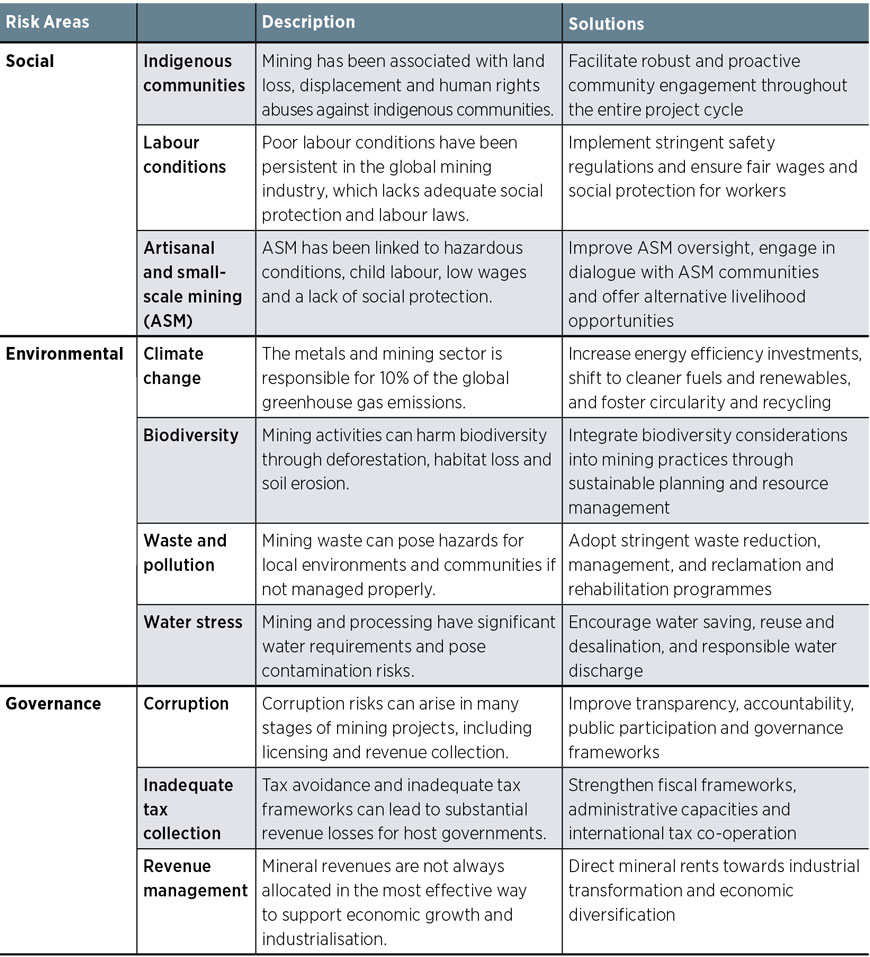
The extractive industry has contributed to human insecurity in the past (United Nations Development Programme (UNDP) et al., 2016), raising concerns that the extraction of energy transition minerals may exacerbate this trend. In certain cases, mining of critical materials, such as copper, lithium, nickel and cobalt, has caused serious harm to workers, indigenous communities and the environment. Therefore, it is essential that these materials are extracted and processed responsibly, giving due consideration to their impact on local communities and the environment.
If managed well, the energy transition could be a game changer for inclusivity and stability. By expanding access to reliable and affordable energy, the transition can catalyse economic growth, alleviate poverty, and enhance social and environmental outcomes (IRENA, 2023a). The need to expand and diversify critical material supply chains also offers an opportunity to rewrite the legacy of the extractive industries, while opening opportunities for local value creation in mineral-rich developing countries. International cooperation can ensure an energy transition guided by the principles of sustainability, human rights and social justice so that the benefits can be shared by all.
This chapter discusses some of the most salient human security risks associated with mineral development, including their impact on indigenous communities, human rights, labour conditions, climate change, land use and water security. These risks vary across critical materials, with pronounced environmental and social implications linked to specific minerals. Cobalt sourced from the Democratic Republic of Congo, for instance, has been linked to grave human rights violations. Nickel production, especially from laterite deposits prevalent in Indonesia and the Philippines, poses significant challenges concerning emissions and deforestation. Further, lithium extraction from brines in Latin America raises substantial concerns over water stress.
3.1 Economic and social tensions
Indigenous communities and human rights
Mining displaces indigenous communities and can lead to loss of land and natural resources that are essential to their livelihoods and cultural practices. Displacement of these communities causes them to lose access to their traditional territories, potentially disrupting their cultural practices and social structures, and, in some cases, has involved the forced relocation of entire communities (Ali, 2009).
According to a recent survey, 54% of energy transition minerals are located on or near indigenous peoples’ land (Owen et al., 2022). 11 The proportion varies by mineral, with over 80% of lithium projects and more than half of nickel, copper and zinc projects located in indigenous peoples’ territories. Moreover, mining projects in these areas are often located in highly vulnerable settings. Over a third of the energy transition mineral projects are located on or near indigenous or peasant land facing a combination of three contextual risks – water risk, conflict and food insecurity (Figure 3.1) – whose co-occurrence is by far the highest for platinum, followed by molybdenum (76%) and graphite (74%). Ninety-one percent of platinum reserves and resources are located on or near indigenous or peasant land facing these three contextual risks.
FIGURE 3.1 Co-occurrence of water risk, conflict and food insecurity for critical mineral mining projects located on or near indigenous or rural land
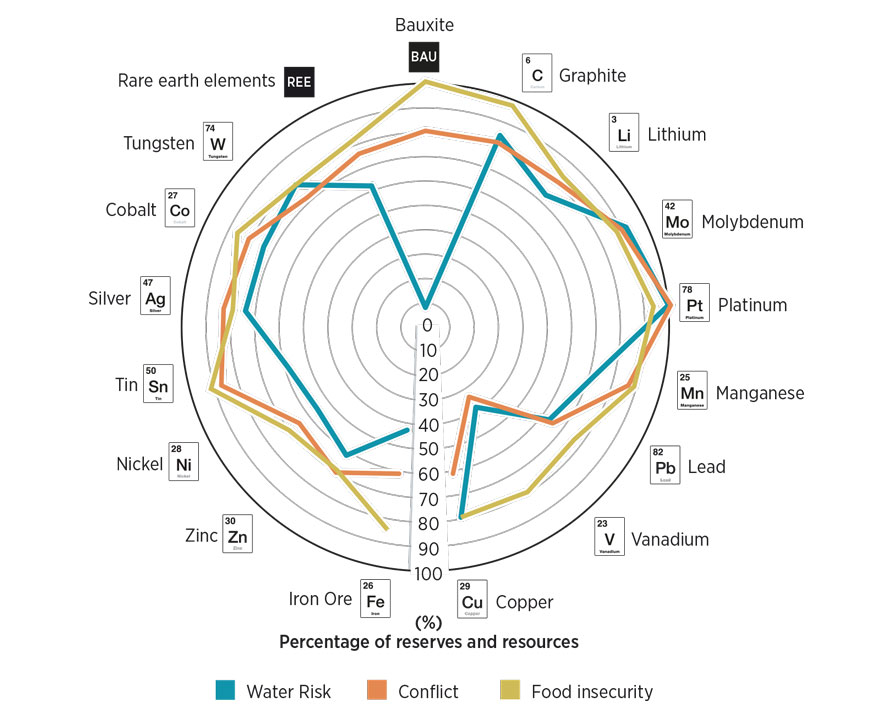
The United Nations Declaration on the Rights of Indigenous Peoples, adopted by the General Assembly in 2007, sets out an international framework for the protection and promotion of indigenous peoples’ rights, including their right to free, prior and informed consent (United Nations, 2007). However, despite this framework, the mining of minerals critical to the energy transition continues to face allegations of human rights abuse.
According to the Business and Human Rights Research Centre – a non-governmental organisation monitoring 103 firms engaged in mining six minerals important to the transition – 495 allegations of human rights violations were reported in 2010-2021. The allegations include development on indigenous peoples’ land without their consent, desecration of sacred sites, increased risk of violence against indigenous women and environmental threats to the subsistence resources of communities already facing climate change impacts (Business & Human Rights Centre, 2022). The indigenous struggle against the Fénix nickel mine in Guatemala illustrates several of these issues (see Box 3.1).
BOX 3.1 Indigenous rights and resistance against the Fénix nickel mine in Guatemala
Guatemala’s Fénix nickel mine (owned by a subsidiary of the Swiss company Solway Investment Group) has been at the centre of a social struggle for many years. Indigenous campaigners accused the mine of causing severe environmental and social impacts on nearby communities, and the company has been criticised for its lack of consultation with local indigenous communities and the Maya Q’eqchi’ fishermen, and for not respecting their rights to land and resources (United Nations, 2011).
The mine faced protests first in 2014, when local communities accused the company of contaminating nearby rivers as well as Lake Izabal, the country’s largest lake. Although the company denied the allegations, tensions continued to rise, and the situation escalated in 2017, when police and security forces were deployed to suppress protests. Many were injured in these clashes and one protester lost his life. The incident drew international attention and led to calls to hold the company accountable for its actions (Cuffe, 2022).
In 2019, the Guatemalan government suspended operations at the Fénix mine, citing concerns about the company’s failure to comply with environmental regulations. The company challenged the decision, allowing mine operations to continue amid the legal battle. In 2021, the Guatemalan Supreme Court ruled that the mine could resume operations, although local communities and human rights organisations, which fear further harm to the environment and human rights, have opposed the decision (Daniels, 2022). The Fénix mine remains a contentious issue, highlighting the need for greater accountability and respect for indigenous peoples’ rights in the mining industry.
Mineral and metal extraction has been creating similar situations in indigenous territories elsewhere. For example, in Ontario, Canada, critical mineral extraction has raised concerns about its potential impact on the traditional territories of the First Nations (Dufour, 2023). Another example can be found in 2020, when Rio Tinto attracted significant public criticism for legally demolishing two ancient and sacred caves in the Juukan Gorge in Western Australia’s Pilbara region for expanding an iron ore mine (Burton and Barrett, 2020).
These challenges underscore the utmost importance of ensuring effective community engagement within the mining sector, which requires the equitable representation and involvement of local communities from the initial project planning stages, and ensuring their voices are heard and that their concerns addressed throughout the project life cycle. Also, mining companies should ensure that local communities and indigenous peoples benefit from mining revenues, for example, through investment in local infrastructure and community development. By actively building trust and cultivating strong relationships with local communities, mining corporations not only promote mutual prosperity but also establish a solid foundation of trust with investors and policy makers (Energy Transitions Commission, 2023; ETC, 2023).
Labour conditions and employment
The mining industry is plagued by poor labour and working conditions. Many countries rich in mineral reserves lack robust social protection and labour laws. This leads to inadequate wages and creates substandard working conditions, indicating that the extraction of energy transition minerals could potentially contribute to labour exploitation and human rights violations.
Threats to labour conditions are amplified through the widespread practice of artisanal and small-scale mining (ASM), which is often informal and unregulated, with workers frequently working under hazardous conditions on low wages, with no basic social protection. ASM is common in the mining of minerals such as cobalt, but also associated with exploitative labour practices, child labour, pollution (and its associated health impacts) and environmental degradation. A just and sustainable energy transition requires addressing the challenges associated with ASM (see Box 3.2).
BOX 3.2 Artisanal and small-scale mining
Worldwide, almost 45 million people across 80 countries are engaged directly in artisanal and small-scale mining (ASM), 12 with another 134 million indirectly involved in industries supporting the sector (World Bank, 2020a). The number of people engaged in ASM has increased more than sevenfold since the early 1990s (Figure 3.2 and Figure 3.3).
ASM’s growth over the past two decades has been due to, among others, fewer alternative livelihoods and the growing mineral demand from low-carbon and clean energy technologies (Florence Bascom Geoscience Center, 2019; World Bank, 2020a). For example, the sector produces 18–30% of the world’s cobalt, a key battery metal powering the global clean energy transition (OECD, 2019). Other energy-transition-relevant minerals mined through ASM include rare earth elements mined in Myanmar and copper mined in Peru and the Democratic Republic of Congo (Awng, 2022; Bangkok Post, 2021).
Even though ASM often reduces poverty, increases national income and contributes to export earnings for developing countries (Hilson, 2002), it faces several challenges (given below), which must be addressed.
FIGURE 3.2 Number of people engaged in ASM (in millions)
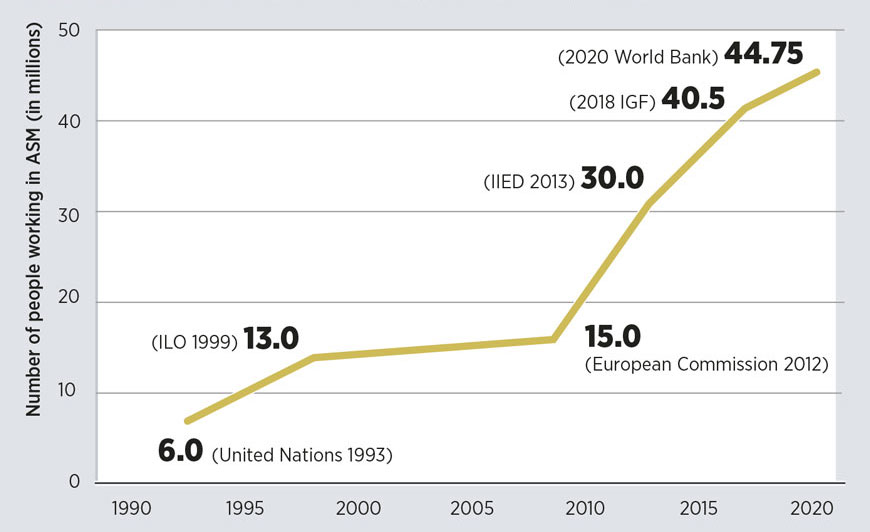
Note: ASM = artisanal and small-scale mining.
- Health and safety concerns: ASM is characterised by a lack of regard to miners’ occupational health and safety. ASM miners are exposed to physical and toxic hazards and are at a greater risk of infectious diseases and cancer, making it one of the most dangerous professions (Landrigan et al., 2022).
- Labour and human rights abuse, including child labour: The ASM sector is not formalised and is inadequately regulated, causing several challenges for its miners, from lack of appropriate safety equipment and faulty machinery (Casey, 2019) to low daily wages (Pattinson, 2021). Child labour is a major challenge of this low-cost, low-tech and labour-intensive industry. Cobalt mining employs children as young as ten years on daily wages ranging between USD 3.50 and USD 10 for the risky and arduous tasks of digging underground, carrying heavy sacks and washing the extracted cobalt in the river (Fleming, 2018).
- Environmental degradation: ASM mining is frequently associated with substantial environmental degradation. In general, it adversely impacts water and soil resources when mining effluents are discharged into the environment without proper treatment (Gyamfi et al., 2019). Besides exacerbating pollution, ASM activities also cause deforestation, threatening local ecosystems and ecosystem services (Servir Global, 2020).
- Economic losses: Loss of tax revenues due to illegal mining and trading remains a challenge for the ASM sector (Noetstaller, 1995). Furthermore, reduced fiscal revenues have the consequence of restricting governments' capacities to carry out regulatory duties and sustaining unregulated mining practices. (Tarras-Wahlberg, 2002).
- Armed conflict: The lack of a formal structure and the wide geographical reach of ASM can result in the extraction, trade and sale of commodities via unofficial channels. This could potentially lead to criminal or terrorist organisations being funded through these activities, increasing the risk of conflict, violence and terrorism escalation within countries, which could also impact their interactions (Science for a Changing World, 2022).
In recent years, several governments attempted to introduce ASM reforms, of which some have resulted in the unintended effect of miners operating illegally. For example, in Sub-Saharan Africa, miners resorted to illegal artisanal mining after regularisation of the region’s informal small-scale mining sector resulted in long bureaucratic procedures to obtain the required licenses (Mohammed Banchirigah, 2006). Further, the formalisation of artisanal mining is not without challenges as it requires legislative changes, hands-on training of artisanal and small-scale miners, and capital investment in the sector (Veiga and Marshall, 2019). The sector will therefore need a bottom-up approach to policy making that fosters a conducive climate for ASM activities (Maconachie and Hilson, 2011).
FIGURE 3.3 Top 10 countries by number of people engaged in ASM (in millions)
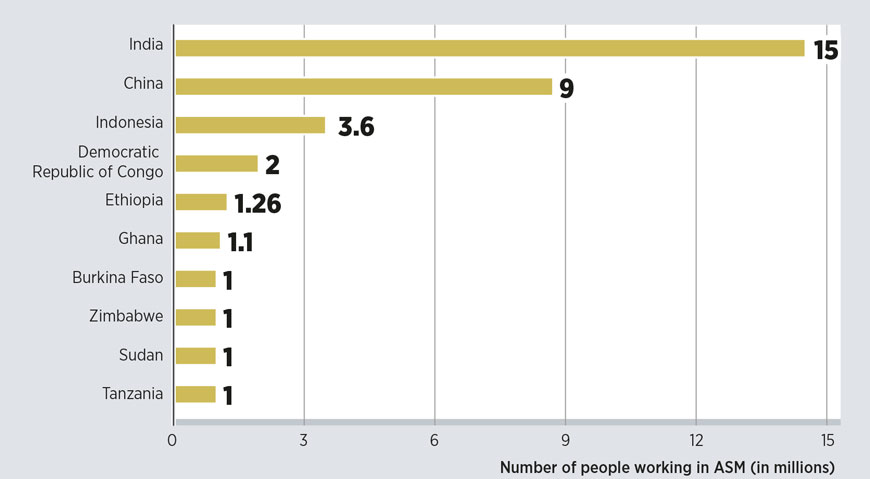
Note: ASM = artisanal and small-scale mining.
Not all mining of energy transition minerals is associated with poor labour conditions. In some cases, mining operations may benefit economically marginalised regions by providing much-needed employment opportunities. For example, the construction of new mines and processing facilities may create jobs in communities affected by deindustrialisation or economic downturns. In 2021, the US Department of Energy awarded USD 19 million for initiatives to produce rare earth elements and other critical materials in fossilfuel- dependent communities, including the Appalachian region, which had been hit hard by the coal industry downturn (US DOE, 2021).
The move to net-zero emissions presents a significant challenge to the mining industry and dependent communities. While coal dominates the industry in terms of volume and value, its decline is inevitable. By contrast, the demand for energy transition minerals such as cobalt, lithium and nickel could grow. While these minerals may not fully replace coal earnings, they can help offset losses for mining companies, allowing them to adjust their portfolios and allocate capital accordingly. However, for coal workers and communities, the transition will be viable only if mineral deposits are nearby.
3.2 Climate, land and water security
Climate change
The energy transition is a crucial response to the threat of climate change, which could potentially multiply threats to geopolitical stability. At the same time, the metals and mining sector is responsible for 10% of the global greenhouse gas emissions, of which 7% is due to steel production, 2% is due to aluminium production and the remainder is due to the production of the other metals (KU Leuven, 2022) – which includes emissions from the mining and processing of critical materials. 13
For most metals, smelting and refining are responsible for the bulk of greenhouse gas emissions. For countries where smelters and refineries are located, the electricity mix is therefore a major determinant of their overall emissions. Today, a significant share of minerals and metals is refined in China and other countries with a coal-based grid.
The scale of emissions varies significantly among minerals. Energy consumption and greenhouse gas emissions per tonne are especially substantial for aluminium, cobalt, nickel, silicon and rare earth elements. Annual energy consumption and emissions are the highest for aluminium, due to the large annual production volumes. Aluminium demand in the energy sector is driven by solar photovoltaic (87%) and wind (10%) deployments, while the demand for cobalt, graphite, lithium and nickel production primarily comes from energy storage technologies, notably, batteries.
Renewable energy technologies emit only a fraction of the greenhouse gases emitted by fossil fuel technologies, even though their mineral intensity is high. Mineral production and operation of clean energy technologies generate a 6% of the emissions from coal- and gas-based generation (World Bank, 2020b). For instance, battery electric vehicles emit significantly less in total than traditional internal combustion engine vehicles over their life cycles, even though they require more minerals than the latter (IEA, 2021).
It is possible to further reduce emissions from mineral mining and processing through increased energy efficiency investments and a shift to cleaner fuels and low-carbon electricity. In 2022, the Canadian mining company First Quantum Minerals announced plans to construct 430 megawatts (MW) of solar and wind power for its copper mining operations in Zambia, which includes Africa’s two largest copper mines (Hill and Mitimingi, 2022). Meanwhile, Anglo American, a mining giant, has secured renewable energy deals to meet all its power requirements for Chile-based copper operations from 2021, Brazil-based iron ore and nickel operations from 2022 and Peru-based copper operations from 2022 (Anglo American, 2021). The same company has also launched a prototype of its first hybrid hydrogen- and battery-powered mine haul truck, a retrofitted diesel-powered truck, at its Mogalakwena platinum mine in north-eastern South Africa (Anglo American, 2023).
End-of-life management (reuse, repurpose, recycle) also plays a role in emissions reduction. It can significantly reduce emissions related to mineral mining, even if it may not eliminate them completely. For instance, recycled secondary aluminium can have a carbon footprint that is only 5% of the carbon footprint of primary aluminium production (European Aluminium, 2020). 14 Increasing recycling can aid in the shift towards a more sustainable energy system, although there remain obstacles, such as ensuring mineral scrap availability and maintaining material purity for certain applications. It is also important to reduce the emissions intensity of recycling processes (IRENA, forthcoming). As the energy transition progresses and technologies reach end of life, material recovery and reuse will also contribute to reducing emissions along the value chain.
Land use, biodiversity and waste
Mining is a widespread activity with extensive impacts on the Earth’s surface. Besides mines themselves, mining areas also include waste dumps, water ponds and industrial processing facilities (Maus et al., 2020). Mining activities can have a wide range of adverse effects on landscapes and give way to land use conflicts.
Over the past two decades, metal mining has expanded into biodiverse ecosystems (Luckeneder et al., 2021). This has contributed directly and indirectly to deforestation, with coal and gold responsible for 71% of all global direct mining-related deforestation (WWF, 2023). The development of mining-related infrastructure, settlements, agriculture through settlements, and water and soil contamination caused 7% of the global indirect deforestation (Hund and Reed, 2019).
While mining activities extensively impact forests, they can also impact other biodiverse ecosystems, such as grasslands, wetlands and aquatic habitats, causing soil erosion, soil and water pollution, and loss of habitat for endangered species. Such environmental impacts of mining have often led to land use conflicts between mining companies and local communities and conservation groups, resulting in legal battles or violence in some cases.
Mining can also compromise land access security through the waste and pollution it generates. Mining produces the largest volumes of waste globally, in various forms, for example, overburden (the soil or rock covering a mineral deposit), waste rock (the material extracted along with the ore) and tailings (waste generated from processing). A 2016 estimate showed that metal and mineral extraction generated over 70 billion metric tonnes of waste rock and over 8 billion tonnes of tailings in that year (Figure 3.4).
Declining ore grades have already increased the volume of waste generated per unit of mineral produced (Mudd, 2010). The increase in mineral and metal extraction will lead to a further increase in mining waste. Producing 1 metric tonne of copper generates approximately 540 tonnes of waste rock and 200 tonnes of tailings (Baker et al., 2020). 15 Copper, nickel, manganese and lithium mining could generate nearly a trillion tonnes of waste combined from 2020 to 2050 (Valenta et al., 2023).
FIGURE 3.4 Estimated volume of tailings, waste rock and ore produced in 2016
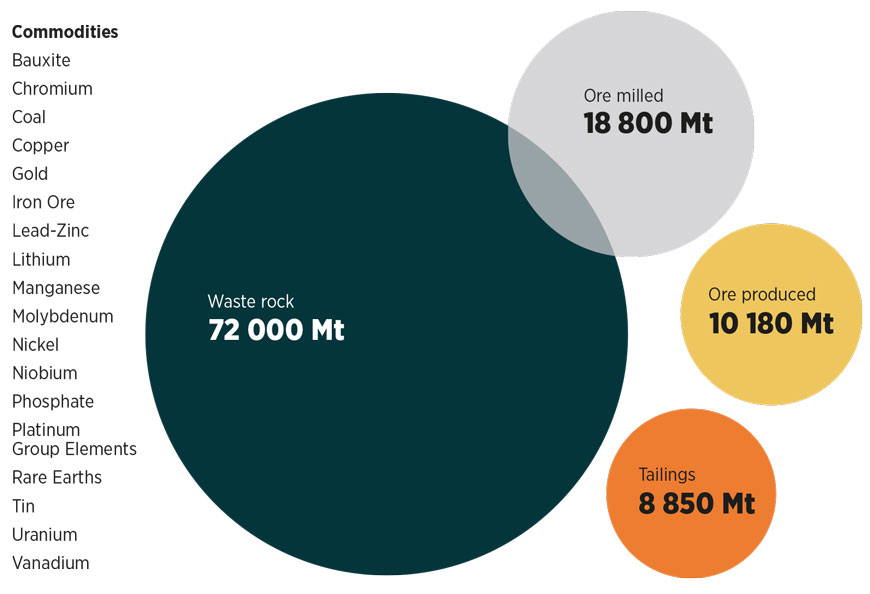
Overburden and waste rock are either deposited on site or transported to designated off-site areas for disposal. By contrast, tailings are typically stored in ponds contained by dams, which could rupture, causing extensive ecological damage and threatening nearby communities (Roche et al., 2017). Also, the toxic substances within the tailings can endanger the environment and local wildlife. The 2019 Brumadinho dam disaster at an iron ore mining complex in Minas Gerais, Brazil, is an example of how catastrophic such events can be. The dam failure spilled some 10 million cubic metres of mine waste, killing 270 people and causing enormous damage to the environment and local communities (Piciullo et al., 2022). As solutions to managing tailings on site, some mines pump them directly into nearby water bodies, such as river systems or oceans, causing extensive pollution (see Box 3.3).
BOX 3.3 The controversial practice of marine disposal of mine tailings
Marine disposal techniques are prohibited in many countries but continue to be used at several coastal mining sites including in Indonesia, Norway, Papua New Guinea and the Philippines. 16
At the Ramu nickel and cobalt mine in Papua New Guinea, located in the South Pacific, mining waste is dumped directly into the ocean. Concerns were raised about the potential contamination of fish and other seafood after several pipeline leaks at the refinery caused the ocean water to turn crimson red. In response, the Madang provincial government instituted a fishing ban in October 2019, depriving local populations of one of their main sources of livelihood. In 2020, over 5 000 villagers and the local government filed a lawsuit against the operators of the Chinese-owned Ramu nickel mine, demanding an end to the practice of dumping waste into the ocean (Sanderson, 2022).
The lawsuit is just one example of the growing opposition to the use of marine disposal of mine tailings. Environmental and community groups have long raised concerns about the impacts of these practices on marine ecosystems and human health. The potential harm includes the release of toxic metals and chemicals into oceans, which can accumulate in marine life and seafood consumed by humans.
This led several countries to ban or restrict the marine disposal of mine tailings, and international standards for tailings management were established to protect people and environment bodies from harm (e.g. the standards set by the International Council on Mining and Metals). Mining companies are encouraged to explore alternative methods to manage tailings, such as dry stacking, which involves filtering and drying the waste to produce a more stable material that can be stored on land.
Stringent waste management policies can reduce local pollution from the excavation, transport and processing of critical materials. Efforts should promote the adoption of advanced technologies and best practices that prioritise the reduction, reuse and recycling of waste materials, while ensuring that potentially harmful by-products are treated and disposed of properly (GlobalTailingsReview.org, 2020; ICMM, 2021, 2022a). Comprehensive reclamation and rehabilitation programmes can be implemented alongside waste management programmes to restore disturbed mining sites to a state that aligns with ecological and community well-being. Mining companies can contribute actively to the preservation and restoration of biodiversity and ecosystem services by investing in post-mining land restoration, including reforestation efforts and the re-establishment of natural habitats (Prach and Tolvanen, 2016).
Water stress
Critical material mining projects can exacerbate water stress. About half of the global copper and lithium production, for example, is concentrated in high-water-stress areas (Gielen et al., 2022b; IRENA, forthcoming). This includes the “lithium triangle”, a lithium-rich (65% of the world’s lithium reserves) region in Andes encompassed by the borders of Argentina, Bolivia and Chile.
Globally, seven water-stressed mining hotspots stand out: Central Asia, the Andes region, Australia, the Middle East, southern Africa and a large zone in western North America (Figure 3.5).
Mineral ore mining and processing have substantial water requirements for pumping, treating, heating and cooling operations. While the overall use of freshwater for mining activities is only a small portion of the global and national water use, they can significantly impact local freshwater resources by degrading their quality and reducing the quantity of water available (Meißner, 2021). Mining activities such as tailings disposal into waterways, acid rock drainage and waste rock dumps can also contaminate surface and groundwater bodies (AY et al., 2018). As ore grades continue to decline, more water is required to produce a tonne of metal. This can further strain local water supplies and bring areas already facing significant water stress under greater water risks. Climate change is expected to compound water scarcity, posing a significant challenge to the mining industry (Northey et al., 2017).
FIGURE 3.5 The majority of mining sites face high water risks
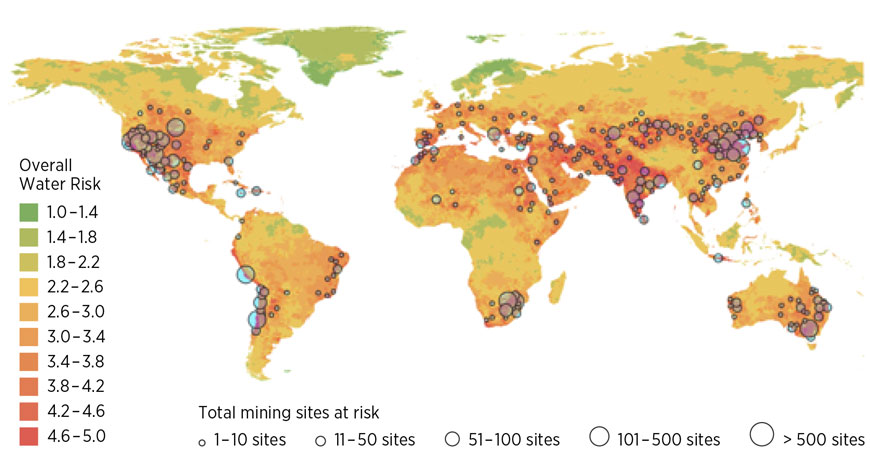
Note: The World Wide Fund for Nature’s water risk assessment framework considers three types of basin and operational water risks: physical, regulatory and reputational. More information on the methodology can be found at https://riskfilter.org/water/explore/data-and-methods.
Disclaimer: This map is provided for illustration purposes only. Boundaries and names shown on this map do not imply any endorsement or acceptance by IRENA.
BOX 3.4 Water security, lithium extraction and indigenous peoples in Chile’s Atacama desert
Lithium can be extracted from hard-rock ores or from continental brines through evaporation, which is especially water intensive. The socio-environmental impacts of the brine evaporation technique are most visible in Chile’s Salar de Atacama, where the world’s largest brine-based lithium production is based.
In the evaporation technique, brine, which is salty, lithium-containing water, is pumped from underground reservoirs into large, open-air ponds for lithium to separate via solar evaporation, which can take months. Ninety percent of the brine’s original water content is lost through the evaporation process (Vera et al., 2023). Hydrologists are raising a growing concern that mining activities could significantly impact vital ecosystems and deprive indigenous communities of their essential water sources, exacerbating the desert’s arid conditions (Pearce, 2022).
These and other concerns have resulted in increased calls for water justice, and protests against the mining operations (Jerez et al., 2021). Local residents, including indigenous communities such as Kolla, Atacameño, Lickanantay and Aymara, have used a variety of tactics, including legal action, roadblocks and demonstrations, to protest the threat to their livelihoods and water security (Lunde Seefeldt, 2022).
3.3 A new development path
Mining and the developing world
Global production of key energy transition metals is predominantly occurring in developing countries (World Mining Data, 2022), although some of them have much smaller shares of global production than reserves (Figure 3.6). For example, Guinea’s share in the global extraction of bauxite, a key metal for aluminium production, is just 6.5%, whereas it represents 63% of global reserves. The Plurinational State of Bolivia has 21 million tonnes of lithium resources – more than any other country – but it produced less than 1% of the global supply in 2021. One key issue is that many developing regions remain underexplored and lack basic geological mapping. This creates a commercial risk for mining companies (African Minerals Development Centre, 2018).
FIGURE 3.6 Share of global mineral production and reserves held by developing countries (excl. China), 2017
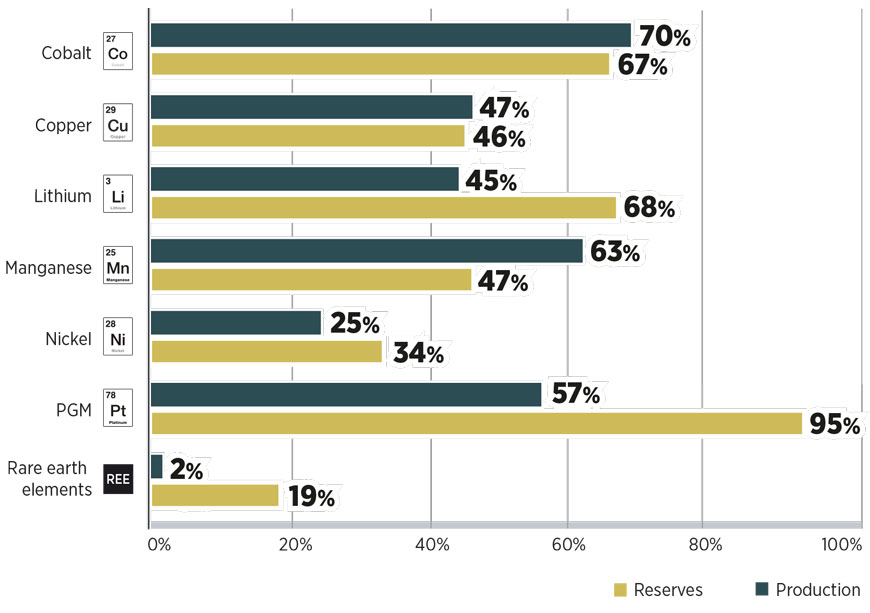
Note: Developing countries comprise low- and middle-income countries, excluding China. PGM = platinum group metals.
While base metals may not be as significant as oil in global economic activity, they are important in the economic activity of about one-third of emerging markets and developing economies (World Bank, 2021), of which some rely heavily on export revenues from their mining. More than 80% of the export revenues of Botswana, the Democratic Republic of Congo and Guinea, for instance, is derived from the mining sector (see Figure 3.7).
FIGURE 3.7 Export dependence on mining, 2018-2019
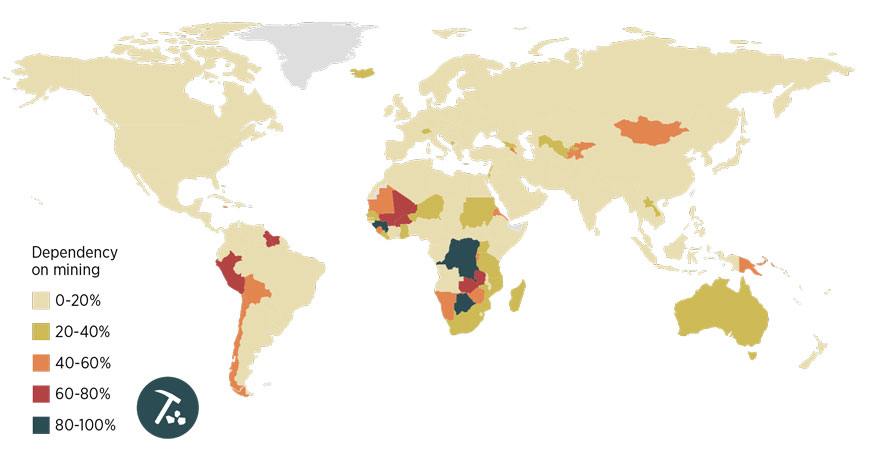
Disclaimer: This map is provided for illustration purposes only. Boundaries and names shown on this map do not imply any endorsement or acceptance by IRENA.
Bucking the resource curse
Developing countries often struggle to fully benefit from their valuable mineral resources, a phenomenon known as the “resource curse”. This term refers to the paradoxical situation where natural-resource-rich countries tend to have slower economic growth, higher poverty levels and weaker governance than resourcelimited countries. This is often due to factors such as overdependence on a single sector of the economy, rentseeking approaches and corruption.
With a growing mineral demand, urgently addressing these risks becomes crucial for stable and sustainable supply. Corruption in mineral supply chains is one such risk (National Resource Governance Institute, 2022). The extractives value chain can have corruption at any point, including in the issue of exploration and exploitation licenses, as well as the collection of royalties, fees and taxes (OECD, 2016). Corruption risks are especially high in the award of mining rights as companies rush to secure licenses, and officials may face pressure to compromise on environmental and social impact assessments, and due diligence in general, to speed up approvals (Clark, 2023).
Another challenge lies in the opaque tax structures within transition mineral value chains, which incurs significant revenue losses for governments (Sturman et al., 2022). Base erosion and profit shifting pose governance challenges as multinational enterprises shift their profits to jurisdictions with lower tax rates. This issue is especially prevalent in the energy transition minerals sector, where integrated business structures and global partnerships control value chains. Unfair pricing arrangements made before production can incur substantial revenue losses for host governments. Research indicates that multinational enterprise tax avoidance leads to annual losses of approximately USD 600 million in corporate income tax from mining sectors for Sub-Saharan African countries alone (Albertin, Giorgia. et al., 2021).
Addressing corruption and tax evasion requires emphasising the significance of well-designed policies and institutions for effectively investing mineral revenues in socio-economic development. Historical insights provide valuable lessons on how countries can avoid the resource curse and maximise the benefits of their mineral resources. Examples from the past demonstrate that the negative impacts of mineral dependency can be mitigated through economic diversification, promotion of local content development, investment in infrastructure and human capital, and fostering inclusive governance structures (The African Climate Foundation, 2022). Successful cases can provide countries with lessons to learn in fostering industrial development and economic diversification.
A geo-economic opportunity
The expected surge in mineral resource demand due to the energy transition and digitalisation presents an opportunity for attracting new investment flows. If managed properly, these new resource revenues could kick-start long-term economic prosperity, new green jobs and sustainable local development.
A key question is whether the energy transition allows developing and emerging countries to move up the value chain and attract higher-margin activities in addition to increasing their primary ore exports. Processed materials command significant price premia over unrefined ores, potentially improving the trade balance and lowering the input cost of infrastructural and industrial projects, spurring local economic development (Hendrix, 2022).
While many battery minerals are mined in developing countries in Africa, Asia and Latin America, the actual value-addition work, such as smelting, refining, cell assembly and ultimately EV production often takes place elsewhere. As Figure 3.8 illustrates, the mining of nickel, lithium and cobalt has only a 0.6% share in the total EV value chain (1.1% if metal smelting and refining are included).
Climbing up the value chain is politically and economically appealing but challenging for many developing countries, which often lack the necessary infrastructure, technical expertise and access to other production factors, such as a skilled workforce and affordable power. Inadequately regulated expansion of domestic processing and refining capacity in these countries may amplify the environmental and social impacts of sourcing the raw materials used in EVs and other vital energy transition technologies (Jones et al., 2023).
FIGURE 3.8 Estimated value of the battery mineral and electric vehicle value chain by 2025
Highlights
- Many countries are developing strategies to mitigate the vulnerability of critical material supply chains. These strategies aim to secure access to materials, promote domestic production, and reduce dependence on any single supplier or region.
- Some efforts often have no-regret outcomes, including the formulation of national critical material strategies, periodic assessment of mineral criticality, and the promotion of diplomatic alliances and partnerships.
- Other efforts may involve trade-offs or risks. For instance, many countries aim to localise critical material supply chains. The European Union targets 10% domestic mineral extraction and 40% local processing by 2030, whereas the United States’ Inflation Reduction Act incentivises domestic sourcing and the formation of friendly relationships with suppliers of minerals used in electric vehicles. Achieving these goals requires balancing economic, environmental and social considerations.
- Strategic stockpiling of materials requires careful consideration to prevent market tightness and price increases, which could slow down the global transition to clean energy. Stockpiling could also hinder supply chain diversification and local value creation since not all countries can maintain large reserves.
- Efforts to reduce, reuse and recycle materials have accelerated alongside attempts to enhance the robustness of supply chains, which can be relieved from pressure through energy efficiency, energy conservation and consumer behavioural changes. However, recycling only shows promise in the medium to long term since significant stock turnover is required before secondary supply becomes substantial.
- Developing countries are taking steps to maximise the benefits from their mineral resources. Export restrictions, in particular, are gaining attention as a means to attract processing and other downstream industries, although they do not guarantee success. Countries could capture greater mineral wealth shares through regional co-operation.
- Although several initiatives and regulatory frameworks have been created to urgently promote responsible, sustainable and transparent mineral supply chains, compliance will be difficult to enforce even where standards for supply chain due diligence, auditing and certification are already established. Most related initiatives are voluntary, and standards need to be aligned with validation mechanisms and processes.
This chapter provides a comprehensive overview of the initiatives undertaken by global public and private entities to ensure a reliable, equitable critical material supply (Table 4.1). It seeks to offer insights to policy makers, industry stakeholders and other key actors by examining the strengths and limitations of each strategy.
TABLE 4.1 Strategies to ensure a reliable and equitable critical material supply
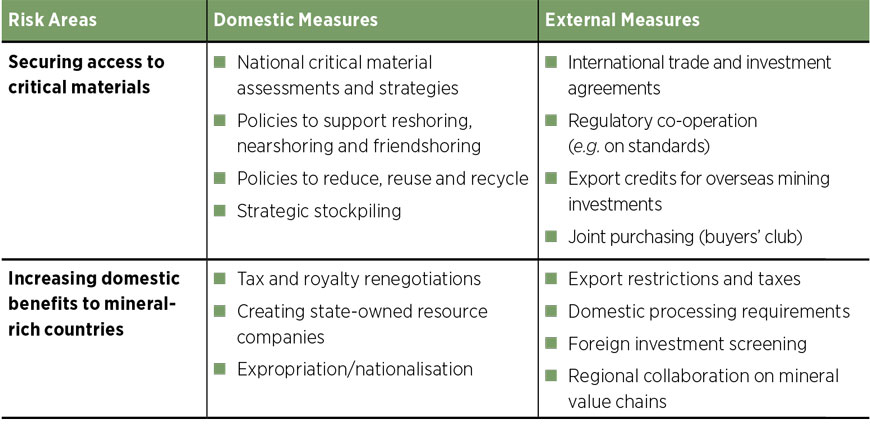
4.1 Mitigating supply chain vulnerability
The concentration of critical material mining and processing in a handful of countries has raised concerns about the reliability of global supply chains, prompting governments and stakeholders to develop strategies to mitigate their vulnerability. These strategies aim to secure access to critical minerals and materials, promote domestic production, and reduce dependence on any single supplier or region.
This section will explore five key approaches:
- Developing critical mineral strategies
- Localisation and redesign of supply chains
- Critical material diplomacy
- Strategic stockpiling
- Reducing, reusing and recycling.
Critical mineral strategies
A growing number of countries recognise the strategic importance of mineral supply chains and are compiling or updating national critical material strategies (Box 4.1 and Figure 4.1). For countries dependent on such materials’ imports, the primary objective is to anticipate and offset potential supply risks, whereas mineralrich countries seek to boost the competitiveness of their mining sectors and attract investments.
FIGURE 4.1 Countries that have adopted national mineral strategies, 2010-2023
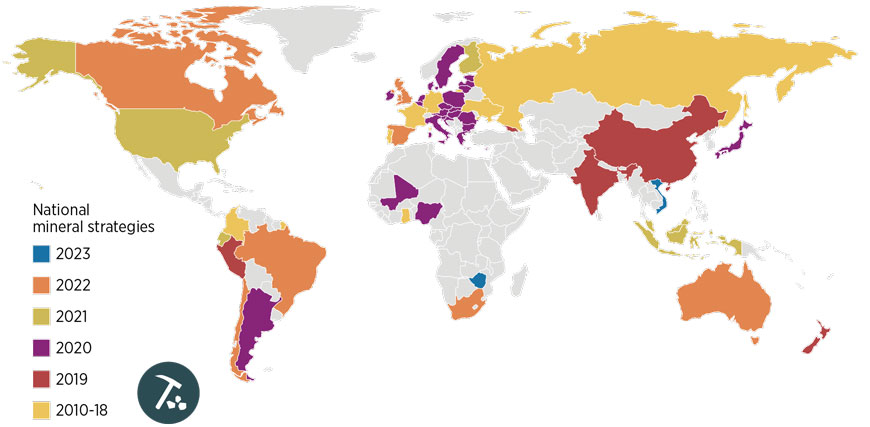
Disclaimer: This map is provided for illustration purposes only. Boundaries and names shown on this map do not imply any endorsement or acceptance by IRENA.
BOX 4.1 Critical material strategies recently updated or adopted
Australia: It first adopted a Critical Minerals Strategy in 2019, updating it in 2022. The strategy has a central objective to turn Australia into a “global critical minerals powerhouse” by 2030 and expands the critical minerals list to include high-purity alumina and silicon, recognising their importance in technologies such as lithium-ion batteries and semiconductors. It aims to boost regional jobs and growth through a thriving mineral sector, and help Australia move into downstream processing and capture highervalue- added products. 17
Brazil: In 2021, it launched the National Strategic Pro-Minerals Policy (Ministry of Mines and Energy, 2021), which aims to prioritise the environmental licensing process and the implementation of mineral-mining projects deemed strategic for the country’s development. It also created an Interministerial Committee for the Analysis of Strategic Mineral Projects, which identified a list of 14 strategic minerals (CTAPME Resolution No. 2/2021), including lithium, cobalt, nickel, graphite and rare earth elements. In 2022, the Brazilian president signed a decree to establish a national mineral policy and create the Mineral Policy National Council (Decreto n. 11.108).
European Union: In 2023, the European Commission proposed the Critical Raw Materials Act, which was built on the 2008 Raw Materials Initiative and the 2020 Action Plan on Critical Raw Materials. The regulation sets out four objectives: (1) strengthening the European Union’s capacities along all stages of the strategic raw materials value chain, including extraction, processing and recycling; (2) diversifying external supply; (3) strengthening the Union’s capacity to monitor and mitigate supply risks; and (4) increasing the circularity and sustainability of critical raw materials consumed in the Union. Regarding the first objective, the regulation set key targets for strategic raw materials in 2030:
- At least 10% extracted in the European Union
- At least 40% processed in the European Union
- At least 15% recycled in the European Union
- Not more than 65% of the European Union’s annual consumption of each strategic raw material at any relevant stage of processing from a single third country.
The regulation also sets out a framework to select and implement strategic projects – both within and outside the European Union – that would benefit from faster permitting and additional funding. It also creates a European Critical Raw Materials Board to advise the European Commission and member countries, as well as a framework to discuss strategic partnerships with third countries. The Commission will gather information on the strategic stocks held in EU Member States, by public or private entities. It will also set up a system for the joint purchase of critical raw materials from third countries.
India: In 2019, the country adopted its National Mineral Policy, which aims to promote domestic industry, reduce import dependency and feed into the Make in India initiative. It emphasises the need for environmentally sustainable mining practices, stakeholder participation and the equitable distribution of mineral wealth. The policy prioritises support to domestic exploration for minerals critical or strategic for the energy sector (Ministry of Mines, 2019). However, there is no official list of critical/strategic materials for the energy transition.
Japan: In March 2020, Japan adopted a new International Resource Strategy, which covers energy resources such as oil and liquefied natural gas and emphasises the importance of stockpiling rare metals. The state-owned Japan Oil, Gas and Metals National Corporation is tasked with providing loans and other support to overseas minerals development, including exploration, mining and smelting, and through it, the government seeks to strengthen co-operation with countries involved in various stages of the supply chain (Agency for Natural Resources and Energy, 2020).
South Africa: In April 2022, the South African government released its Exploration Strategy and Implementation Plan for the Mining Industry, 18 which aims to attract foreign investment in exploration, accelerate new mineral discoveries and promote the responsible use of the country’s mineral resources, in accordance with environmental, social and corporate governance principles. It aims to spend more than 5% of the global expenditure on exploration in the next three to five years, and streamlines regulatory requirements across licensing departments to improve turnaround time for processing prospecting rights. It also provides a list of targeted critical minerals and metals deemed essential for the shift towards a green economy.
United Kingdom: In July 2022, the UK government adopted its Critical Mineral Strategy, whose central aim is to mitigate risks and make critical mineral supply chains more resilient through what it dubs an “A-C-E approach” to critical minerals: Accelerate domestic capabilities (in mining, training recycling), Collaborate internationally (mainly to foster supply diversification) and Enhance international markets (including increasing market transparency and responsible supply chains). In March 2023, a delivery update was published, which reviewed progress and set out upcoming milestones. One of these is the launch of the independent Task & Finish Group on Critical Minerals Resilience for UK Industry, which will present a report by 2023 end. 19
United States: The country has long approached critical materials strategically, 20 and has been guided in recent years by multiple executive orders. In 2017, President Trump issued such an order, which tasked the Department of Commerce to develop a federal strategy on critical materials (Executive Office of the President, 2017), released in June 2019. The strategy’s six calls to action include accelerating domestic critical mineral resource development and building robust downstream manufacturing capabilities (US Department of Commerce, 2019). In another executive order in 2020, Trump determined that the country’s reliance on critical minerals from foreign adversaries constituted an “unusual and extraordinary threat”, and declared a national emergency to deal with the threat (White House, 2020). The US Department of Energy was to devise a strategy to ensure a secure and reliable supply of critical minerals, which it issued in 2021 (US Department of Energy, 2021). The strategy relies on three key pillars: diversifying supply, developing substitutes, and improving reuse and recycling. In 2021, the Biden administration issued Executive Order 14017, which outlined the importance of secure supply chains and mandated 100-day interagency reviews (White House, 2021). Parallel to these executive orders, the legislative branch adopted relevant legislation, such as the American Mineral Security Act (2020) and the Infrastructure Investment and Jobs Act (2021), which, among other things, allocated federal funding for critical mineral extraction processing and research activities. The Inflation Reduction Act of 2022 is discussed in Box 4.2.
As part of their national critical mineral strategies, countries are compiling lists of critical minerals based on their industrial needs and a strategic assessment of supply risks. Evaluations of mineral criticality differ by country (see Table 4.2). For example, only nine materials feature on the critical material lists of the United States, the European Union and China, including cobalt, lithium, graphite and rare earths. Copper and platinum group feature on just two lists.
TABLE 4.2 A comparison of the critical mineral listings in China, the EU and United States, 2023
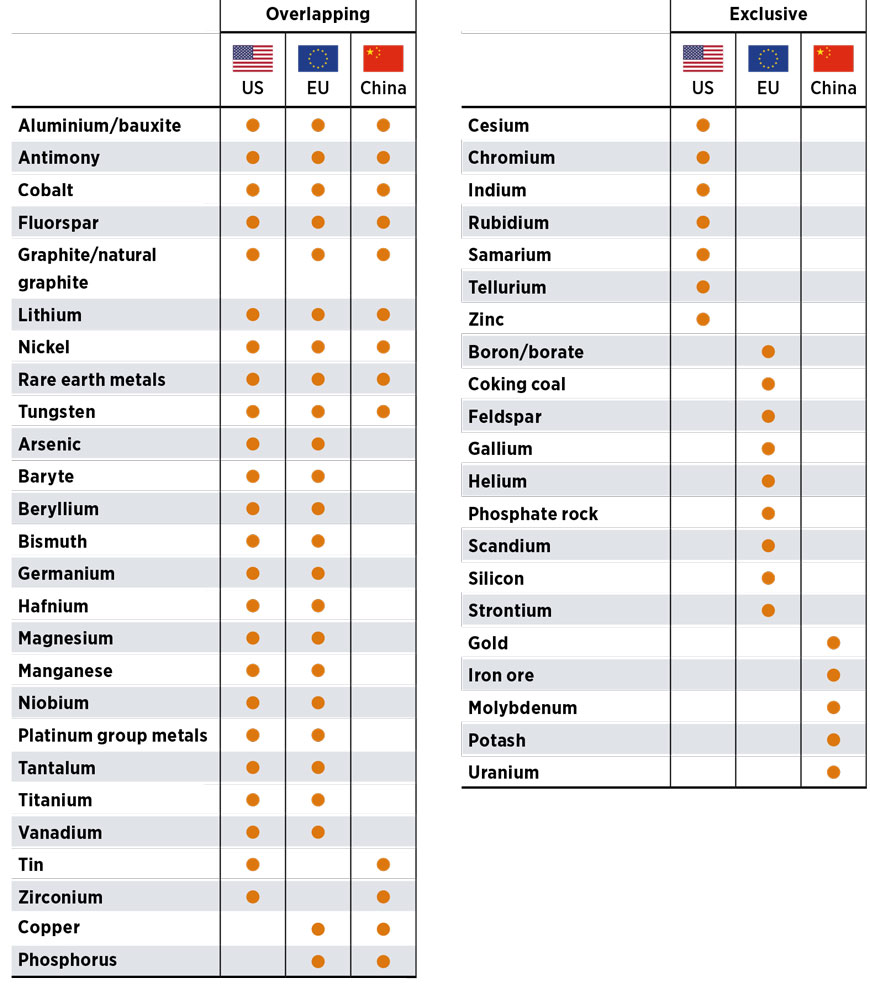
Critical materials lists are dynamic and require updating as circumstances change. For instance, the first list the EU published in 2011 featured only 14 raw materials. The list has been updated four times since, with the 2023 version identifying 34 raw materials as critical.
Localisation and redesign of supply chains
Recent supply chain disruptions have driven many countries and regions to pursue supply chain localisation for greater strategic autonomy and for reducing dependence on potential adversaries. More specifically, governments are formulating policies to encourage strategic industries to either relocate or establish new operations in their home countries (reshoring), in nearby regions (nearshoring) or in trusted ally nations (friendshoring). Critical and strategic mineral supply chains are also covered by these efforts.
The United States and the EU recently outlined minimum thresholds for the domestic sourcing of minerals. The EU proposed at least 10% local mineral extraction and 40% local processing by 2030. The US Inflation Reduction Act, signed into law in August 2022, provides tax credits for critical mineral production and mandates the domestic sourcing or friendshoring of the critical minerals used in EV batteries as a condition for subsidies (see Box 4.2).
BOX 4.2 The Inflation Reduction Act and critical minerals
Following are the key provisions on minerals of the Inflation Reduction Act (IRA):
- Mining companies extracting critical metals will be able to seek a production credit equal to 10% of production costs if the extracted minerals meet specified purity thresholds.
- The IRA also sets a target for the critical mineral content of EV batteries. For an EV to be eligible for a tax credit in 2023 (the first year of the programme), 40% of the critical materials in its battery must be sourced domestically in the United States, from local free-trade partners, 21 or from recycling in North America. 22 The percentage increases gradually to 80% by 2027 and beyond (US Government Publishing Office, 2022).
- The IRA further stipulates that an EV is not eligible for a tax credit if its battery contains “any” critical mineral sourced from so-called “foreign entities of concern”.
Countries can encourage domestic mining, refining and recycling using policy tools to streamline administrative processes, expedite planning and permitting procedures, and increase public funding to bolster domestic investments in critical material value chains. These tools could also be applied to trusted international allies through international partnerships (see next subsection).
Such policies can make supply chains robust, reduce geopolitical risks, and increase national and regional strategic autonomy. However, they also entail significant risks, such as increased costs, reduced economies of scale and potential retaliatory measures from affected countries. Reshoring and nearshoring may imply higher costs than sourcing from distant, low-cost suppliers. An illustration of this risk is the US mining company Molycorp, which reopened its California rare earth mine in 2012 but filed for bankruptcy in 2015 when it could not support its high costs due to global low prices. 23 Policies to encourage domestic mining may also require trade barriers, which could affect trade relations and raise concerns about protectionism. Adopting reshoring, nearshoring, friendshoring and associated policies requires careful assessment of the trade-offs and costs to balance economic considerations, trade objectives and energy transition priorities.
Further, efforts to rewire these supply chains will require a delicate balance between economic considerations, environmental concerns and local communities’ welfare. For decades, the environmental and human costs of mining and processing minerals like lithium and rare earths have largely been hidden from the view of the citizens of many countries, including industrialised economies. Countries will have to confront these tradeoffs as they look to diversify their supply chains. For instance, one of the key issues in current discussions on the European Union’s Critical Raw Materials Act is whether strategic mining, refining and recycling projects should be designated as projects of overriding public interest – meaning they could override environmental laws (Zimmermann, 2023a). Despite ongoing efforts to restructure and broaden critical mineral supply chains, they face notable challenges, such as NIMBY (Not in My Backyard) protests, environmental issues, and long lead times to bring new mining, refining and processing capacities online.
In Serbia, for instance, the development of the Jadar lithium mine (considered one of the world’s largest lithium deposits) has been facing growing opposition, with local communities raising concerns about the mine’s potential environmental impacts, especially in terms of water pollution and the displacement of local communities. Early 2022 saw the mining giant Rio Tinto’s license revoked amid public protests (Sekularac, 2022). Protests such as those in Serbia have also hit other lithium projects in Europe, including in Portugal, Spain and Germany (Caceres, 2023; Zimmermann, 2023b). The discovery of a large rare earth deposit in Arctic Sweden in January 2023 raised concerns among local Sámi communities about the potential impact on reindeer grazing areas (Frost, 2023).
It is not just mining projects that face local opposition. In 2012, Australian company Lynas faced heavy local opposition in Malaysia over the health and environmental risks posed by potential leaks of radioactive waste from its proposed rare earth processing facility in the country. Activists took to the streets, initiated legal action and some even went on hunger strike to stop the project (Feffer, 2023). This delayed the project significantly, even though the facility began operating in 2013. Protests have nevertheless continued, and the Malaysian government wants Lynas to stop the cracking and leaching parts of its operations by mid-2023. These examples underscore the importance of the early and meaningful involvement of local communities, to ensure support and secure long-term benefits.
Critical material diplomacy
Critical raw materials have gained significance in international diplomacy, leading countries to establish new alliances and partnerships to ensure access to these vital resources (see Table 4.3).
TABLE 4.3 International critical material alliances
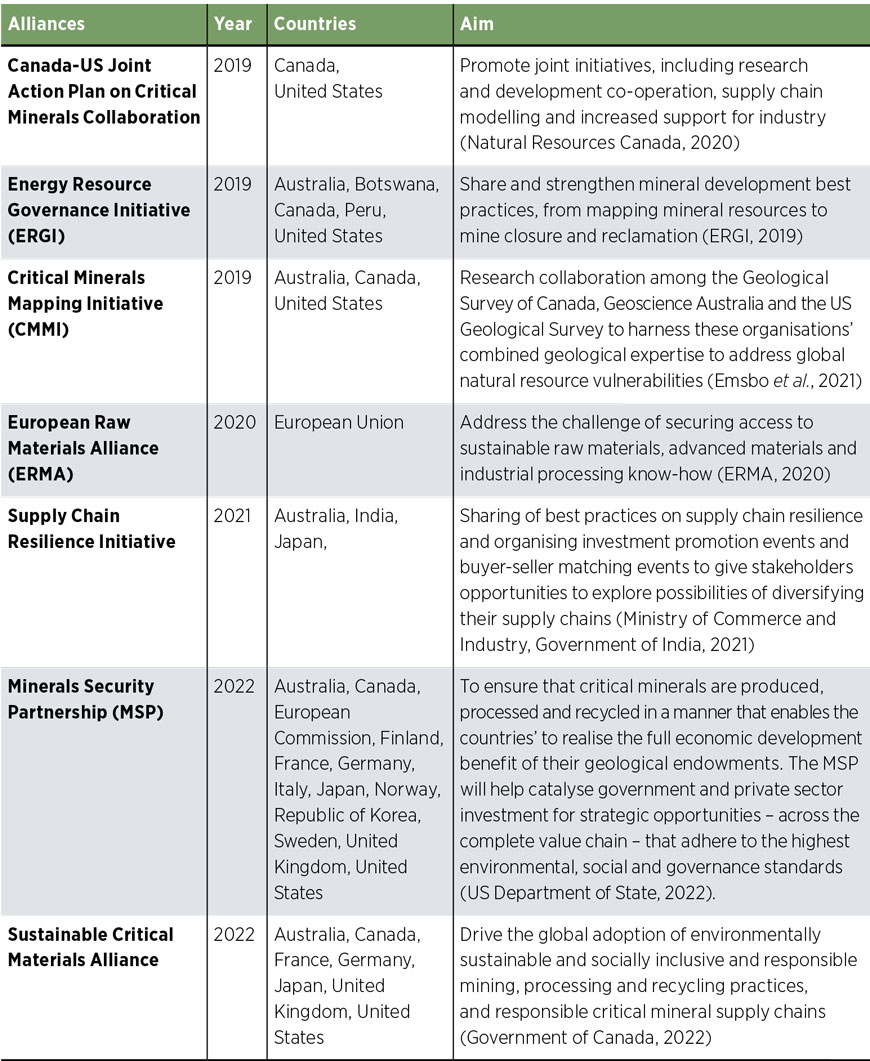
Apart from the alliances listed in this table, the G7 members are also pursuing the idea of creating a buyers’ club for critical minerals. 24 Such an arrangement would focus on ensuring access to critical minerals, while preventing a bidding war between the G7 economies over them (Duehren, 2023). The idea was reaffirmed during a meeting of the G7 climate, energy and environment ministers in Japan, which also resulted in a “Five- Point Plan for Critical Mineral Security”, summarised in Box 4.3 (G7 Hiroshima Summit, 2023).
Some countries have begun supporting overseas mining projects to mitigate the risk of raw material shortages. The United States, for instance, funds roughly a dozen mineral projects abroad, potentially involving mining, mineral processing and recycling, including through the Mineral Security Partnership (Holzman, 2022). Likewise, the Japanese government is seeking to diversify its critical mineral supply chains by encouraging companies to acquire mining interests overseas, having allocated JPY 1.03 trillion (USD 7.8 billion) towards the costs of providing assistance under its Economic Security Protection Act, adopted in May 2022 (Asamina, 2022).
China, the dominant player in critical mineral supply chains, has also been seeking to secure its resource supply lines by building strategic alliances with multiple African countries. This bolstered bilateral trade between Sub-Saharan Africa and China, with the latter receiving minerals and metals as key imports from Africa (see Figure 4.2). China’s “go out” strategy, formulated in 1999, has encouraged Chinese companies to become globally competitive, and it could successfully expand its influence in critical mineral supply chains.
BOX 4.3 The G7’s five-point plan for critical mineral security, 2023
- Forecast long-term supply and demand
- Develop resources and supply chains responsibly
- Recycle more and share capabilities
- Promote innovation in resource saving and substitute technologies
- Prepare for short-term supply disruptions.
FIGURE 4.2 The key role of minerals and metals in China’s trade relations with Africa
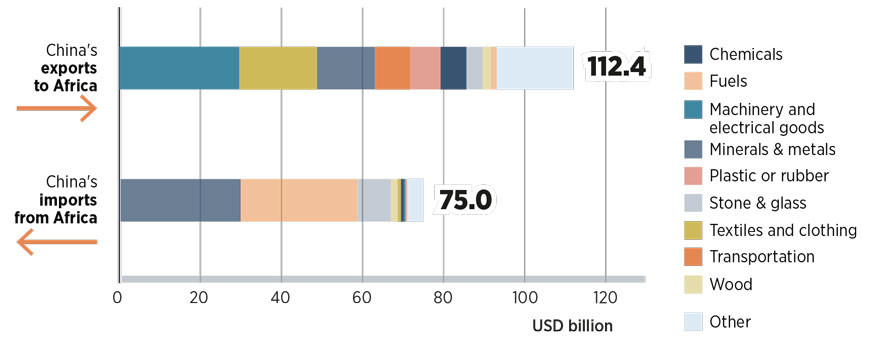
Note: The data are for 2020.
The EU has also been pursuing a raw material diplomacy since adopting its Raw Materials Strategy in 2011. It has committed to forming strategic partnerships and holding policy dialogue on broader topics, such as human rights promotion, good governance, conflict resolution and regional stability, with non-EU countries (European Commission, 2011). It has already forged political agreements on raw materials with countries such as Argentina, Brazil, Canada, Chile, China, Colombia, Egypt, Greenland (Kingdom of Denmark), Japan, Mexico, Morocco, Peru, Tunisia, the United States, Uruguay and the African Union (Directorate General for Internal Market, Industry, Entrepreneurship and SMEs, European Commission, n.d.).
A balanced and co-operative approach in foreign policy engagement requires addressing the obligations of importing states to support sustainable development and moving beyond extractives patterns in critical material supply chains. This entails fostering partnerships, advocating responsible sourcing practices, supporting capacity building in producing countries, promoting transparency and accountability, and investing in sustainable initiatives. These concrete steps can help importing states contribute to equitable and sustainable development, ensuring a more inclusive and mutually beneficial approach to procuring critical materials.
Strategic stockpiling
Strategic stockpiling is an emergency tool for governments to cope with potential shortages of key fuels and commodities. Industrialised countries such as China, Japan, the Republic of Korea and the United States have established stockpiles of strategically important imported commodities. 25 Stocks are also held by private companies, traders and metal exchanges for price hedging and supply chain management. However, reliable data on the size and location of these stocks, and their utilisation are currently unavailable (Wilburn et al., 2016).
Strategic stocks of petroleum are often used as an analogy in public debates, although it is worth noting that stockpiling raw materials for clean energy manufacturing differs from stockpiling combustible fuels, which is more comparable to hoarding steel for building oil drilling rigs. For instance, a country facing restrictions on gallium would mean its thin-film solar panel manufacturers would be impacted, just as steel restrictions would impact drilling rig builders. However, gallium’s unavailability would not prevent existing solar panels from functioning, even though a few companies would face significant impacts (Krane and Idel, 2022).
Stockpiling could also limit the speed and scale of the energy transition. Although manufacturing and construction of energy assets require critical materials to be available, not all countries possess the financial or other resources to maintain strategic reserves. Stockpiling can therefore have an unintended impact of impeding supply chain diversification and hindering countries from reaching their potential in local value creation. This raises the question of the effectiveness of stockpiling energy transition minerals compared to stockpiling in some other sectors.
So far, the US government, which possesses the largest public stockpiles, has refrained from stockpiling these commodities for purposes other than defence. The United States began stockpiling critical minerals in 1939, under the provision of the Strategic Minerals Act. It built inventories of 42 commodities critical to its defence efforts and expanded them further in the early 1950s in response to fears of shortage due to the Korean War (National Research Council, 2008). Some inventories reached extreme levels. For instance, by the early 1970s, its strategic tin stock corresponded to a full year of global consumption (Radetzki et al., 2020). Materials from the stockpile have been released on only ten occasions between 1945 and 2008 (National Research Council, 2008). In recent years, and especially since the 1990s, the US National Defence Stockpile has mainly sold excess material.
In China, strategic stockpiling of metals falls under the remit of the State Reserve Bureau (SRB), a government agency created in 1993. The workings of the SRB are not publicly disclosed, although it is known that it buys and stores minerals in vast quantities when prices are low and releases them into the market when prices increase. As such, it has become an influential force in international markets. For example, in 2020, the SRB bought refined copper in substantial quantities, helping to boost its price amid the COVID-19-induced economic slowdown (Home, 2021).
Considering minerals’ strategic importance, many countries recently strengthened their stockpiling policies. An example can be found in 2020, when Japan’s new International Resource Strategy raised the target number for stockpiles to 60 days, and up to 180 days for minerals with higher geopolitical risks (Agency for Natural Resources and Energy, 2020). Also, in 2021, the Republic of Korea announced that it would increase its stockpiles of 35 critical metals, for example, cobalt, nickel and rare earths, to cover 100 days of consumption, up from 56.8 days previously (Byung-wook, 2021).
It is worth noting that not all major industrial regions have implemented strategic stockpiling policies. For instance, the recently proposed Critical Raw Materials Act in the EU does not enforce mandatory stockpiling. Instead, it encourages voluntary measures, while also requiring member countries to submit reports on their respective policies. The idea of mandatory stockpiling faced resistance from some companies considering it could bring already strained supply chains under more pressure (Burton, 2023).
Building strategic stocks can indeed be with challenges. It could exacerbate market tightness and ratchet up prices if done without adequate consideration. An example of this can be found in 2010, when many Japanese companies held rare earth stockpiles amid a crisis, and expanded them in the immediate aftermath of the embargo. This helped drive the price bubble, which lasted until the end of 2011 (Sprecher et al., 2015). Unnecessary precautions by companies could lead them to face market consequences. An example of this is the US car company Ford, whose concerns about rising palladium prices drove it to stockpile it in large quantities in 2000. The prices fell soon after, causing the company a USD 1 billion loss (White, 2002). Stockpiling can also run into more practical problems. Highly reactive metals such as magnesium are prone to corrosion and degradation, while alkali metals such as lithium can ignite or explode when exposed to air or water. Therefore, any stockpiling strategy should be pursued with careful assessment of possible impacts and regular review of circumstances and developments.
Reducing, reusing and recycling
Efforts to reduce, reuse and recycle critical materials are gaining momentum as solutions to make supply chains more robust, support the transition to a circular economy and reduce these materials’ environmental impacts (Gielen, 2021b).
Energy efficiency, conservation and behavioural change could effectively relieve pressure on critical material supply chains. For example, battery chemistry optimisation for EVs could be accompanied by another strategy, which is focused on EV demand reduction (e.g. through better public transport, encouraging cycling and walking, or incentivising telework) and optimisation of the existing fleet (e.g. through car or ride sharing schemes, or reducing the vehicles’ mass and aerodynamic drag) (Lovins, 2022). Further, governments can implement regulations to reduce the production and consumption of single-use products, which could reduce the demand for critical materials. These behavioural changes can be significant in ensuring the sustainable production and use of critical raw materials, while also mitigating the environmental impacts of their extraction and processing.
The demand for critical materials can also be reduced by improving product design, developing new materials with lower criticality, and implementing circular business models that prioritise durability and reuse (Babbitt et al., 2021). For example, transitioning to low-cobalt battery designs can reduce the geopolitical, social and environmental risks and costs associated with the cobalt supply chain. However, such substitutions typically come with trade-offs in terms of new resource dependencies (e.g. shifting to nickel) or loss of battery performance.
Recycling and reuse of critical materials can also relieve pressure on primary supply sources and prevent the associated environmental damages, considering they consume less energy and generate lower emissions than primary extraction (Gregoir and van Acker, 2022). Contrary to fossil fuels and other single-use materials, metals have permanent physical properties, making them indefinitely recyclable in theory. For some materials, recycled sources already constitute a major proportion of the global supply. Approximately 40% of copper and steel are produced from recycled materials. For other common materials, such as aluminium, lead and zinc, over 30% of production presently uses recovered inputs (Bureau of International Recycling (BIR), 2021).
However, recycling rates are much lower for other metals. For example, in the EU, only about 20% of platinum and cobalt is obtained from secondary (recycled) sources; this rate is 5% or less for most other critical materials, and close to zero for gallium, indium and rare earths (European Economic and Social Committee, European Commission, 2020). Increasing the end-of-life recovery of critical materials from lowcarbon technologies often encounters technical challenges, collection issues and economic barriers (IRENA, forthcoming; Karali and Shah, 2022).
When considering recycling as a potential solution to supply risks, it is important to examine the timescale of stock turnover. A substantial secondary supply is possible only when there is a substantial stock of materials in active use that are nearing their end of life. However, such conditions are unlikely to be met until about the mid-2030s, especially in the case of battery EVs and their associated minerals (Zeng et al., 2022). Recycling should thus be regarded as a medium-to-long-term strategy to bolster supply security.
4.2 Increasing domestic benefits to mineral-rich developing countries
Strategies for optimising value retention in host countries
Developing countries are taking steps to optimise the benefits from their mineral resources, often utilising their bargaining power to secure better terms for mineral extraction. An example of this can be found in 2018, when the Democratic Republic of Congo renegotiated foreign access to cobalt reserves to secure a more favourable agreement. Also, Peru reformed its copper royalty regime in 2021 to increase government revenue from the mining sector. Further, the Chilean government plans to create a state-owned company for lithium, “Lithium for Chile”, to ensure greater state control over the country’s lithium reserves and ensure that Chile receives a fair share of the value generated by its resources.
Several developing countries also aspire to capture greater value from their mineral resources. Indonesia, for instance, has banned the export of unprocessed nickel to encourage value added activities within its borders (see Box 4.4), while Zimbabwe has banned raw lithium export to curb artisanal mining and attract downstream industries (Banya, 2022). Many more developing countries have implemented export taxes and non-automated licensing procedures.
However, export restrictions cannot guarantee support to downstream processing for any country. A study examining the use of various mineral and metal export restrictions by four African countries found these restrictions to create no benefit for downstream industries (Fliessi et al., 2017). One explanation is that mineral processing typically consumes large amounts of energy, which is often supplied inadequately or unreliably in developing countries, especially those that have underdeveloped grids and a large part of the population without electricity access. These higher value added activities also employ a labour force with higher skills than in the extractive sector, and they require more capital. Attracting sufficient investments and capital to build more elaborate local supply chains is often a challenge for developing countries.
Mineral-rich developing countries have a natural advantage in extraction but not necessarily processing. Mining activities are concentrated in specific locations, which are determined by geology. However, downstream industries have greater flexibility in terms of location. Bulk shipping makes it possible to locate refining and processing operations thousands of miles away from mining sites, in areas with more favourable energy supply, better environmental conditions, greater political stability and more affordable capital access (Hendrix, 2022). Since some of these advantages stem from historical disparities, an approach geared towards inclusive development would nevertheless seek to expand processing capacities in the developing world.
BOX 4.4 Lessons from Indonesia’s nickel export ban
Indonesia holds the world’s largest nickel reserves, which it leverages to attract investment along the battery and EV supply chain. In January 2014, it banned the export of unprocessed nickel and bauxite ores, mandating their processing domestically. Under the law, only companies committed to building a smelter were granted an export license. The mineral export ban did not restrict which companies, foreign or domestic, could qualify by building smelters in the country (Terauds, 2017).
The ban contributed to a brief, sharp increase in international nickel prices in the first half of 2014, although prices quickly receded amid a general commodity slump. Following a budget deficit in 2016, the ban was put on hold, and reintroduced in January 2020.
While the ban meant short-term loss of export earnings, mining jobs and government revenues, it has been rather successful in its long-term objective of attracting new investment in nickel processing and nurturing a downstream industry. Prior to the export ban, Indonesia had only two operating nickel smelters. By 2020, the number had risen to 13, and many more are being planned (Huber, 2021). The country has attracted more than USD 15 billion of foreign investment in nickel processing (see Figures 4.3 and 4.4).
FIGURE 4.3 Foreign investment (USD billion) in Indonesia’s nickel production facilities, 2022
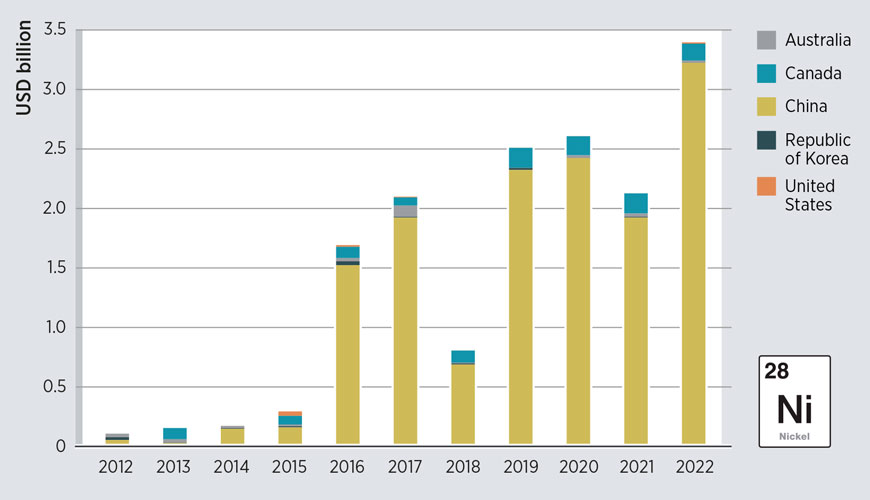
FIGURE 4.4 Indonesia’s export of raw nickel and nickel products (in USD billion), 2021
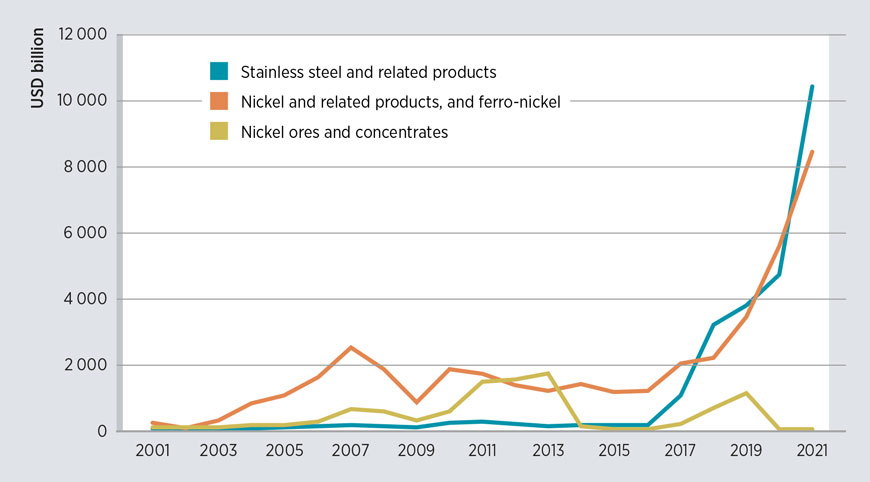
Metal sector investments in Indonesia have focused on turning the country’s nickel ore into nickel pig iron, which is then fed into stainless steel production. The government however seeks to climb the nickel value chain further, having a long-term goal to develop a full EV supply chain, including the production of cathodes, battery cells and EVs (Kim, 2023). There have been some initial successes. For example, the Republic of Korea’s LG Energy Solution is building a USD 1.1 billion battery cell plant, while carmaker Hyundai opened a plant to assemble electric cars. China’s CATL, the world’s largest battery manufacturer, has invested in the country, while Tesla and BYD have either signed or are finalising investment deals (Maulia and Damayanti, 2023; Ruehl, 2023).
While other commodity-dependent developing countries might take inspiration from Indonesia’s nickel export ban, they should tread with caution for at least four reasons:
- The ban’s relative success was largely due to the non-substitutability of Indonesian laterite nickel ore in the nickel pig iron process. By contrast, the ban on bauxite ore exports failed to attract new smelting activity, merely shifting the ore’s extraction to other countries, such as Malaysia. From this perspective, the Indonesian example suggested that it is preferable to avoid a comprehensive export ban on commodities for which there are ready substitutes (Terauds, 2017).
- Nickel also represented a relatively small share of the Indonesian economy; it was thus less risky to institute an export ban on nickel than on a more strategic resource, such as copper. For countries whose main commodity exports represent a more sizeable share of their economy, an export ban would be considerably riskier (Terauds, 2017).
- The nickel export ban has come at certain costs. In the first three years after it was imposed, it was estimated to have incurred losses of USD 4.5 billion in export earnings, 30 000 mining jobs and USD 270 million in government revenues (Terauds, 2017). While these losses need to be offset against subsequent gains, such as new investment in nickel refining capacity, such costs must be accounted for when considering policy options.
- Indonesia’s success in attracting nickel refining activities has come with environmental and social costs. A growing number of projects rely on the so-called high-pressure acid leaching (HPAL) technique, which produces substantial waste compared with traditional smelting techniques (Tan, Sijabat and Irwandi, 2023).
- There are also legal risks. A World Trade Organization panel recently ruled in favour of the European Union’s protest against Indonesia’s nickel ore export ban (WTO, 2022), but Indonesia will now appeal the ruling (Strangio, 2022).
Mineral-rich developing countries seeking to climb up the mineral value chain may face trade barriers. Developed countries often place higher tariffs on manufactured goods than raw materials (a process known as “tariff escalation”). Future import tariffs may be tied to emissions, as under the European Union’s Carbon Border Adjustment Mechanism, which, in terms of metals, will initially cover only steel and aluminium, even though its product scope may be extended to cover copper, zinc, nickel and silicon, among others. The production of these minerals is now subject to a carbon price under the European Union’s Emissions Trading Scheme, while they are exposed to a significant risk of carbon leakage, just like aluminium or steel (European Commission, 2020).
Building regional value chains for EV battery minerals
Regional co-operation could help countries capture a greater share of the value from producing minerals. Mineral-rich countries could benefit from co-ordinated regional agreements to ensure fulfilment of the conditions for foreign investments, rather than pursuing one-on-one deals with often foreign companies.
Regional co-ordination is also important in terms of attracting downstream industries. Only a handful of countries have all the minerals to produce EV batteries. This means that pooling mineral supplies would benefit the majority of countries if they were to build downstream industries. Moreover, developing countries could also create bigger markets. Proximity to downstream consumer markets is an important success factor in attracting higher-margin activities in the battery-EV value chain – probably more important than proximity to mineral resources. The production of “battery precursor material” – chemicals that are precursors to making battery cathodes – is more viable if located near a cluster of other chemical plants. The next step in the value chain, battery cathode production, is best located near battery cell manufacturers, because cathodes are difficult to transport (Diene et al., 2022).
The United Nations Economic Commission for Africa has identified several opportunities for developing regional battery mineral and EV value chains that span across Central Africa and into East and Southern Africa (Pedro, 2021). A concrete example of regional value chain development is the Southern African Development Community’s Industrialization Strategy and Roadmap 2015-2063. Also, the Democratic Republic of Congo and Zambia have signed an agreement to facilitate value chain development in the EV battery and clean energy sectors (UNECA, 2022). Asia and Latin America are also seeing regional co-operation on mineral value chains.
4.3 Promoting responsible, sustainable and transparent mineral supply chains
The growing recognition of sustainability challenges associated with the mineral supply chain, especially pertaining to EV battery material production, has prompted global governments, businesses and civil society groups to develop a vast array of initiatives and regulatory frameworks, which seek to address pressing sustainability risks, including those related to human rights, labour practices, corruption and environmental impacts, among others.
While these initiatives show significant overlaps, they vary in terms of the actors and organisations to which they apply, the initiatives’ scope (e.g. applicable only to specific mine sites or entire value chains), the minerals covered and the compliance mechanisms involved. They are mostly limited to voluntary adherence, resulting in a patchwork of supply chain management standards, which risks sowing confusion for stakeholders (Elkind et al., 2020). While a full overview of all efforts to promote responsible, sustainable and transparent mineral supply chains is beyond the scope of this report, some of the public, multi-stakeholder and private initiatives that are most relevant to transition minerals are discussed below.
Public sector standards and legislation
The United Nations’ UN Guiding Principles on Business and Human Rights (United Nations Human Rights Office of the High Commissioner, 2011) is particularly notable. They guide businesses on how to respect human rights throughout their operations and supply chains, with a focus on due diligence, risk assessment and remedies for human rights abuses. Various UN agencies, for example, the International Labor Organization, have developed sustainable mining standards. Finally, the Sustainable Development Goals are also relevant to the mining sector in multiple ways, as shown in Figure 4.5.
FIGURE 4.5 Mining and the Sustainable Development Goals
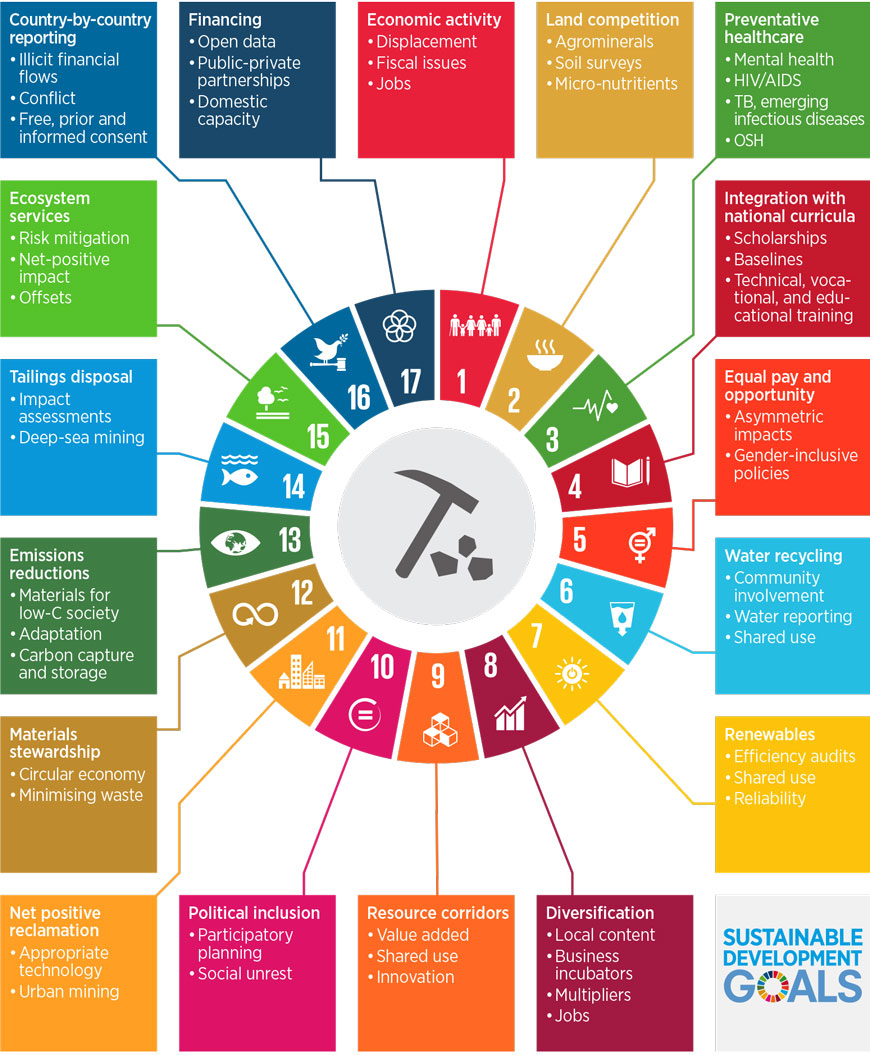
Notes: AIDS = acquired immunodeficiency syndrome; C = carbon; HIV = human immunodeficiency virus; OSH = occupational safety and health; TB = tuberculosis.
Likely the most widely referenced international standard is the Organisation for Economic Co-operation and Development’s (OECD, 2016b) Due Diligence Guidance for Responsible Supply Chains of Minerals from Conflict-Affected and High-Risk Areas (hereafter “OECD Minerals Guidance”), which provides companies with a supply chain due diligence framework for sourcing minerals from conflict-affected and high-risk areas. The guidelines, which are voluntary, cover several issues, including supply chain traceability, risk assessment and stakeholder engagement, and the 46 signatory states – representing 85% of foreign investment – are mandated to operate a government complaint mechanism (Whitmore, 2021).
The OECD Minerals Guidance has been integrated into several regulatory frameworks (notably in the United States and the EU, as well as in producing and trading countries such as the Democratic Republic of Congo, Rwanda and the United Arab Emirates), industry guidelines and market requirements. For example, the China Chamber of Commerce of Metals, Minerals & Chemicals Importers & Exporters (closely associated with the Ministry of Commerce and with over 6 000 members, whose annual import and export value represents about 30% of China’s total import and export value) has integrated OECD standards into Chinese standards. Also, in 2022, all metals traded on the London Metal Exchange, including aluminium, cobalt, copper, tin, nickel, zinc and lead (most of them essential for the green and digital transitions) were brought under mandatory due diligence following the OECD Minerals Guidance. 26
Considering international standards provide a global reference point for the trade, it is worth mentioning the International Standards Organization (ISO), an independent, non-governmental international organisation with 167 national standardisation bodies as members. Since 1955, it has a technical committee for mining, which develops standards for mining activities. Since 2015, two new ISO committees on metals and materials have been created at the request of SAC (Standards Administration of China; the Chinese standardisation body on rare earths and on lithium). These technical committees, which are now led by the SAC, develop standards for the classification, traceability (from mine to final products), packaging and chemical analysis methods for those materials. Seven standards have been published on rare earths, and nine standards on rare earths and 14 standards on lithium are under development (ISO, 2023a, 2023b). Also, Association Française de Normalisation, the French standards body, recently proposed to create a technical committee for 14 additional critical materials, including cobalt, graphite and palladium (ANSI, 2023).
Countries’ active participation in international standard development is essential for their involvement in trade and reaping its benefits. While the ISO technical committee on lithium has all major lithium mining and refining countries as members, several countries engaged in rare earth mining and refining are not yet its part – these include, notably, Estonia, a major refining country, and the United Republic of Tanzania and Myanmar (not a full ISO member), a major mining country.
Apart from these international initiatives, the mineral supply chain is also regulated by many national and regional regimes. These include the EU Conflict Minerals Regulation, which came into effect in 2021 and requires companies to conduct due diligence on their supply chains and effectively identify and mitigate risks when sourcing minerals from conflicted and high-risk areas (Directorate-General for Trade, European Commission, 2017). The regulation only applies to 3TG (tin, tantalum, tungsten and gold) minerals, not to other energy transition minerals, such as cobalt, graphite, nickel and lithium. Other examples include Section 1502 of the US Dodd-Frank Act (which requires companies listed on US stock exchanges to disclose whether their products contain conflict minerals [3TG minerals]), the UK Modern Slavery Act of 2015 and the Dutch Child Labour Due Diligence Act, adopted in 2019.
The European Union’s upcoming Batteries Regulation aims to bring battery raw materials under stringent sustainability standards to ensure their sustainability throughout their life cycle, from their sourcing to their collection, recycling and repurposing. The regulation includes carbon intensity and recycling quotas and due diligence, and will ensure that batteries can be repurposed, remanufactured or recycled at the end of their life (European Commission, 2022).
Multi-stakeholder initiatives
There is a global increase in multi-stakeholder initiatives to promote responsible sourcing, sustainable production and transparency in the critical raw material supply chain. An example in this regard are the widely used Global Reporting Initiative (GRI) sustainability reporting standards for large corporations (UNEP, 2020). In addition to the general standards, the GRI has a special guidance document, which sets performance indicators for disclosures in the mining and metals sectors (GRI, 2023).
Another notable example is the Responsible Minerals Initiative (RMI), which aims to advance responsible mineral sourcing by developing and implementing standards, tools and programmes for companies and suppliers. While the RMI initially focused on the 3TG minerals, which are often associated with human rights abuses and conflict, it now covers all mineral supply chains (RMI, 2021). The RMI includes auditing and certification programmes, supply chain due diligence tools and capacity-building programmes for suppliers.
The Global Battery Alliance (GBA), a multi-stakeholder initiative launched in 2017 by the World Economic Forum, provides another framework, which ensures responsible mineral sourcing and production, covering areas such as human rights, labour practices, environmental management and community engagement. The GBA seeks to create a sustainable and responsible battery value chain by prioritising the mitigation of social and environmental impacts related to the extraction, processing and disposal of battery materials. It has developed a set of guiding principles to reach this goal. It also works to promote transparency and traceability in the supply chain, and encourages stakeholder collaboration to drive systemic change (GBA, 2017).
The Extractive Industries Transparency Initiative (EITI) establishes a global standard for the transparent and accountable management of natural resources. The EITI aims for greater transparency and seeks to reduce corruption, encouraging governments, companies and civil society organisations to work together to disclose information on the revenues generated from the extraction of minerals and other resources. The EITI gradually included environmental issues in its work, revising its standard in 2019 to also encourage implementing countries to disclose information on the management and monitoring of extraction’s environmental impacts. EITI’s standard is currently implemented by over 50 countries.
The above initiatives are far from the only ones. Table 4.4 shows other selected multi-stakeholder governance initiatives to govern transition minerals.
TABLE 4.4 Selected multi-stakeholder mineral governance initiatives
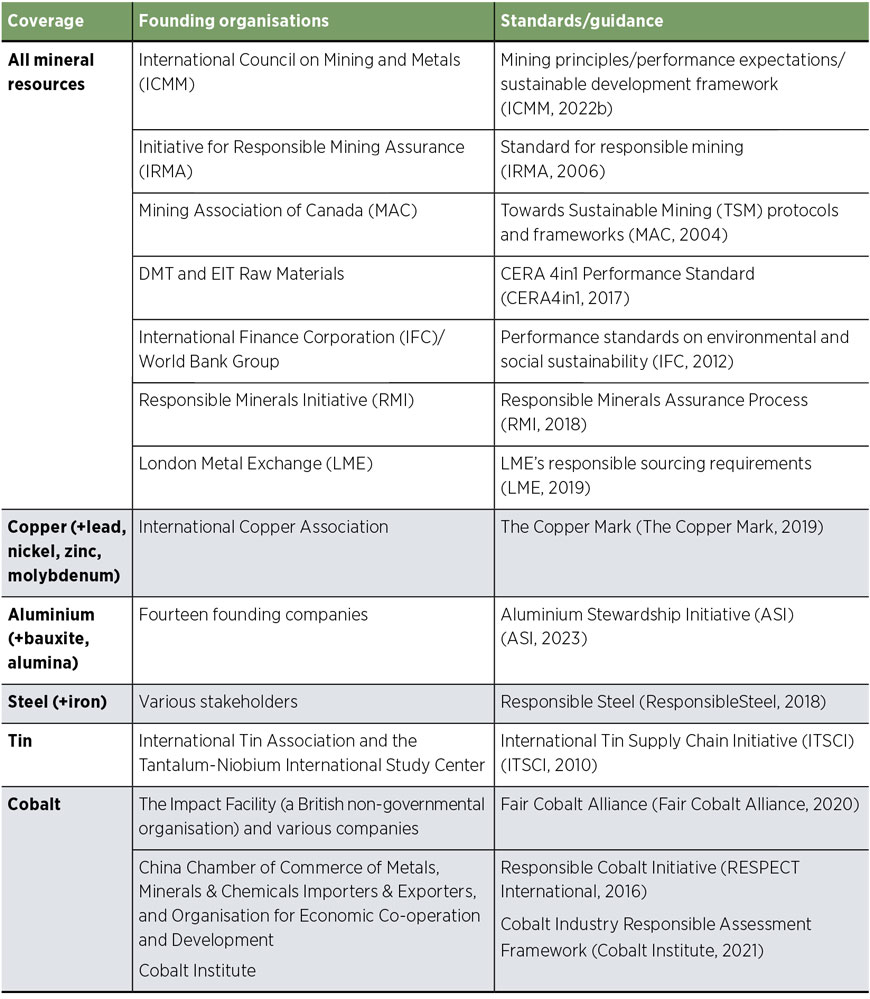
Private, corporate actions
Apart from multilateral and multi-stakeholder initiatives, many companies have their own programmes to source critical materials responsibly. Given below are some examples:
- Tesla will source its cobalt and other critical minerals only from suppliers meeting its environmental and social standards. It is also developing new battery chemistries to reduce its reliance on cobalt for its batteries.
- Apple has developed a responsible sourcing programme, which requires its suppliers to follow stringent environmental and social standards, and covers several critical minerals, including cobalt, tantalum, tin, tungsten and gold. Apple works to promote responsible mining practices through its participation in the RMI.
- Ford has developed a sustainable materials strategy, which focuses on critical minerals such as cobalt, lithium and rare earths. It is working to identify and address environmental and social risks in its supply chains and is collaborating with suppliers to promote responsible sourcing practices.
- Rio Tinto has developed a responsible sourcing programme, which covers several minerals, including copper, aluminium and diamonds, and focuses on human rights, environmental sustainability and community engagement. The programme involves working with suppliers to address risks and improve practices.
- BMW has established a sustainability programme, which focuses on the responsible sourcing of critical minerals such as cobalt and lithium. BMW works with suppliers to promote sustainable practices and has committed to using only certified sustainable raw materials in its products by 2030.
- Volkswagen has created a comprehensive sustainability programme, which focuses on the responsible sourcing of critical minerals such as lithium and cobalt. Volkswagen works with suppliers to ensure they comply with its environmental and social standards, and it also invests in new technologies to reduce its reliance on critical minerals in its products.
- Umicore ensures sustainable procurement of battery materials (cobalt, lithium, nickel) through a framework, which includes transaction and logistical systems, quality checks, chemical fingerprinting and stakeholder engagement.
Holistic approaches
Existing approaches to the responsible sourcing of critical materials, especially traceability schemes, have limitations. To be effective, these schemes must establish trust, ensure authenticity and minimise potential system loopholes (Sovacool et al., 2020). Presently, these schemes are often voluntary, and lack cohesion and robust enforcement mechanisms.
Traceability schemes could be made more effective by potentially including appropriate sanctions, penalties, compensation and remediation mechanisms in response to violations. This would likely require greater involvement from public institutions and governments. However, even with stronger government participation and enforcement, traceability systems alone have inherent limitations. They tend to prioritise reputational risk mitigation for corporations in critical material value chains rather than transformative social change (Kügerl et al., 2023; Sovacool et al., 2020) and are, thus, not comprehensive solutions to the underlying issues at hand.
For instance, one critical consideration in responsible sourcing initiatives is the unintended impact on vulnerable participants within the supply chain, such as artisanal and small-scale miners, who often face economic uncertainty, job insecurity, and bear a disproportionate burden of human rights violations and environmental harm. Merely safeguarding their livelihoods falls short of addressing the systemic problem, which requires engaging in inclusive dialogue encompassing the fair distribution of risks, inputs, creative contributions and the resulting value.
While there is a proliferation of regional, national, and industry-led initiatives on how to address various supply chain challenges there is still no overarching intergovernmental framework to address global sourcing, production and trade of critical materials. With the growing importance of these materials for the energy transition and beyond, co-ordinated policy action is becoming increasingly important. A global effort under the auspices of the United Nations could play a key role in ensuring that the critical material value chains are fair, equitable and transparent.
Policy considerations and the way forward
IRENA’s Global Commission on the Geopolitics of Energy Transformation noted in its 2019 report that bottlenecks in critical materials were on the radar of policy makers (GCGET, 2019). Critical materials were already perceived to be scarce - in part because, like all commodity markets, these markets are cyclical. When demand rises, supply takes time to respond, particularly as new mining projects have long lead times. The Commission noted the geological abundance and wide distribution of material reserves, recognising that they are often expensive and polluting to mine and produce.
This report echoes the initial observations from the Commission. With the pressure to accelerate the energy transition in line with the 1.5°C pathway, a vast deployment of energy transition technologies is required by 2030. IRENA’s World Energy Transitions Outlook (WETO) estimates that an average of 1 000 GW of renewables will need to be deployed annually. WETO also emphasises that enabling infrastructure will be essential to accommodate high shares of solar and wind, cross border electricity trade, electrification of end uses such as transport, and green hydrogen production and trade. Combined, these technologies are dramatically increasing demand for critical materials.
It is widely recognised that the supply chains for many critical materials are concentrated in a few countries and in the hands of a limited number of companies. This concentration creates vulnerabilities and uncertainties for both consuming and producing countries that could affect the deployment, cost and sustainability of energy transition technologies. However, security of supply is only part of the story. IRENA has consistently urged a holistic approach to all aspects of the energy transition to proactively shape outcomes and manage risks. This is particularly important in the pursuit of critical materials, given a legacy of poor labour standards, displacements, polluted waterways and degraded land in the communities in which mines operate. Moreover, the growing demand for critical materials opens new opportunities for developing countries rich in resources - especially to capture greater economic value. Additional economic, social, environmental and geopolitical implications may also emerge as critical material markets expand. It is therefore essential that the diversification of critical materials supply chains is achieved both quickly and prudently. Some of the key considerations for policy makers are outlined below.
Comprehensive, economy-wide evaluations of critical material demand are essential to identify
potential risks and help avoid competition between sectors.
Countries should carefully assess the effects of surging demand for critical materials across all economic
sectors, in line with their net-zero strategies. Currently, most demand for these materials comes from
sectors unrelated to the energy transition, including electronics, aviation, defence, healthcare, and steel and
aluminium production. However, the demand landscape is quickly evolving with the rollout of renewable
energy technologies, batteries and electric vehicles. Furthermore, the modernisation and expansion of grids
are contributing to the increase in material use. In the short to medium term, it will be important to maintain
visibility on how the growing demand for materials in energy will impact overall demand in order to assess
possible trade-offs and strategies, and avoid competition between sectors and industries.
No country alone can fulfil its demand for all critical materials, so collaborative strategies that benefit
all involved need to be developed and implemented.
Given the extensive lead times for establishing new mines and processing plants, concentrated supply
chains are expected to persist in the near future. Countries should aim to develop dual strategies to ensure
co-operation to keep markets functioning while also working to diversify supply chains in the long term. Many
bilateral, regional and industry-led initiatives focus on supply chain challenges, which could be leveraged for
co-ordinated policy action. At the global level, IRENA’s Collaborative Framework for Critical Materials is an
established platform to exchange knowledge and best practices, and co-ordinate actions to ensure that
minerals and materials continue to sustain an accelerated energy transition.
Comprehensive assessments of critical materials should be conducted for each mineral to fully grasp
the dependencies, risks and innovations that may affect supply and demand.
Despite the long list of identified critical materials, not all are equally important for the energy transition,
nor are their criticality assessments consistent. For instance, innovation has resulted in an increased use of
substitute materials for those considered critical, such as neodymium, copper, and lithium. Policy makers
should continue to foster innovation to decrease dependency on particular materials and tackle specific
challenges associated with each one. along the entire supply and demand chains. Regular revisions and
evaluations of critical material lists are also necessary due to the rapid innovations occurring in production.
Geopolitical risks can be mitigated through enhanced investment in research and development, which
would expedite the creation of alternative solutions, boost efficiency, and expand recycling and
repurposing options.
Several strategies can be employed to prevent major supply challenges leading up to 2050, with a focus
on this decade. Key among these are product design strategies to minimise the use of critical materials,
and the recycling and reuse of products to reclaim scarce materials. Recent trends are promising, such as
battery manufacturers minimising their reliance on critical material supplies. Policy makers should support
innovations that lower demand and foster a circular economy to ensure long-term material security.
Greater data transparency and oversight of certain critical materials are required to mitigate uncertainty
in supply and demand projections.
The starting point should be the collection of more detailed information and data on reserves, production,
investment, and pricing, among other factors, to track current supply and increase market transparency.
The adoption of international quality standards and certification for key products involving critical
materials could also facilitate market formation. This effort should be accompanied by the development
and regular updating of demand scenarios, providing greater visibility into potential gaps and the impacts
of innovation. Any short-term policy actions, such as stockpiling, should be carefully assessed to avoid
unintended impacts on climate action.
Developing countries can tap into their mineral resources and retain more economic value, forming the
cornerstone of a diversification strategy that also contributes to global equity and stability.
In addition to policy that can ensure domestic value added and promote green industrialisation, diversification
of supply chains must include a strategy for trade and cooperation between developed and developing
countries. A balanced and co-operative approach in foreign policy engagement requires the importing states
to support industrial development in developing countries beyond extractive patterns in critical material
supply chains. This entails fostering partnerships, including with the private sector, advocating responsible
sourcing practices, supporting capacity building in producing countries, promoting transparency and
accountability, and investing in sustainable initiatives. These concrete steps can help importing states
contribute to equitable and sustainable development, ensuring a more inclusive and mutually beneficial
approach to procuring critical materials, while securing the long-term resilience of material supply chains.
International co-operation is crucial in creating transparent markets with coherent standards and
norms, grounded in human rights, environmental stewardship and community engagement.
The energy-driven mineral boom offers a chance to rewrite the legacy of the extractive industry. Known
issues surrounding mining practices need a proactive response from both nations and corporations. Importer
and exporter countries must collaborate to develop supply chains that uphold clear standards regarding
human rights, environmental concerns and community engagement. These standards are essential to human
security and their absence is one of the root causes of geopolitical instability. In this regard, mining corporations
should be held accountable for the responsible management of extraction processes. This requires engaging
in inclusive dialogue encompassing the fair distribution of risks, inputs, creative contributions and resulting
value. A global effort under the auspices of the United Nations could play a key role in ensuring critical
material value chains are fair, equitable and transparent.
References
- Abraham, D.S. (2017), The elements of power: gadgets, guns, and the struggle for a sustainable future in the rare metal age, Yale University Press, New Haven.
- African Climate Foundation (2022), Geopolitics of Critical Minerals in Renewable Energy Supply Chains, The African Climate Foundation, Cape Town, https://africanclimatefoundation.org/wp-content/ uploads/2022/09/800644-ACF-03_Geopolitics-of-critical-minerals-R_WEB.pdf (accessed 15 May 2023)
- African Minerals Development Centre (2018), Desktop Review of African Geological Survey Organisation Capacities and Gaps, Economic Commission for Africa, Addis Ababa, Ethiopia, https://archive.uneca. org/sites/default/files/PublicationFiles/desktop_review_of_african_geological_survey_organisation_ capacities_and_gaps_2018.pdf (accessed 4 May 2023)
- Agatie, C. (2023), "Tesla Might Enter Mining Business After All, As It Mulls Sigma Lithium Buyout" https://www.autoevolution.com/news/tesla-might-enter-the-mining-business-after-all-as-it-mulls-sigma-lithium-buyout-210540.html (accessed 6 April 2023)
- Agency for Natural Resources and Energy (2020), Japan’s new international resource strategy to secure rare metals Agency for Natural Resources and Energy, Tokyo, https://www.enecho.meti.go.jp/en/category/special/article/detail_158.html (accessed 31 March 2023)
- Albemarle (2023), 2023 Strategic Update https://s201.q4cdn.com/960975307/files/doc_events/2023/Jan/24/2023_01_ALB_Strategic_Update_PPT_Web.pdf
- Albertin, Giorgia., et al. (2021), Tax Avoidance in Sub-Saharan Africa’s Mining Sector, IMF, Washington, D.C., https://www.imf.org/en/Publications/%20Departmental-Papers-Policy-Papers/Issues/2021/09/27/Tax-Avoidance-in-Sub-Saharan-Africas-Mining-Sector-464850 (accessed 15 May 2023)
- Ali, S.H. (2009), Mining, the environment, and the indigenous development conflicts, University of Arizona Press, Tucson.
- Anderson, R.W., and Gilbert, C. L. (1988), "Commodity Agreements and Commodity Markets: Lessons From Tin", The Economic Journal, vol. 98/389, pp. 1, https://doi.org/10.2307/2233509
- Anglo American (2021), Anglo American secures 100% renewables across South American operations, Anglo American, London, https://www.angloamerican.com/media/press-releases/2021/15-04-2021 (accessed 12 May 2023)
- Anglo American (2023) "nuGenTM", https://southafrica.angloamerican.com/our-difference/futuresmart-mining/nugen
- Anglo American (2022)" Integrated report 2022,, https://www.angloamericanplatinum.com/~/media/ Files/A/Anglo-American-Group/Platinum/report-archive/2022/integrated-annual-report-2022.pdf
- Asamina, H. (2022), "Japan seeks to release rare earths, 10 other critical items from China’s grip", Nikkei Asia, https://asia.nikkei.com/Spotlight/Supply-Chain/Japan-seeks-to-release-rare-earths-10-other-criticalitems-from-China-s-grip (accessed 3 April 2023).
- ASI (2023), "Aluminium Stewardship Initiative", https://aluminium-stewardship.org/ (accessed 3 April 2023)
- Attwood, J. (2023), "Peru’s Violent Protests Imperil 30% of Its Copper Output", Bloomberg, https://www. bloomberg.com/news/articles/2023-01-27/protest-surge-imperils-30-of-copper-supply-in-no-2-minerperu#xj4y7vzkg (accessed 29 March 2023)
- Awng, M. H. A. (2022),"Myanmar’s environment hit by rare earth mining boom", Earth Journalism Network, https://earthjournalism.net/stories/myanmars-environment-hit-by-rare-earth-mining-boom (accessed 11 May 2023)
- AY, U., et al. (2018), "Water Pollution Resulting From Mining Activity: An Overview",Conference: Proceedings of the 2018 Annual Conference of the School of Engineering & Engineering Technology (SEET), T The Federal University of Technology, Akure, Nigeria, vol. 3, https://www.researchgate.net/publication/326925600_Water_Pollution_Resulting_From_Mining_Activity_An_Overview (accessed 12 May 2023)
- Ayuk, E. T., et al. (2020), Mineral Resource Governance in the 21st Century: Gearing Extractive Industries to Sustainable Development, UNEP, Nairobi, Kenya, https://www.resourcepanel.org/reports/mineral-resource-governance-21st-century (accessed 13 April 2023)
- Azevedo, M., et al. (2018), Lithium and cobalt – a tale of two commodities, McKinsey&Company, https://www.mckinsey.com/~/media/mckinsey/industries/metals%20and%20mining/our%20insights/lithium%20and%20cobalt%20a%20tale%20of%20two%20commodities/lithium-and-cobalt-a-tale-of-two-commodities.pdf (accessed 6 April 2023)
- Babbitt, C. W., et al. (2021), "The role of design in circular economy solutions for critical materials", One Earth, vol. 4/3, pp. 353–62, https://doi.org/10.1016/j.oneear.2021.02.014/
- Baker, E., et al. (2020), "Chapter II: Mine Tailings Facilities: Overview and Industry Trends", Towards Zero Harm: A Compendium of Papers Prepared for the Global Tailings Review Global Tailings Review, London, , https://globaltailingsreview.org/wp-content/uploads/2020/08/towards-zero-harm.pdf (accessed 12 May 2023)
- Bangkok Post (2021), "Illegal rare-earth mining surges in Myanmar", Bangkok Post, https://www.bangkokpost.com/world/2112407/illegal-rare-earth-mining-surges-in-myanmar (accessed 11 May 2023)
- Banya, N. (2022), "Zimbabwe bans raw lithium exports to curb artisanal mining", Reuters, https://www.reuters.com/world/africa/zimbabwe-bans-raw-lithium-exports-curb-artisanal-mining-2022-12-21/ (accessed 4 April 2023)
- Barbezat, D. (1989), "Cooperation and Rivalry in the International Steel Cartel, 1926–1933", The Journal of Economic History, vol. 49/2, pp. 435–47, https://doi.org/10.1017/S0022050700008044/
- Basquill, J. (2020), South African ports reopen but lockdown confusion hits mining sector", Global Trade Review, London https://www.gtreview.com/news/africa/south-african-ports-reopen-but-lockdown-confusion-hits-mining-sector/ (accessed 27 March 2023)
- Blakemore, R., et al. (2022), Alternative Battery Chemistries and Diversifying Clean Energy Supply Chains, Atlantic Council Global Energy Centre, Washington, DC, https://www.atlanticcouncil.org/wp-content/uploads/2022/09/Alternative-Battery-Chemistries-and-Diversifying-Clean-Energy-Supply-Chains.pdf (accessed 31 March 2023)
- Blas, J. (2022), "Commodity Traders Can’t Go ‘Unregulated’ Anymore", Bloomberg, https://www.bloomberg.com/opinion/articles/2022-04-25/russia-s-ukraine-war-puts-spotlight-on-unregulated-opaque-commodity-trading?leadSource=uverify+wall (accessed 27 March 2023).
- Bloomberg News (2022), "Russian Metal Exports Slide as Sanctions Hit Commodity Financing", Bloomberg https://www.bloomberg.com/news/articles/2022-02-28/russian-metal-exports-slide-as-sanctions-hit-commodity-financing#xj4y7vzkg (accessed 27 March 2023)
- BMI (2019), "Manganese: The Black Art", Benchmark Minerals, , https://www.element25.com.au/site/PDF/1771_0/BenchmarkMineralIntelligenceManganeseTheBlackArt
- BMI (2022b), "Lithium has to scale twenty times by 2050 as automakers face generational challenge", Benchmark Minerals, https://source.benchmarkminerals.com/article/lithium-has-to-scale-twenty-times-by-2050-as-automakers-face-generational-challenge/
- BNamericas (2022), "Brazil’s Vale looking to ramp up copper, nickel output", https://www.bnamericas.com/en/analysis/brazils-vale-looking-to-ramp-up-copper-nickel-output
- BNEF (2022a),"2H 2022 Battery Metals Outlook: Short-Term Risks To Growth", BloombergNEF, https://www.bnef.com/login?r=%2Finsights%2F30441 (accessed 28 March 2023)
- BNEF (2022b), "Interactive Datasets", Bloomberg New Energy Finance, http://www.bnef.com/interactive-datasets/2d5d59acd9000014
- BNEF (2023), Metals: Mine supply forecast and refinery supply forecast, BloombergNEF, London, https://www.bnef.com/interactive-datasets/2d5d7ea4a2000001?data-hub=61 (accessed 16 June 2023).
- Boyd, R. et al. (eds.) (2016), "Mineral resources in the Arctic", Geological Survey of Norway, Trondheim, Norway, https://www.ngu.no/upload/Aktuelt/CircumArtic/Mineral_Resources_Arctic_Mainbook.pdf (accessed 24 May 2023).
- Bray, M. (1997), "Meddelanden från Ekonomisk-historiska institutionen vid Göteborgs universitet (Eliminating the Competition: Price-fixing and Market-sharing in the Nickel Industry 1895–1929)", in European Business History Association and Göteborgs universitet (eds.), Business and European integration since 1800: regional, national, and international perspectives, Graphic Systems, Göteborg.
- Bryan, K., and Milne, R. (2023), "Norway seeks to open vast ocean area to deep-sea mining", Financial Times, https://www.ft.com/content/44855d32-82c2-4f4c-b77c-1c21d3c1279f (accessed 15 June 2023)
- Buchan, D., and Errington, C. (2018), Commodities Demystified: A guide to trading and the global supply chain – second edition, Trafigura Group, Singapore, https://www.trafigura.com/brochure/commodities-demystified-a-guide-to-trading-and-the-global-supply-chain-second-edition (accessed 6 April 2023).
- Bureau of International Recycling (BIR) (2021), "Non-Ferrous metals" (extract from Annual Report 2021),BIR, Brussels https://www.bir.org/the-industry/non-ferrous-metals (accessed 4 April 2023).
- Burton, M. (2021), "Magnesium Buyers Warn Crunch Threatens Millions of European Jobs", Bloomberg, https://www.bloomberg.com/news/articles/2021-10-22/magnesium-buyers-warn-crunch-threatens-millions-of-european-jobs#xj4y7vzkg (accessed 27 March 2023).
- Burton, M. (2022), "London Metal Exchange Trading Resumes After Five-Hour Outage", Bloomberg, https://www.bloomberg.com/news/articles/2022-01-11/world-s-top-metals-trading-bourse-says-power-issues-cause-outage?leadSource=uverify+wall (accessed 6 April 2023).
- Burton, M. (2023), "Europe Balks at Strategic Stockpile for Critical Green Metals", Bloomberg, https://www.bloomberg.com/news/articles/2023-03-13/europe-balks-at-strategic-stockpile-for-critical-green-metals#xj4y7vzkg (accessed 4 April 2023)
- Burton, M., and Barrett, J. (2020), "Mining Australia’s sacred sites", Reuters, https://www.reuters.com/graphics/AUSTRALIA-MINING/INDIGENOUS/oakpearaepr/ (accessed 10 May 2023)
- Business & Human Rights Centre (2022), "Transition Minerals Tracker", https://www.businesshumanrights.org/en/from-us/transition-minerals-tracker/ (accessed 10 May 2023)
- Byung-wook, K. (2021), "S. Korea to beef up critical metals stockpile",The Korea Herald, http://www.koreaherald.com/view.php?ud=20210805000737 (accessed 4 April 2023)
- Caceres, E. J. (2023), "EU green-tech homeshoring plans face resistance in Spain", DW, https://www.dw.com/en/spanish-lithium-eus-green-tech-homeshoring-plans-face-resistance-on-the-ground/a-64996771 (accessed 31 March 2023).
- Calam, C. (2020), "USGS Forms Alliance with Australia and Canada to Mine Critical Minerals", https://www.thermofisher.com/blog/mining/usgs-forms-alliance-with-australia-and-canada-to-mine-critical-minerals/
- Cang, A., and Farchy, J. (2023), "Chinese Group Heads to LME With Plan to Draw a Line Under Nickel Crisis", Bloomberg, https://www.bloomberg.com/news/articles/2023-02-24/nickel-crisis-chinese-group-heads-to-lme-one-year-after-squeeze#xj4y7vzkg (accessed 30 March 2023)
- Casey, J. (2019), "Artisanal mining: the dangers that come with the job", Mining Technology, https://www.mining-technology.com/features/artisanal-mining-the-dangers-that-come-with-the-job/
- CERA4in1 (2017), "The Certification of Raw Materials", https://www.cera4in1.org/ (accessed 5 April 2023)
- Church, C., and Crawford, A. (2018), Green Conflict Minerals: The fuels of conflict in the transition to a lowcarbon economy, IISD, Canada, https://www.iisd.org/system/files/publications/green-conflict-minerals.pdf (accessed 30 March 2023)
- Clark, H. (2023), Does the potential for corruption in the mining sector threaten a just energy transition?, World Economic Forum, https://www.weforum.org/agenda/2023/04/corruption-in-the-mining-sector-threatens-a-just-energy-transition/ (accessed 15 May 2023)
- CNBC (2021), "The new U.S. plan to rival China and end cornering of market in rare earth metals", https://www.cnbc.com/2021/04/17/the-new-us-plan-to-rival-chinas-dominance-in-rare-earth-metals.html
- Cobalt Blue Holdings (2022), The Cobalt Market, https://cobaltblueholdings.com/assets/resources/The-Cobalt-Market_Apr-22.pdf
- Cobalt institute (2021), "Cobalt Industry Responsible Assessment Framework (CIRAF)", https://www.cobaltinstitute.org/responsible-sourcing/industry-responsible-assessment-framework-ciraf/ (accessed 5 April 2023)
- Columbia Centre on Sustainable Development, et al. (2016), Mapping Mining to the Sustainable Empowered lives. Resilient nations. Development Goals: An Atlas, Columbia Centre on Sustainable Development, UNDP; UN Sustainable Development Solutions Network; World Economic Forum, Geneva, https://www.undp.org/sites/g/files/zskgke326/files/publications/Mapping_Mining_SDGs_An_Atlas_Executive_Summary_FINAL.pdf (accessed 5 April 2023)
- Connor, J. (2012), Price Effects of International Cartels in Markets for Primary Products, Centre for Economic Policy Research (CEPR) and Consumer Unity & Trust Society (CUTS International), London, https://www.cuts-ccier.org/pdf/Trade_Competition_and_the_Pricing_of_Commodities.pdf#page=73 (accessed 29 March 2023).
- Cuffe, S. (2022), "The Hidden Story of a Notorious Guatemalan Nickel Mine", The Intercept, https://theintercept.com/2022/03/27/solway-guatemala-nickel-mine/ (accessed 10 May 2023)
- Daly, T., and Zhang, M. (2020), "China rare earths firm Shenghe hit by ‘once-in-a-century’ flooding", Reuters, https://www.nasdaq.com/articles/china-rare-earths-firm-shenghe-hit-by-once-in-a-century-flooding-2020-08-19 (accessed 29 March 2023)
- Daniels, J.P. (2022), "Consent was never given’: indigenous groups oppose restarting Guatemala nickel mine", The Guardian, https://www.theguardian.com/global-development/2022/mar/06/indigenous-groups-oppose-restarting-guatemala-nickel-mine (accessed 10 May 2023).
- Darbar, D. (2022), An overview of cobalt-free, nickel-containing cathodes for Li-ion batteries, https://www.sciencedirect.com/science/article/abs/pii/S2468606922002313
- Deep Sea Conservation Coalition (2022), "Resistance to Deep-Sea Minig: Governments and Parliamentarians", https://savethehighseas.org/voices-calling-for-a-moratorium-governments-and-parliamentarians/ (accessed 17 May 2023)
- DELVE (2023), "A Global Platform for Artisanal & Small Scale Mining Data", https://delvedatabase.org/ (accessed 11 May 2023)
- Dempsey, H., and Ruehl, M. (2022), "Indonesia considers Opec-style cartel for battery metals",Renewable Energy Benefits: Measuring the Economics, Financial Times, https://www.ft.com/content/0990f663-19ae-4744-828f-1bd659697468 (accessed 28 March 2023)
- Dempsey, H., and White, E. (2023), "Chile’s move to control Lithium alarms industry", Financial Times, https://www.ft.com/content/6cbc4d6f-fc7f-4039-93fc-bf64421984bc (accessed 15 June 2023)
- Diene, P.D., et al. (2022), Triple Win: How Mining Can Benefit Africa’s Citizens, Their Environment and the Energy Transition, Natural Resource Governance Institute, New York, https://resourcegovernance.org/analysis-tools/publications/triple-win-how-mining-can-benefit-africa-citizens-their-environment-energy-transition (accessed 5 April 2023)
- Dietsche, E. (2014), "Diversifying mineral economies: conceptualizing the debate on building linkages", Mineral Economics, vol. 27/2–3, pp. 89–102, https://doi.org/10.1007/s13563-014-0058-4
- Directorate General for Internal Market, Industry, Entrepreneurship and SMEs, European Commission (n.d.), "Raw Materials Diplomacy", Internal Market, Industry, Entrepreneurship and SMEs, European Commission, , https://single-market-economy.ec.europa.eu/sectors/raw-materials/areas-specific-interest/raw-materials-diplomacy_en (accessed 3 April 2023)
- Directorate-General for Maritime Affairs and Fisheries (2022), Setting the course for a sustainable blue planet – Joint Communication on the EU’s International Ocean Governance agenda, European Commission, Brussels, https://oceans-and-fisheries.ec.europa.eu/publications/setting-course-sustainable-blue-planet-joint-communication-eus-international-ocean-governance-agenda_en (accessed 5 April 2023)
- Directorate-General for Trade, European Commission (2017), "Conflict Minerals Regulation", https://policy.trade.ec.europa.eu/development-and-sustainability/conflict-minerals-regulation_en (accessed 5 April 2023)
- Dufour, A. (2023), "Changes to Mining Act expose cracks in Ontario’s duty to consult with First Nations", CBC, https://www.cbc.ca/news/canada/sudbury/bill-71-build-more-mines-faster-industry-consent-1.6823647 (accessed 10 May 2023)
- Elkind, E. N., et al. (2020),, Sustainable Drive Sustainable Supply: Priorities to Improve the Electric Vehicle Battery Supply Chain, Centre for Law, Energy, & the Environment and Natural Resource Governance Institute, https://resourcegovernance.org/sites/default/files/documents/sustainable-drive-sustainable-supply-priorities-to-improve-the-electric-vehicle-battery-supply-chain.pdf (accessed 5 April 2023)
- Els, F. (2022), "Graphite poised to do a lithium", https://www.mining.com/graphite-poised-to-do-a-lithium/
- Emsbo, P., et al. (2021), "Geological Surveys Unite to Improve Critical Mineral Security", EoS, https://eos.org/science-updates/geological-surveys-unite-to-improve-critical-mineral-security (accessed 4 March 2023)
- Energy Transitions Commission (2023), Material and resource requirements for the energy transition, Energy Transitions Commission.
- Environment Justice Foundation (2023), Towards the abyss: how the rush to deep-sea mining threatens people and our planet, Environment Justice Foundation, London, https://ejfoundation.org/resources/downloads/towards-the-abyss-ejf-deep-sea-mining-report.pdf (accessed 5 April 2023)
- ERGI (2019), "Energy Resource Governance Initiative Toolkit", https://ergi.tools/ (accessed 2 April 2023)
- Erickson, C. (2022), "Graphite emissions fuel search for solutions along EV supply chain" , https://www.spglobal.com/marketintelligence/en/news-insights/latest-news-headlines/graphite-emissions-fuel-search-for-solutions-along-ev-supply-chain-69599516
- Ericsson, M., and Olöf, O. (2019), "Mining’s contribution to national economies between 1996 and 2016", Mineral Economics, vol. 32/2, pp. 223–50, https://doi.org/10.1007/s13563-019-00191-6
- ERMA (2020), "European Raw Materials Alliance", https://erma.eu/ (accessed 3 April 2023)
- Euro Manganese (2022), "EMN Announces Positive Feasibility Study Base Case Results for the Chvaletice Manganese Project", https://www.mn25.ca/post/emn-announces-positive-feasibility-study-base-case-results-for-the-chvaletice-manganese-project#:~:text=The%20total%20Mn%20market%20in,of%20the%2-0global%20manganese%20market
- Eurometaux (2022), Metals for Clean Energy: Pathways to solving Europe’s raw materials challenge, , https://eurometaux.eu/media/jmxf2qm0/metals-for-clean-energy.pdf
- European Aluminium (2020),Circular Aluminium Action Plan: A Strategy for Achieving Aluminium’s Full Potential for Circular Economy by 2030, European Aluminium, Brussels, https://european-aluminium.eu/wp-content/uploads/2022/08/2020-05-13_european-aluminium_circular-aluminium-action-plan_executive-summary.pdf (accessed 12 May 2023)
- European Commission (2011), Communication from the commission to the European Parliament, the Council, the European Economic and Social Committee and the Committee of the Regions: Tackling the Challenges in Commodity Markets and on Raw Materials, European Commission, Brussels, https://eur-lex.europa.eu/legal-content/EN/TXT/PDF/?uri=CELEX:52011DC0025&from=EN (accessed 3 April 2023)
- European Commission (2020), "Communication from the Commission Guidelines on certain State aid measures in the context of the system for greenhouse gas emission allowance trading post-2021 2020/C 317/04", Official Journal of the European Union, vol. C 317/5, https://eur-lex.europa.eu/legal-content/EN/TXT/?uri=CELEX%3A52020XC0925%2801%29 (accessed 6 February 2023)
- European Commission (2022), Green Deal: EU agrees new law on more sustainable and circular batteries to support EU’s energy transition and competitive industry,, European Commission, Brussels Agency, Abu Dhabi, https://ec.europa.eu/commission/presscorner/detail/en/ip_22_7588 (accessed 17 May 2023)
- European Economic and Social Committee, European Commission (2020), "Critical Raw Materials Resilience: Charting a Path towards greater Security and Sustainability", https://www.eesc.europa.eu/en/our-work/opinions-information-reports/opinions/critical-raw-materials-resilience-charting-path-towards-greater-security-and-sustainability (accessed 4 April 2023)
- Executive Office of the President (2017), "Executive Order 13817 of December 20, 2017: A Federal Strategy To Ensure Secure and Reliable Supplies of Critical Minerals", Federal Register, https://www.federalregister.gov/documents/2017/12/26/2017-27899/a-federal-strategy-to-ensure-secure-and-reliable-supplies-of-critical-minerals (accessed 31 March 2023)
- Fair Cobalt Alliance (2020), "Fair Cobalt Alliance Website", https://www.faircobaltalliance.org/ (accessed 5 April 2023)
- Farchy, J., et al. (2022), "The 18 Minutes of Trading Chaos That Broke the Nickel Market", Bloomberg, https://www.bloomberg.com/news/articles/2022-03-14/inside-nickel-s-short-squeeze-how-price-surges-halted-lme-trading#xj4y7vzkg (accessed 30 March 2023)
- Fastmarkets (2023), Synthetic versus natural graphite debate rages on: 2023 preview, https://www.fastmarkets.com/insights/synthetic-versus-natural-graphite-debate#:~:text=Total%20apparent%20demand%20for%20natural,1.25%20million%20tonnes%20in%202022
- Federal Register of Legislation (2021), "Foreign Investment Reform (Protecting Australia’s National Security) Act 2020", https://www.legislation.gov.au/Details/C2021C00358 (accessed 29 March 2023)
- Feffer, J. (2023), "Battling a Mining Goliath on Two Continents", Foreign Policy in Focus (FPIF), https://fpif.org/battling-a-mining-goliath-on-two-continents/ (accessed 2 April 2023)
- Fleming, S. (2018), "The hidden cost of the electric car boom – child labour", https://www.weforum.org/agenda/2018/09/the-hidden-cost-of-the-electric-car-boom-child-labour/ (accessed 11 May 2023)
- Fliessi, B., et al. (2017), Export controls and competitiveness in African mining and minerals processing industries, OECD Trade Policy Papers, No. 204 (Volume 204), hhttps://doi.org/10.1787/1fddd828-en
- Florence Bascom Geoscience Center (2019), Special Geologic Studies: Artisanal and small-scale mining of conflict minerals, United States, https://www.usgs.gov/centers/florence-bascom-geoscience-center/science/special-geologic-studies-artisanal-and-small#overview (accessed 10 May 2023)
- Fox, S.J. (2022), "‘Exploiting – land, sea and space: Mineral superpower’ In the name of peace: A critical race to protect the depths and heights", Resources Policy, vol. 79, pp. 103066, https://doi.org/10.1016/j.resourpol.2022.103066
- Frontier (2022), "Collapse in minerals exports robs junta of key revenue", Frontier Myanmar, https://www.frontiermyanmar.net/en/collapse-in-minerals-exports-robs-junta-of-key-revenue/ (accessed 29 March 2023)
- Frost, R. (2023), "Mining Europe’s biggest rare earth deposit could make life ‘impossible’ for Sámi communities", Euronews, https://www.euronews.com/green/2023/02/11/mining-europes-biggest-rare-earth-deposit-could-make-life-impossible-for-sami-communities(accessed 2 April 2023)
- Fu, X. (2020), Perspectives on Cobalt Supply through 2030 in the Face of Changing Demand, https://ceder.berkeley.edu/publications/2020_cobalt_resource_review.pdf
- G7 Hiroshima Summit (2023), "Annex to the Climate, Energy and Environment Ministers’ Communiqué Five-Point Plan for Critical Minerals Securi", G7 Hiroshima Summit 2023, https://www.meti.go.jp/information/g7hirosima/energy/pdf/Annex005.pdf (accessed 25 May 2023)
- Garcia, D. M. (2020), Rare-Earth Demand in Clean Energy, BloombergNEF, London, https://www.bnef.com/insights/24159 (accessed 27 March 2023)
- Garvey, M. (2021), "Commodities Outlook", Macquarie, https://content.macquarie.com/macquarie-capital/asia/2021/events/indo-mining-mar/Global%20metal%20outlook.pdfy
- GBA (2017), "Establishing a Sustainable and Responsible Battery Value Chain", https://www.globalbattery.org/about/ (accessed 5 April 2023)
- GCGET (2019), A new world: The geopolitics of the energy transformation, Global Commission on the Geopolitics of Energy Transformation and International Renewable Energy Agency, Abu Dhabi, https://www.irena.org/Publications/2019/Jan/A-New-World-The-Geopolitics-of-the-Energy-Transformation
- Gholz, E., and Hughes, L. (2021), "Market structure and economic sanctions: the 2010 rare earth elements episode as a pathway case of market adjustment", Review of International Political Economy, vol. 28/3, pp. 611–34, https://doi.org/10.1080/09692290.2019.1693411
- Gielen, D. (2021a), Critical Materials For The Energy Transition International Renewable Energy Agency (IRENA), Abu Dhabi, https://irena.org/Technical-Papers/Critical-Materials-For-The-Energy-Transition
- Gielen, D., and Lyons, M. (2022a), Critical Materials for the Energy Transition: Rare Earth Elements, , International Renewable Energy Agency (IRENA), Abu Dhabi, United Arab Emirates, http://www.irena.org/Technical-Papers/Critical-Materials-For-The-Energy-Transition-Rare-Earth-elements
- Gielen, D., and Lyons, M. (2022b), Critical Materials for the Energy Transition: Lithium, International Renewable Energy Agency (IRENA), Abu Dhabi, http://www.irena.org/Technical-Papers/Critical-Materials-For-The-Energy-Transition-Lithium
- Giese, E. C. (2022), "Strategic minerals: Global challenges post-COVID-19", The Extractive Industries and Society, vol. 12, pp. 101113, https://doi.org/10.1016/j.exis.2022.101113
- GlobalTailingsReview.org (2020), Global Industry Standard on Tailings Management, GlobalTailingsReview.org, https://globaltailingsreview.org/wp-content/uploads/2020/08/global-industry-standard_EN.pdf (accessed 16 June 2023)
- GlobalX Research Team (2016), "What to Know: 5 Facts about Lithium", Global X Insights, https://www.globalxetfs.com/what-to-know-5-facts-about-lithium/ (accessed 14 April 2023)
- Gocht, W.R. et al. (1988), International Mineral Economics: Mineral Exploration, Mine Valuation, Mineral Markets, International Mineral Policies, Springer Berlin Heidelberg, Berlin, Heidelberg.
- Goverment of Canada (2022), "Graphite facts", https://natural-resources.canada.ca/our-natural-resources/minerals-mining/minerals-metals-facts/graphite-facts/24027
- Goverment of Canada (2022), "Sustainable Critical Minerals Alliance Statement", https://www.canada.ca/en/campaign/critical-minerals-in-canada/our-critical-minerals-strategic-partnerships.html
- Government of Chile (2023), "National Lithium Strategy", https://www.gob.cl/litioporchile/en/ (accessed 16 May 2023)
- Government of Western Australia (2022), Western Australia A Global Battery and Critical Minerals Hub, Department of Jobs, Tourism, Science and Innovation, Perth, https://www.wa.gov.au/system/files/2022-07/220630_Battery%20and%20Critical%20Minerals_Prospectus-Web.pdf (accessed 6 April 2023)
- Gregoir, L., and van Acker, K. (2022), Metals for Clean Energy: Pathways to solving Europe’s raw materials challenge, KU Leuven, Belgium, https://euagenda.eu/publications/metals-for-clean-energy-pathways-to-solving-europe-s-raw-materials-challenge (accessed 4 April 2023)
- Gregory L. White (2002), "A Mismanaged Palladium Stockpile Was Catalyst for Ford’s Write-Off", Wall Street Journal, https://www.wsj.com/articles/SB1012944717336886240 (accessed 4 April 2023)
- GRI (Global Reporting Initiative) (2023), "The global leader for impact reporting: Services and support", https://www.globalreporting.org/about-gri/ (accessed 5 April 2023)
- Gulley, A. L. (2022), "One hundred years of cobalt production in the Democratic Republic of the Congo", Resources Policy, vol. 79, pp. 103007, https://doi.org/10.1016/j.resourpol.2022.103007
- Gyamfi, E., et al. (2019), "Potential heavy metal pollution of soil and water resources from artisanal mining in Kokoteasua, Ghana", Groundwater for Sustainable Development,, vol. 8, pp. 450–6, https://doi.org/10.1016/j.gsd.2019.01.007
- Hendrix, C. S. (2022), 22-16 Building Downstream Capacity for Critical Minerals in Africa: Challenges and Opportunities, Peterson Institute for International Economics, Washington, DC, https://www.piie.com/sites/default/files/2022-12/pb22-16.pdf (accessed 30 March 2023)
- Hendrix, C., and Bazilian, M. (2022), "Markets for Critical Minerals Are Too Prone to Failure", Barron’s, https://www.barrons.com/articles/markets-critical-minerals-lithium-cobalt-copper-51671227168 (accessed 29 March 2023)
- Hill, M., and Mitimingi, T. C. (2022), "Zambia Plans Mine-Tax Concessions While Trimming Budget Deficit", Bloomberg, https://www.bloomberg.com/news/articles/2022-09-30/zambia-plans-mine-tax-concessions-while-trimming-budget-deficit?leadSource=uverify%20wall (accessed 12 May 2023)
- Hillman, J. (2010), The International Tin Cartel (1st edition.), Routledge, London, https://www.routledge.com/The-International-Tin-Cartel/Hillman/p/book/9781138989474# (accessed 28 March 2023)
- Hilson, G. (2002), "Small-scale mining and its socio-economic impact in developing countries", Natural Resources Forum, vol. 26/1, pp. 3–13, https://doi.org/10.1111/1477-8947.00002
- Ho, Y., and Listiyorini, E. (2022), "Chinese Companies Are Flocking to Indonesia for Its Nickel", Bloomberg, https://www.bloomberg.com/news/articles/2022-12-15/chinese-companies-are-flocking-to-indonesia-for-its-nickel?leadSource=uverify+wall (accessed 4 April 2023)
- Holzman, J. (2022), "Exclusive: Behind Biden’s overseas mining funding", AXIOS, https://www.axios.com/2022/12/12/biden-overseas-mining-funding (accessed 3 April 2023)
- Home, A. (2021), "Column: China’s super-charged buying reshapes the copper market", Reuters, https://www.reuters.com/article/us-metals-copper-ahome-column-idUSKBN2CM1G5 (accessed 3 April 2023)
- Huber, I. (2021), Indonesia’s Nickel Industrial StrategyDigital Story: Innovation – A game changer for power system flexibility, CSIS, Washington, DC, https://www.csis.org/analysis/indonesias-nickel-industrial-strategy (accessed 4 April 2023)
- Hume, N. (2021), "China’s magnesium shortage threatens global car industry", DFinancial Times, https://www.ft.com/content/1611e936-08a5-4654-987e-664f50133a4b(accessed 27 March 2023)
- Humphreys, D. (2011), "Pricing and trading in metals and minerals", SME Mining Engineering Handbook, (Third.), US, https://www.smenet.org/productdetail?ProductID=2824786 (accessed 6 April 2023)
- Hund, K., and Reed, E. (2019), "A low-carbon future must protect the world’s forests", Digital Story: Innovation – World Bank Blogs, https://blogs.worldbank.org/voices/low-carbon-future-must-protect-worlds-forests (accessed 12 May 2023)
- ICMM (2014), Water Stewardship Framework, ICMM, London, https://www.icmm.com/en-gb/guidance/environmental-stewardship/2014/water-stewardship (accessed 16 June 2023)
- ICMM (2021), Tailings Management: Good Practice Guide, ICMM, London, https://www.icmm.com/en-gb/guidance/innovation/2021/tailings-management-good-practice (accessed 16 June 2023)
- ICMM (2022a), Tailings Reduction Roadmap, ICMM, London, https://www.icmm.com/website/publications/pdfs/innovation/2022/roadmap_tailings-reduction.pdf?cb=20771 (accessed 16 June 2023)
- ICMM (2022b), "Mining principles", https://www.icmm.com/en-gb/our-principles/mining-principles/principle-1 (accessed 5 April 2023)
- IEA (2021), The Role of Critical Minerals in Clean Energy Transitions, IEA, Paris, https://www.iea.org/reports/the-role-of-critical-minerals-in-clean-energy-transitions (accessed 6 April 2023)
- IEA (2022), Climate Resilience for Energy Security, IEA, Paris, https://iea.blob.core.windows.net/assets/10229b31-fd82-4371-b92c-a554f95369ea/ClimateResilienceforEnergySecurity.pdf (accessed 29 March 2023)
- IFC (2012), IFC Performance Standards on Environmental and Social Sustainability – Effective January 1, 2012, (p. 72), IFC, Washington, D.C., https://www.ifc.org/wps/wcm/connect/topics_ext_content/ifc_external_corporate_site/sustainability-at-ifc/publications/publications_handbook_pps (accessed 5 April 2023)
- IHS Markit (2022), "The Future of Copper: Will the looming supply gap short-circuit the energy transition?", S&P, https://cdn.ihsmarkit.com/www/pdf/0722/The-Future-of-Copper_Full-Report_14July2022.pdf
- Implats (2022), "Mineral Resource and Mineral Reserve Statement as at 30 June 2022", https://www.implats.co.za/pdf/mrr-2022/Implats-Mineral-Resources-and-Mineral-Reserves-Report-2022.pdf
- Innovation News network (2023), "How will Chile nationalise its huge lithium industry?", Innovation News network, https://www.innovationnewsnetwork.com/how-will-chile-nationalise-huge-lithium-industry/32088/ (accessed 16 May 2023)
- International Seabed Authority (2023), "Exploration Contracts", https://www.isa.org.jm/exploration-contracts/ (accessed 5 April 2023)
- IPCC (2021), Climate Change 2021: The Physical Science Basis. Working Group I Contribution to the Sixth Assessment Report of the Intergovernmental Panel on Climate Change, Cambridge University Press, Cambridge, and New York, https://www.ipcc.ch/report/ar6/wg1/ (accessed 24 May 2023)
- IRENA (2022a), World Energy Transitions Outlook 2022: 1.5°C Pathway, International Renewable Energy Agency, Abu Dhabi, https://www.irena.org/-/media/Files/IRENA/Agency/Publication/2022/Mar/IRENA_World_Energy_Transitions_Outlook_2022.pdf?rev=6ff451981b0948c6894546661c6658a1
- IRENA (2022b), Geopolitics of the Energy Transformation: The Hydrogen Factor, International Renewable Energy Agency, Abu Dhabi, https://www.irena.org/-/media/Files/IRENA/Agency/Publication/2022/Jan/IRENA_Geopolitics_Hydrogen_2022.pdf?rev=1cfe49eee979409686f101ce24ffd71a
- IRENA (2023), World Energy Transitions Outlook 2023: 1.5°C Pathway - Preview, International Renewable Energy Agency, Abu Dhabi, https://www.irena.org/Publications/2023/Mar/World-Energy-Transitions-Outlook-2023 (accessed 16 May 2023)
- IRENA (forthcoming), Critical Materials for the Energy Transition: EV batteries,, International Renewable Energy Agency, Abu Dhabi.
- IRENA and NUPI (forthcoming), Constructing a Global List of Critical Materials for the Energy Transition, International Renewable Energy Agency, Abu Dhabi, and Norwegian Institute of International Affairs.
- IRMA (2006), "Initiative for Responsible Mining assurance", https://responsiblemining.net/ (accessed 5 April 2023)
- ISO (2023a), "ISO/TC 298 – Rare earth" https://www.iso.org/committee/5902483.html
- ISO (2023b), "ISO/TC 333 – Lithium", https://www.iso.org/committee/8031128.html
- ITSCI (2010), "ITSCI website", https://www.itsci.org/ (accessed 5 April 2023)
- Iturrieta, F. (2017), "Tired but satisfied, Escondida miners pack up after historic strike", Reuters, https://www.reuters.com/article/uk-chile-copper-escondida-idUKKBN16V2TA (accessed 29 March 2023)
- Jerez, B., et al. (2021), "Lithium extractivism and water injustices in the Salar de Atacama, Chile: The colonial shadow of green electromobility", Political Geography, vol. 87, pp. 102382, https://doi.org/10.1016/j.polgeo.2021.102382
- Johnson Matthey (2022), "PGM market report", https://matthey.com/documents/161599/509428/PGM-market-report-May-2022.pdf/542bcada-f4ac-a673-5f95-ad1bbfca5106?t=1655877358676
- Jones, B., et al. (2023), "The electric vehicle revolution: Critical material supply chains, trade and development", The World Economy, vol. 46/1, pp. 2–26, https://doi.org/10.1111/twec.13345
- JRC (2020), "Forecast of rare earths supply and demand - wind energy and e-mobility", https://data.jrc.ec.europa.eu/dataset/aa1fc9e1-360d-478e-a6da-51b092f30d32
- Junne et al. (2020), "Critical materials in global low-carbon energy scenarios: The case for neodymium, dysprosium, lithium, and cobalt", https://www.sciencedirect.com/science/article/abs/pii/S0360544220316406
- Jupiter Mines (2023), Company Strategy Update, https://www.jupitermines.com/cproot/1144/3/20230331%20Company%20Strategy%20Update.pdf
- Karali, N., and Shah, N. (2022), "Bolstering supplies of critical raw materials for low-carbon technologies through circular economy strategies", Energy Research & Social Science, vol. 88, pp. 102534, https://doi.org/10.1016/j.erss.2022.102534
- Kim, K. (2023), "Indonesia’s uncertain climb up the nickel value chain", The Interpreter published daily by The Lowy Institute, https://www.lowyinstitute.org/the-interpreter/indonesia-s-uncertain-climb-nickel-value-chain (accessed 15 May 2023)
- King, The Hon. Madeleine, MP (2023), "Strong demand for minerals for low-emissions technology", Ministry for the Department of Industry, Science and Resources, Government of Australia, https://www.minister.industry.gov.au/ministers/king/media-releases/strong-demand-minerals-low-emissions-technology (accessed 6 April 2023)
- Kooroshy, J., et al. (2014), Cartels and Competition in Minerals Markets: Challenges for Global Governance, Chatham House, London, https://www.chathamhouse.org/sites/default/files/field/field_document/20141219CartelsCompetitionMineralsMarketsKooroshyPrestonBradleyFinal.pdf (accessed 28 March 2023)
- Kowalski, P., and Legendre, C. (2023), Raw materials critical for the green transition: Production, international trade and export restrictions, OECD Trade Policy Papers (Volume 273), OECD, Paris, https://doi.org/10.1787/11889f2a-en
- Kozinn, B. E. (2000), "The great copper caper: Is market manipulation really a problem in the wake of the sumitomo debacle", Fordham L. Review, vol. 69, https://fordhamlawreview.org/wp-content/uploads/assets/pdfs/Vol_69/Kozinn_October.pdf (accessed 30 March 2023)
- Krane, J., and Idel, R. (2021), "More transitions, less risk: How renewable energy reduces risks from mining, trade and political dependence", Energy Research & Social Science, Vol. 82, 102311,
- KU Leuven (2022), Metals for Clean Energy: Pathways to solving Europe’s raw materials challenge, KU Leuven,Leuven, Belgium, https://eurometaux.eu/media/jmxf2qm0/metals-for-clean-energy.pdf (accessed 16 May 2023).
- Kügerl, M.-T., et al. (2023), Responsible sourcing for energy transitions: Discussing academic narratives of responsible sourcing through the lens of natural resources justice", Journal of Environmental Management, vol. 326, pp. 116711, https://doi.org/10.1016/j.jenvman.2022.116711
- Landrigan, P., et al. (2022), "Reducing disease and death from Artisanal and Small-Scale Mining (ASM) – the urgent need for responsible mining in the context of growing global demand for minerals and metals for climate change mitigation", Environmental Health,, vol. 21/1, pp. 78, https://doi.org/10.1186/s12940-022-00877-5
- Laporte-Bisquit, A., and Morgan, A. (2019), "Digging Deeper: How WWF’s Water Risk Filter is unearthing new insights in the mining sector",WWF, https://wwf.medium.com/digging-deeper-how-wwfs-water-risk-filter-is-unearthing-new-insights-in-the-mining-sector-9494760746a (accessed 12 May 2023)
- Lazzaro, N. (2022), "UBS raises LFP global battery market share outlook to 40% by 2030",spglobal, https://www.spglobal.com/commodityinsights/en/market-insights/latest-news/energy-transition/081622-ubs-raises-lfp-global-battery-market-share-outlook-to-40-by-2030
- LeadLeo (2022), "2022 China Graphite Industry Analysis", https://pdf.dfcfw.com/pdf/H3_AP202209211578571379_1.pdf?1663789973000.pdf
- League of Nations (1937), Report of the Committee for the Study of the problem of Raw Materials, League of Nations, Geneva https://archives.ungeneva.org/report-of-the-committee-for-the-study-of-the-problem-of-raw-materials (accessed 27 March 2023)
- Listiyorini, E., and Harsono, N. (2022), "Indonesia Wants an ‘OPEC-like’ Organization for Nickel", Bloomberg, https://www.bloomberg.com/news/articles/2022-11-16/indonesia-wants-an-opec-like-organization-for-nickel#xj4y7vzkg (accessed 28 March 2023)
- LME (2019), "Responsible Sourcing", https://www.lme.com/en/About/Responsibility/Responsible-sourcing (accessed 5 April 2023)
- LME (2023), "Non-ferrous metals", https://www.lme.com/en/metals/ (accessed 6 April 2023)
- Loginova, J., et al. (2023), The Changing Arctic and Just Energy Transitions: Exploring Patterns of Community Consultation and Consent, Centre for Social Responsibility in Mining (CSRM), St Lucia, Queensland, https://storymaps.arcgis.com/collections/2b89511600db49dd90a96c3cdaf7be35?item=1 (accessed 24 May 2023)
- Lovins, A. (2022), Six Solutions to Battery Mineral Challenges, RMI, Boulder, CO, https://rmi.org/insight/six-solutions-to-battery-mineral-challenges/ (accessed 4 April 2023)
- Luckeneder, S., et al. (2021), "Surge in global metal mining threatens vulnerable ecosystems", Environmental Change, vol. 69, pp. 102303, https://doi.org/10.1016/j.gloenvcha.2021.102303
- Lunde Seefeldt, J. (2022), "Water as property: Contention between indigenous communities and the lithium industry for water rights in Chile", Latin American Policy, vol. 13/2, pp. 328–53, https://doi.org/10.1111/lamp.12265
- Lyng, G. (2022), "AZO Mining",Integrating Solar Energy into Copper Mining, https://www.azomining.com/Article.aspx?ArticleID=1640 (accessed 6 April 2023)
- MacDonald, A. (2022), "This Russian Metals Giant Might Be Too Big to Sanction", Wall Street Journal, https://www.wsj.com/articles/this-russian-metals-giant-might-be-too-big-to-sanction-11646559751 (accessed 27 March 2023)
- Maconachie, R., and Hilson, G. (2011), "Safeguarding livelihoods or exacerbating poverty? Artisanal mining and formalization in West Africa", Natural Resources Forum, vol. 35/4, pp. 293–303, http://dx.doi.org/10.1111/j.1477-8947.2011.01407.x
- Malone, A., and Bazilian, M. (2023), "Chile Is Nationalizing Lithium. It May Not Go How Nervous Investors Expect", Barrons, https://www.barrons.com/articles/chile-is-nationalizing-lithium-investors-batteries-markets-95f2ca69 (accessed 16 May 2023).
- Marawanyika, G., and Ndlovu, R. (2022), "Raw Lithium Exports Banned in Zimbabwe as Demand and Prices Soar", Bloomberg, https://www.bloomberg.com/news/articles/2022-12-20/zimbabwe-bans-raw-lithium-exports-with-immediate-effect?leadSource=uverify%20wall (accessed 15 June 2023).
- Mares, D. R. (2022), "Understanding Cartel Viability: Implications for a Latin American Lithium Suppliers Agreement", Energies, vol. 15/15, pp. 5569, https://doi.org/10.3390/en15155569
- Maulia, E., and Damayanti, I. (2023), "Indonesia’s nickel riches spur local company EV, battery ambition", Financial Times, https://www.ft.com/content/004fdfa6-dbd1-4af8-9777-8c2df4d51d79 (accessed 4 April 2023).
- Maus, V., et al. (2020), "A global-scale data set of mining areas", Scientific Data, vol. 7/1, pp. 289, https://doi.org/10.1038/s41597-020-00624-w
- McFarland, M. (2022), The next holy grail for EVs: Batteries free of nickel and cobalt, CNN, https://edition.cnn.com/2022/06/01/cars/tesla-lfp-battery/index.html
- McKinsey (2022), Battery 2030: Resilient, sustainable, and circular, https://www.mckinsey.com/industries/automotive-and-assembly/our-insights/battery-2030-resilient-sustainable-and-circular
- McKinsey (2023), Battery 2030: Resilient, sustainable, and circular, https://www.mckinsey.com/industries/automotive-and-assembly/our-insights/battery-2030-resilient-sustainable-and-circular
- McVeigh, K. (2021), "Conservationists call for urgent ban on deep-sea mining", The Guardian, https://www.theguardian.com/environment/2021/sep/09/marseille-biodiversity-summit-adopts-motion-to-ban-deep-sea-mining (accessed 5 April 2023)
- Meißner, S. (2021), "The Impact of Metal Mining on Global Water Stress and Regional Carrying Capacities – A GIS-Based Water Impact Assessment", Resources, vol. 10/12, pp. 120, https://doi.org/10.3390/resources10120120
- Miller, K. A., et al. (2018), "An Overview of Seabed Mining Including the Current State of Development, Environmental Impacts, and Knowledge Gaps",Frontiers in Marine Science, vol. 4, https://doi.org/10.3389/fmars.2017.00418
- Minerals Council of Australia (2022), "Commodity Demand Outlook 2030", https://minerals.org.au/wp-content/uploads/2022/12/Commodity-Outlook-2030.pdf
- Mining.com (2021), "Top 14 UBS battery metals forecasts after VW teardown", https://www.mining.com/top-14-ubs-battery-metals-forecasts-after-vw-teardown/
- Mining.com (2022), "Chilean think-tank says Codelco pays more taxes but extracts less copper than private companies", Mining.com, https://www.mining.com/chilean-think-tank-says-codelco-pays-more-taxes-but-extracts-less-copper-than-private-companies/ (accessed 16 May 2023)
- Ministry of Commerce & Industry, Government of India (2021), Australia-India-Japan Trade Ministers’ Joint Statement on Launch of Supply Chain Resilience initiative, PIB, Delhi, https://pib.gov.in/PressReleaseIframePage.aspx?PRID=1714362 (accessed 3 April 2023).
- Mitchell, C., and Deady, E. (2021), "Graphite resources, and their potential to support battery supply chains, in Africa", British Geological Survey, https://nora.nerc.ac.uk/id/eprint/531119/1/Graphite%20supply%20chains%20in%20Africa_Report.pdf
- Mohammed Banchirigah, S. (2006), "How have reforms fuelled the expansion of artisanal mining? Evidence from sub-Saharan Africa", Resources Policy, vol. 31/3, pp. 165–71, https://www.imf.org/en/Publications/WP/Issues/2021/09/23/ Still-Not-Getting-Energy-Prices-Right-A-Global-and-Country-Update-of-Fossil-Fuel-Subsidies-466004
- Moore Finance (2022), "CITIC Securities: It is estimated that the demand for manganese will reach more than 1.4 million tons in 2030, an increase of 11 times", https://www.jiemian.com/article/7918288.html
- Mudd, G.M. (2010), "The Environmental sustainability of mining in Australia: key mega-trends and looming constraints", Resources Policy, vol. 35/2, pp. 98–115, https://doi.org/10.1016/j.resourpol.2009.12.001
- NASA (2023), "NASA OSIRIS-REx", https://www.nasa.gov/osiris-rex (accessed 17 May 2023).
- Nassar, N. T., et al. (2015), "By-product metals are technologically essential but have problematic supply", Science Advances, vol. 1/3, pp. e1400180, https://doi.org/10.1126/sciadv.1400180
- Nassar, N. T., et al. (2020), "Evaluating the mineral commodity supply risk of the U.S. manufacturing sector", Science Advances, vol. 6/8,, pp. eaay8647, https://doi.org/10.1126/sciadv.aay8647
- National Minerals Information Centre, U.S. Geological Survey (n.d.), "Rare Earths Statistics andInformation", https://www.usgs.gov/centers/national-minerals-information-center/rare-earths-statistics-and-information (accessed 27 March 2023).
- National Research Council (2008), "Managing Materials for a Twenty-first Century Military" (p. 12028), National Academies Press, Washington, D.C., https://doi.org/10.17226/12028
- National Resource Governance Institute (2022), Preventing Corruption in Energy Transition Mineral Supply ChainsNational Resource Governance Institute, New York, https://resourcegovernance.org/analysis-tools/ (accessed 15 May 2023).
- Natural Resources Canada (2020), Canada and U.S. Finalize Joint Action Plan on Critical Minerals Collaboration, Natural Resources Canada, https://www.canada.ca/en/natural-resources-canada/news/2020/01/canada-and-us-finalize-joint-action-plan-on-critical-minerals-collaboration.html (accessed 2 April 2023).
- Nickel Asia (2022), NIKL and EPI 9M2022 Highlights, https://nickelasia.com/assets/documents/NAC-9M2022-Briefing-NOV-2022.pdf
- Njini, F. (2023), "South Africa’s Blackouts Threaten Platinum Supply in Top Miner", Bloomberg, https://www.bloomberg.com/news/articles/2023-01-26/south-africa-s-blackouts-threaten-platinum-mine-supplies#xj4y7vzkg (accessed 27 March 2023).
- Njini, F., and Biesheuvel, T. (2020), "South Africa’s Mining Industry Is About to Come to a Standstill", Bloomberg, https://www.bloomberg.com/news/articles/2020-03-23/south-africa-orders-mines-to-close-in-21-day-virus-lockdown#xj4y7vzkg (accessed 12 May 2023).
- Noetstaller, R. (1995), Historical Perspectives and Key Issues of Artisanal Mining, World Bank, Washington, D.C., https://delvedatabase.org/uploads/resources/Noetstaller-WB-1995-Historical-perspectives.pdf (accessed 11 May 2023).
- Northey, S. A., et al. (2017), "The exposure of global base metal resources to water criticality, scarcity and climate change", Global Environmental Change, vol. 44, pp. 109–24, https://doi.org/10.1016/j.gloenvcha.2017.04.004
- NVM (2021), "Graphite 101: Powering the Energy Transition", https://nmg.com/wp-content/uploads/2021/06/NMG-Graphite-101.pdf
- Nyasha Nyaungwa, et al. (2023), "Namibia bans export of unprocessed critical minerals", Reuters, https://www.reuters.com/markets/commodities/namibia-bans-export-unprocessed-critical-minerals-2023-06-08/ (accessed 15 June 2023).
- OEC (2023), "Manganese", https://oec.world/en/profile/sitc/manganese-512877.
- OECD (2016), Corruption in the Extractive Value Chain: Typology of risks, mitigation measures and incentives, OECD, Paris, https://www.oecd.org/dev/Corruption-in-the-extractive-value-chain.pdf/a> (accessed 15 May 2023).
- OECD (2019), Interconnected supply chains: a comprehensive look at due diligence challenges and opportunities sourcing cobalt and copper from the Democratic Republic of the Congo, OECD, Paris, https://mneguidelines.oecd.org/Interconnected-supply-chains-a-comprehensive-look-at-due-diligence-challenges-and-opportunities-sourcing-cobalt-and-copper-from-the-DRC.pdf (accessed 10 May 2023).
- OECD (2023), Raw materials critical for the green transition: Production, international trade and export restrictions, Organisation for Economic Co-operation and Development TADWorking Party of the Trade Committee, OECD, Paris, https://one.oecd.org/document/TAD/TC/WP(2022)12/FINAL/en/pdf (accessed 27 March 2023)
- OECD Inventory of Export Restrictions on Industrial Raw Materials (2022), "OECD Inventory of Export Restrictions on Industrial Raw Materials", https://qdd.oecd.org/subject.aspx?Subject=ExportRestrictions_ IndustrialRawMaterials (accessed 12 May 2023).
- Oliver Wyman (2023), Independent nickel market review, London Metal exchange, London, https://www.lme.com/en/Trading/Initiatives/Nickel-market-independent-review (accessed 30 March 2023).
- Owen, J. R., et al. (2022), ""Energy transition minerals and their intersection with land-connected peoples", Nature Sustainability, vol. 6/2, pp. 203–11, https://doi.org/10.1038/s41893-022-00994-6
- Paraskova, T. (2022)"The Next OPEC-Like Cartel Could Be In Battery Metals", Oilpricecom, https://oilprice.com/Energy/Energy-General/The-Next-OPEC-Like-Cartel-Could-Be-In-Battery-Metals.html (accessed 28 March 2023).
- Patterson, W. (2018), Non-tradable resources and the global electricity transition, Chatham House, London, https://resourcetrade.earth/publications/non-tradable-resources-and-the-global-electricity-transition (accessed 27 March 2023)
- Pattinson, P. (2021), "Like slave and master’: DRC miners toil for 30p an hour to fuel electric cars", The Guardian, https://www.theguardian.com/global-development/2021/nov/08/cobalt-drc-miners-toil-for-30p-an-hour-to-fuel-electric-cars (accessed 11 May 2023)
- Paul Taylor (2020), After the ice: The Arctic and European security, Friends of Europe, Brussels, https://www.friendsofeurope.org/wp/wp-content/uploads/2020/08/Arctic-study-Executive-Summary.pdf (accessed 24 May 2023)
- Pearce, F. (2022), "Why the Rush to Mine Lithium Could Dry Up the High Andes", Yale Environment 360, https://e360.yale.edu/features/lithium-mining-water-andes-argentina (accessed 15 May 2023)
- Pedro, A.M.A. (2021), "Critical materials and sustainable development in Africa: Antonio M.A. Pedro", One Earth, vol. 4/3, pp. 346–9, https://doi.org/10.1016/j.oneear.2021.02.018
- Piciullo, L., et al. (2022), "A new look at the statistics of tailings dam failures", Engineering Geology, vol. 303, pp. 106657, https://doi.org/10.1016/j.enggeo.2022.106657
- Prach, K., and Tolvanen, A. (2016), "How can we restore biodiversity and ecosystem services in mining and industrial sites?", Environmental Science and Pollution Research, vol. 23/14, pp. 13587–90, https://doi.org/10.1007/s11356-016-7113-3
- Quiggin, J. (2021), "BHP’s offloading of oil and gas assets shows the global market has turned on fossil fuels", The Conversation, https://theconversation.com/bhps-offloading-of-oil-and-gas-assets-shows-the-global-market-has-turned-on-fossil-fuels-166336 (accessed 6 April 2023).
- QYResearch (2023), "Global synthetic graphite market research report 2023".
- Radetzki, M. and Wårell, L. (2020), A Handbook of Primary Commodities in the Global Economy (3rd edition), Cambridge University Press, Cambridge, https://doi.org/10.1017/9781108886529
- Republic of Indonesia (2009), "Law of the Republic of Indonesia Number 4 of 2009 on Mineral and Coal Mining, Article 112", http://www.apbi-icma.org/uploads/files/old/2013/11/uu_no_4_2009_en.pdf (accessed 29 March 2023)
- RESPECT International (2016), "Responsible Cobalt Initiative (RCI)", https://respect.international/responsible-cobalt-initiative-rci/ (accessed 5 April 2023)
- ResponsibleSteel (2018),"Arcelormittal VEGA Earns ResponsibleSteel Certification", https://www.responsiblesteel.org/ (accessed 5 April 2023).
- RMI (2018), "RMAP Assessment Introduction", Responsible Minerals Institute, https://www.responsiblemineralsinitiative.org/responsible-minerals-assurance-process/ (accessed 5 April 2023)
- RMI (2021), "Responsible Minerals Initiative Releases New Global Standard for All-Minerals Due Diligence", Responsible Minerals Institute, https://www.responsiblemineralsinitiative.org/news/responsible-minerals-initiative-releases-new-global-standard-for-all-minerals-due-diligence/ (accessed 25 May 2023)
- Roche, C., et al. (2017), Mine Tailings Storage: Safety Is no Accident, UN Environment Programme, GRIDArendal, Nairobi and Arendal, https://www.grida.no/publications/383 (accessed 12 May 2023).
- Ruehl, M. (2023), "Nickel IPOs test Indonesia’s vision of global role in electric vehicles", Financial Times, https://www.ft.com/content/4e13eb91-1db9-4b27-a58b-dc7109337349(accessed 4 April 2023)
- S&P Global IQ (2022), S&P Capital IQ Pro database, https://www.capitaliq.spglobal.com/web/client?auth=inherit#dashboard/metalsAndMining
- Sanderson, H. (2021), "Goldman Sachs ramps up cobalt trading" Financial Times, https://www.ft.com/content/12ea44c7-d940-4b75-bd94-4fd2116c1c76 (accessed 6 April 2023)
- Sanderson, H. (2022), "Volt rush: the winners and losers in the race to go green", Oneworld, London.
- Schrijvers, D., et al. (2020), "A review of methods and data to determine raw material criticality", vol. 155, pp. 104617, https://doi.org/10.1016/j.resconrec.2019.104617
- Science for a Changing World (2022), "USGS scientists Help Address Conflict Mining", U.S. Geological Survey, https://www.usgs.gov/news/featured-story/usgs-scientists-help-address-conflict-mining (accessed 24 May 2023)
- Sekularac, I. (2022), "Serbia revokes Rio Tinto lithium mine permits following protests", BBC, https://www.bbc.com/news/world-europe-60081853 (accessed 31 March 2023)
- Serapio Jr., M., and Lopez, D.B. (2023), "Philippine Miners Not Keen on Indonesia Nickel Alliance Plan", Bloomberg, https://www.bloomberg.com/news/articles/2023-03-14/philippine-miners-aren-t-keen-on-indonesian-nickel-alliance-plan#xj4y7vzkg (accessed 28 March 2023)
- Servir Global (2020), "Reducing illegal gold mining in the tropical forests of Ghana and Peru: A forthcoming collaboration across the Atlantic", Servir Global https://servirglobal.net/Global/Articles/Article/2725/reducing-illegal-gold-mining-in-the-tropical-forests-of-ghana-and-peru-a-forthc (accessed 11 May 2023)
- Sharp, A. (2023), "Chile’s White Gold Rush", Foreign Policy, https://foreignpolicy.com/2023/04/21/chile-lithium-reserves-albemarle-sqm-nationalize-boric-santiago/ (accessed 16 May 2023)
- Shen, Y., et al. (2020), "China’s public policies toward rare earths, 1975–2018", Mineral Economics, vol. 33/1–2,pp. 127–51, https://doi.org/10.1007/s13563-019-00214-2
- Shofa, J.N. (2023), "Miners Were Given Window of 3 Years before Bauxite Export Ban: Gov’t", Jakarta Globe, https://jakartaglobe.id/business/miners-were-given-window-of-3-years-before-bauxite-export-ban-govt#:~:text=The%20government%20on%20Monday%20said%20that%20the%20recent,came%20into%20effect%20three%20years%20after%20its%20issuance (accessed 15 June 2023)
- Sovacool, B.K., et al. (2020), "Sustainable minerals and metals for a low-carbon future", Science, vol. 367/6473, pp. 30–3, https://doi.org/10.1126/science.aaz6003
- Sprecher, B., et al. (2020), "Sustainable minerals and metals for a low-carbon future", Science, vol. 367/6473, pp. 30–3, https://doi.org/10.1126/science.aaz6003
- Sprecher, B., et al. (2015), "Framework for Resilience in Material Supply Chains, With a Case Study from the 2010 Rare Earth Crisis", Environmental Science & Technology, vol. 49/11, pp. 6740–50, https://doi.org/10.1021/acs.est.5b00206
- Stewart, L.R. (1981), "Canada’s role in the international uranium cartel", International Organization, vol. 35/4, pp. 657–89, https://doi.org/10.1017/S0020818300034275
- Stoddard, E. (2013), "OPEC-style platinum cartel a pipe-dream", Reuters, https://www.reuters.com/article/africa-investment-idUKL6N0DX1PS20130516 (accessed 28 March 2023)
- Stoddard, E. (2014), "South Africa miners return to work after longest platinum strike", Reuters, https://www.reuters.com/article/us-safrica-mining-idUSKBN0F00DC20140625 (accessed 29 March 2023)
- Storli, E. (2014), "Cartel Theory and Cartel Practice: The Case of the International Aluminum Cartels, 1901–1940", Business History Review, vol. 88/3, pp. 445–67, https://doi.org/10.1017/S0007680514000385
- Stott, M., and Bryan, K. (2023), "Chile’s president moves to bring lithium under state control", Financial Times, https://www.ft.com/content/ebd48bbc-1390-4679-99fe-682975bbdba8 (accessed 16 May 2023
- Strangio, S. (2022), "Indonesia to Appeal WTO Ruling on Nickel Export Ban", The Diplomat, https:// thediplomat.com/2022/12/indonesia-to-appeal-wto-ruling-on-nickel-export-ban/ (accessed 4 April 2023)
- Sturman, K., et al. (2022), "Mission critical Strengthening governance of mineral value chains for the energy transition, Extractive Industries Transparency Initiative (EITI), Oslo, Norway, https://eiti.org/sites/default/ files/2022-10/EITI%20Mission%20Critical%20Report%202022.pdf (accessed 13 April 2023)
- Systemiq (2023), "Material and resource requirements for the energy transition", https://www.systemiq
- Tan, R., Sijabat, D.M., and Irwandi, J. (2023), "To meet EV demand, industry turns to technology long deemed hazardous", Washington Post, 10 May (accessed 30 June 2023)
- Tarras-Wahlberg, N.H. (2002), "Environmental management of small-scale and artisanal mining: the Portovelo-Zaruma goldmining area, southern Ecuador", Journal of Environmental Management, vol. 65/2, pp. 165–79, https://doi.org/10.1006/jema.2002.0542
- Terauds, K. (2017), Using trade policy to drive value addition: Lessons from Indonesia’s ban on nickel exports. Background document to the Commodities and Development Report 2017, UNCTAD, Geneva, https://static1.squarespace.com/static/60a5714c0fd0954ac36a6129/t/61476743b06d7e297 ff60000/1632069444412/Using+trade+policy+to+drive+value+addition.pdf (accessed 4 April 2023)
- The Copper Mark (2019), "The Copper Mark: About Us", https://coppermark.org/ (accessed 5 April 2023)
- The Economist (2023), “A huge Norwegian phosphate rock find is a boon for Europe”, 8 June, https:// www.economist.com/europe/2023/06/08/a-huge-norwegian-phosphate-rock-find-is-a-boon-for-europe
- Tsokhas, K. (2000), "The Rise and Decline of an International Zinc and Lead Cartel, 1945–75", Australian Economic History Review, vol. 40/3, pp. 263–86, https://doi.org/10.1111/1467-8446.00068
- Tunsjø, Ø. (2020), "The Great Hype: False Visions of Conflict and Opportunity in the Arctic", Survival, vol. 62/5, pp. 139–56, https://doi.org/10.1080/00396338.2020.1819649
- UN Statistics Division (2022), "UN Comtrade Database", https://comtradeplus.un.org/TradeFlow?Frequency =A&Flows=X&CommodityCodes=TOTAL&Partners=0&Reporters=all&period=2022&AggregateBy=none& BreakdownMode=plus (accessed 19 April 2023)
- UNCTAD (2007), World Investment Report: Transnational corporations, extractive industries, and development, (p. 109), UNCTAD, New York and Geneva, https://unctad.org/publication/world-investmentreport-2007 (accessed 29 March 2023)
- UNCTAD (2019), The state of commodity dependence, UNCTAD, Geneva, https://unctad.org/topic/ commodities/state-of-commodity-dependence /a>(accessed 4 April 2023)
- UNCTAD (2023), The Evolution of FDI Screening Mechanisms - key trends and features, UNCTAD, Geneva, https://unctad.org/system/files/official-document/diaepcbinf2023d2_en.pdf(accessed 29 March 2023)
- UNDP, et al. (2016), Mapping Mining to the Sustainable Development Goals: An Atlas, United Nations Development Programme, World Economic Forum, Columbia Center on Sustainable Investments and Sustainable Development Solutions Network, Geneva, https://www.undp.org/sites/g/files/zskgke326/files/publications/Mapping_Mining_SDGs_An_Atlas_Executive_Summary_FINAL.pdf
- UNECA (2021), Facts & Figures: on cobalt, battery minerals and electric cars value chains, UNECA, Addis Ababa, https://www.uneca.org/sites/default/files/Africa-Business-Forum/4/Cobalt.pdf (accessed 4 April 2023)
- UNECA (2022), "Trade ties: Zambia and DRC sign cooperation Agreement to manufacture electric batteries, create jobs", Africa Renewal, https://www.un.org/africarenewal/magazine/may-2022/trade-tieszambia-and-drc-sign-cooperation-agreement-manufacture-electric (accessed 7 February 2023)
- UNEP (2020), Sustainability Reporting in the Mining Sector: Current Status and Future Trends, UNEP,
Nairobi, Kenya, https://stg-wedocs.unep.org/bitstream/handle/20.500.11822/33924/SRMS.pdf (accessed 5 April 2023) - UNEP (ed.) (2009), "From conflict to peacebuilding: the role of natural resources and the environment" (Policy paper), United Nations Environment Programme, Nairobi, https://digitallibrary.un.org/record/649896 (accessed 30 March 2023)
- United Mexican States (2022), "Amendment of the Mining Law", https://dof.gob.mx/nota_detalle. php?codigo=5649533&fecha=20/04/2022#gsc.tab=0 (accessed 29 March 2023)
- United Nations (2007), United Nations Declaration on the Rights of Indigenous Peoples, General Assembly, New York, https://www.un.org/development/desa/indigenouspeoples/wp-content/uploads/ sites/19/2018/11/UNDRIP_E_web.pdf (accessed 10 May 2023)
- United Nations (2011), Report of the Special Rapporteur on the situation of human rights and fundamental freedoms of indigenous people, James Anaya, General Assembly, New York, https://www2.ohchr.org/ english/bodies/hrcouncil/docs/18session/A-HRC-18-35-Add3_en.pdf (accessed 10 May 2023).
- United Nations Human Rights Office of the High Commissioner (2011), Guiding Principles on Business and Human Rights, United Nations Human Rights Office of the High Commissioner, New York and Geneva, https://www.ohchr.org/sites/default/files/documents/publications/guidingprinciplesbusinesshr_en.pdf (accessed 5 April 2023)
- US Department of Commerce (2019), A Federal Strategy to Ensure Secure and Reliable Supplies of Critical Minerals, U.S. Department of Commerce, US, https://www.commerce.gov/data-and-reports/reports/2019/06/ federal-strategy-ensure-secure-and-reliable-supplies-critical-minerals(accessed 31 March 2023)
- US Department of Energy (2021), "Production of Critical Materials Essential for Clean Energy Projects Can Create Jobs in Coal and Power Plant Communities", energy.gov, https://www.energy.gov/articles/doeawards-19-million-initiatives-produce-rare-earth-elements-and-critical-minerals (accessed 15 June 2023)
- US Department of Energy (2021), Critical Minerals and Materials: U.S. Department of Energy’s Strategy to Support Domestic Critical Mineral and Material Supply Chains (FY 2021-FY 2031), U.S. Department of Energy, US, https://datahub.woodmac.com/app/main#/dashboards/5d3a1511d249d18c0f00175
- US Department of State (2022), Minerals Security Partnership, U.S. Department of State, US, https:// www.state.gov/minerals-security-partnership/ (accessed 3 April 2023)
- US Government Publishing Office (2022), "H.R.5376 - Inflation Reduction Act of 2022. 17th Congress (2021-2022)", https://www.congress.gov/bill/117th-congress/house-bill/5376/text (accessed 31 March 2023)
- USGS (2018), "Critical Mineral Resources of the United States—Economic and Environmental Geology and Prospects for Future Supply", United States Geological Survey,
https://pubs.usgs.gov/pp/1802/l/pp1802l.pdf - USGS (2023a), "Mineral Commodity Summary 2023", United States Geological Survey, https://pubs.usgs. gov/periodicals/mcs2023/mcs2023.pdf
- USGS (2023b), "Platinum-Group Metals Statistics and Information", United States Geological Survey, https://www.usgs.gov/centers/national-minerals-information-center/platinum-group-metals-statisticsand-information
- USGS and US Department of the Interior (2010), Mineral Commodity Summaries 2010, United States Department of the Interior, United States Geological Survey, Washington, https://d9-wret.s3.us-west-2. amazonaws.com/assets/palladium/production/mineral-pubs/mcs/mcs2010.pdf (accessed 27 March 2023)
- USGS and US Department of the Interior (2022), Mineral Commodity Summaries 2022, United States Department of the Interior, United States Geological Survey, Reston, Virgina, https://pubs.usgs.gov/ periodicals/mcs2022/mcs2022.pdf (accessed 28 March 2023)
- Ushie, V. (2017), From aspiration to reality. Unpacking the Africa Mining Vision, Oxfam Briefing Paper,
Oxfam, https://www-cdn.oxfam.org/s3fs-public/bp-africa-mining-vision-090317-en.pdf - Valenta, R.K., et al. (2023), "Decarbonisation to drive dramatic increase in mining waste–Options for reduction", Resources, Conservation and Recycling, vol. 190, pp. 106859, https://doi.org/10.1016/j.resconrec.2022.106859
- Veiga, M.M., and Marshall, B. G. (2019), "The Colombian artisanal mining sector: Formalization is a heavy burden", The Extractive Industries and Society, vol. 6/1, pp. 223–8, https://doi.org/10.1016/j.exis.2018.11.001
- Vera, M.L., et al. (2023), "Environmental impact of direct lithium extraction from brines", Nature Reviews
Earth & Environment, vol. 4/3, pp. 149–65, https://doi.org/10.1038/s43017-022-00387-5 - Walters, A. (1944), "The International Copper Cartel", Southern Economic Journal, vol. 11/2, pp. 133, https://doi.org/10.2307/1052847
- Ward, H. (2009), Resource nationalism and sustainable development: a primer and key issues, International Institute for Environment and Development, London, https://www.iied.org/g02507 (accessed 29 March 2023)
- White House (2020), "Executive Order on Addressing the Threat to the Domestic Supply Chain from Reliance on Critical Minerals from Foreign Adversaries", https://trumpwhitehouse.archives.gov/presidentialactions/executive-order-addressing-threat-domestic-supply-chain-reliance-critical-minerals-foreignadversaries/ (accessed 29 March 2023)
- White House (2021), "Executive Order on America’s Supply Chains", White House, https://www.whitehouse. gov/briefing-room/presidential-actions/2021/02/24/executive-order-on-americas-supply-chains/ (accessed 31 March 2023)
- White House (2022), "Executive Order on Ensuring Robust Consideration of Evolving National Security Risks by the Committee on Foreign Investment in the United States", https://www.whitehouse.gov/briefing-room/ presidential-actions/2022/09/15/executive-order-on-ensuring-robust-consideration-of-evolving-nationalsecurity-risks-by-the-committee-on-foreign-investment-in-the-united-states/ (accessed 29 March 2023)
- White, E., and Hook, L. (2023), "Shares in China metals miner CMOC surge as Congo impasse clears", Financial Times, https://www.ft.com/content/3d33eed1-4358-40ed-a399-58480bbb7601 (accessed 15 June 2023)
- Whitmore, A. (2021), A Material Transition: Exploring supply and demand solutions for renewable energy minerals, War on Want, London, https://waronwant.org/sites/default/files/2021-03/A%20Material%20 Transition_report_War%20on%20Want.pdf (accessed 5 April 2023)
- Wilburn, D.R., et al. (2016), Scientific Investigations Report: Global stocks of selected mineral-based commodities, Scientific Investigations Report, United States Geological Survey, Reston, VA, https://pubs. er.usgs.gov/publication/sir20165152 (accessed 3 April 2023).
- Wilson, J.D. (2018), "Whatever happened to the rare earths weapon? Critical materials and international security in Asia", Asian Security, vol. 14/3, pp. 358–73, https://doi.org/10.1080/14799855.2017.1397977
- World Bank (2017), The Growing Role of Minerals and Metals for a Low Carbon Future, World Bank, Washington, D.C., https://documents.worldbank.org/en/publication/documents-reports/ documentdetail/207371500386458722/the-growing-role-of-minerals-and-metals-for-a-low-carbon-future (accessed 15 May 2023)
- World Bank (2020a), 2020 State of the Artisanal and Small-Scale Mining Sector, World Bank, Washington, D.C., https://delvedatabase.org/uploads/resources/Delve-2020-State-of-the-Sector-Report-0504.pdf (accessed 11 May 2023)
- World Bank (2020b), "WITS Database", https://wits.worldbank.org/ (accessed 16 May 2023)
- World Bank (2021), Special Focus: Causes and consequences of metal price shocks, World Bank, Washington, DC, https://thedocs.worldbank.org/en/doc/c5de1ea3b3276cf54e7a1dff4e95362b-0350012021/related/ CMO-April-2021-special-focus.pdf (accessed 4 April 2023)
- World Bank (2022), Commodity Markets: Evolution, Challenges and Policies, World Bank, Washington, DC, https://openknowledge.worldbank.org/entities/publication/4304a058-a917-5ef6-b24a-88d0458d4bed (accessed 28 March 2023)
- World Mining Data (2022), World Mining Data 2022, Federal Ministry of Agriculture, Regions and Tourism, Vienna, https://www.world-mining-data.info/wmd/downloads/PDF/WMD2022.pdf (accessed 29 March 2023) (accessed 28 March 2023)
- WPIC (2022), "Metals Focus 2019 to 2022", https://platinuminvestment.com/supply-and-demand/historic-data
- WSJ (2023), "Shift to Mined vs. Man-Made Graphite Raises Shortage Risk for EVs", Wall Street Journal, https://www.wsj.com/articles/shift-to-mined-vs-man-made-graphite-raises-shortage-risk-forevs-11674603067
- WTO (2022), Indonesia - Measures Relating to Raw Materials, World Trade Organization, Geneva, https://docs.wto.org/dol2fe/Pages/SS/directdoc.aspx?filename=q:/WT/DS/592R.pdf&Open=True (accessed 4 April 2023).
- WTO (2023), "Index of Dispute Issues", World Trade Organization, Geneva, https://www.wto.org/english/ tratop_e/dispu_e/dispu_subjects_index_e.htm (accessed 17 May 2023)
- Wu, T., et al. (2021),Wood Mackenzie (2022), "The Main Progress of Perovskite Solar Cells in 2020–2021", Nano-Micro Letters, vol.
13/152, https://doi.org/10.1007/s40820-021-00672-w - Wübbeke, J. (2013), "Rare earth elements in China: Policies and narratives of reinventing an industry", Resources Policy, vol. 38/3, pp. 384–94, https://doi.org/10.1016/j.resourpol.2013.05.005
- WWF (2023), "Off-grid renewable investment (database)"Extracted Forests: Unearthing the role of mining-related deforestation as a driver of global deforestation, WWF, Berlin, https://www.wwf.de/fileadmin/fm-wwf/Publikationen-PDF/Wald/WWFStudie-Extracted-Forests.pdf (accessed 15 June 2023)
- Yao, T., et al. (2021), Dynamic neodymium stocks and flows analysis in China, https://www.sciencedirect. com/science/article/abs/pii/S092134492100361X
- Yu, A., et al. (2021), Impact of COVID-19 pandemic on industrial metals markets – one year on, S&P Global Market Intelligence, New York City, https://www.spglobal.com/marketintelligence/en/news-insights/research/ impact-of-covid-19-pandemic-on-industrial-metals-markets-one-year-on (accessed 27 March 2023)
- Zeng, A., et al. (2022), "Battery technology and recycling alone will not save the electric mobility transition from future cobalt shortages", Nature Communications, vol. 13/1, pp. 1341, https://doi.org/10.1038/s41467-022-29022-z
- Zimmermann, A. (2023a), "Europe’s green dilemma: Mining key minerals without destroying nature", Politico, https://www.politico.eu/article/europes-green-dilemma-mining-key-minerals-without-destroyingnature/ (accessed 16 June 2023)
- Zimmermann, A. (2023b), "Tremor fears lay down hurdles for Germany’s lithium mining plans", Politico, https://www.politico.eu/article/germanys-lithium-extraction-earthquake-mining/ (accessed 2 April 2023)
Results of the survey on the risks to critical materials supply
IRENA Members and selected experts were surveyed on a range of issues related to critical materials for the energy transition for the purpose of this report. A total of 41 responses were received, reflecting a 16% response rate. Below is the aggregated overview of the results (Figure A1). The views of IRENA Members and experts largely converged. For example, the security of supply of critical materials was cited as a top concern by IRENA members and experts alike. Aggregated responses from both groups indicated that price risks, political instability, cartelisation of exports and bilateral dependence are seen as significant risks to the security of supplies of critical materials over the next decade. Nearly all respondents highlighted the importance of international co-operation, with bilateral co-operation favoured slightly over regional or global co-operation.
FIGURE A1 Risks to supplies of critical materials in the next decade as cited by IRENA survey respondents
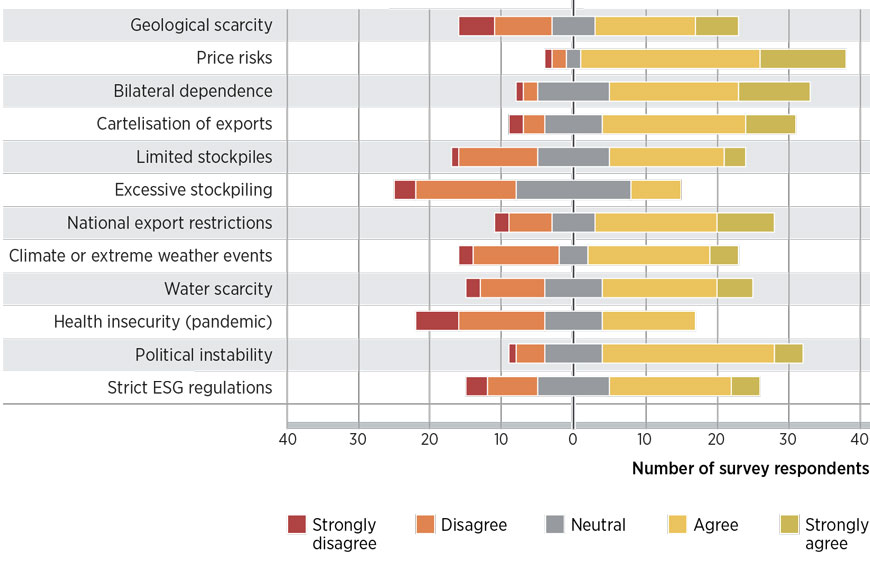
IRENA scarcity ratio for critical materials: Calculation methodology
Figure 1.5 showcases scarcity ratios calculated by IRENA for a selection of critical materials, namely copper, graphite, nickel, cobalt, lithium, manganese, neodymium, dysprosium, iridium and platinum. These ratios effectively demonstrate the disparity between current supply and future demand for these materials. The calculations are based on data obtained from credible external sources, encompassing 2022 supply and projected energy and non-energy demand in 2030 for these materials. Furthermore, IRENA is in the process of developing a comprehensive analysis of the demand-supply gap specifically tailored for its upcoming EV batteries report. Table A1 provides a comprehensive overview of the current and projected demand and supply figures, complemented by details pertaining to the existing reserves and resources for critical materials.
TABLE A1 Current and projected demand and supply for critical materials
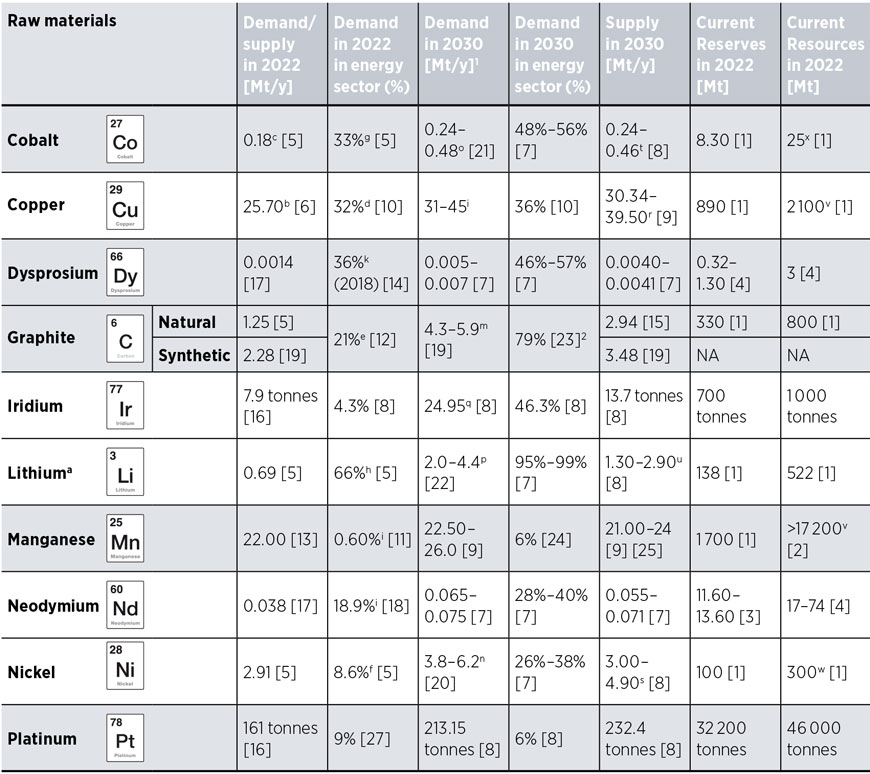
2. While majority of graphite used for the battery production is natural graphite, a share of natural and synthetic graphite in batteries differs as a result of various factors, including price, availability and inherent benefits of each type.
Sources: [1] USGS, 2023; [2] USGS, 2018; [3] Yao et al., 2021; [4] Junne et al., 2020; [5] Fastmarkets, 2023; [6] S&P Global IQ, 2022; [7] Eurometaux, 2022; [8] IRENA analysis; [9] McKinsey, 2023; [10] BNamericas, 2022; Eurometaux, 2022; IHS Markit, 2022; Minerals Council of Australia, 2022; S&P Global IQ, 2022; Systemiq, 2023; [11] Benchmark Minerals, 2019; [12] Government of Canada, 2022; [13] Euro Manganese, 2022; [14] JRC, 2020; [15] WSJ, 2023; [16] Johnson Matthey, 2022; [17] The Institute of Energy Economics, Japan, 2022; [18] OEC, 2023; [19] Mining.com, 2021; Mitchell and Deady, 2021; NVM, 2021; QYResearch, 2023; [20] Eurometaux, 2022; Garvey, 2021; McKinsey, 2023; Minerals Council of Australia, 2022; Mining.com, 2021; Nickel Asia, 2022; Systemiq, 2023; Vale, 2022; [21] Cobalt Blue Holdings, 2022; Darbar, 2022; Eurometaux, 2022; Fu, 2020; McKinsey, 2022; Mining. com, 2021; NVM, 2021; Systemiq, 2023; [22] Albemarle, 2023; Eurometaux, 2022; Lazzaro, 2022; McKinsey, 2022; NVM, 2021; S&P Global IQ, 2022; Systemiq, 2023; [23] Els, 2022; [24] Moore Finance, 2022; [25]: Jupiter Mines, 2023.
Notes: CSP = concentrated solar power; EV = electric vehicle; PV = photovoltaic; Mt = megatonne.
a Refers to lithium carbonate equivalent (LCE).
b Refers to in refined copper demand.
c Refers to refined cobalt demand.
d In 2021, 32% of refined global copper consumption pertained to energy transition end-uses such as T&D, wind, solar PV, EV and charging, and energy storage. Copper demand from energy transition end-uses is expected to peak in 2035 with a share of 42%.
e Refers to all battery types, not only EV and energy storage batteries.
f Refers to energy transition related end-uses such as EV’s (8.11%) and energy storage batteries (0.40%).
g Refers to energy transition related end-uses such as EV’s (33.00%).
h Refers to energy transition related end-uses such as EV’s (60.40%) and energy storage batteries (5.30%).
i Refers to Electrolytic Manganese Dioxide (EMD) used for Lithium-ion batteries and Alkaline batteries. This data is from 2019.
j Demand from batteries accounts for 4%, demand from NdFeB permanent magnets accounts for 80% of demand, from which ~6% comes from wind energy applications and ~12% from EV motors.
k Dysprosium used for wind energy and motor applications are taken into account in this category.
l Based on 6 different forecasts. The average forecast shows a copper demand of 38.7 Mt by 2030.
m Based on 3 different forecasts. The average forecast shows a natural graphite demand of 4.6 Mt by 2030.
n Based on 9 different forecasts. The average forecast shows a nickel demand of 4.8 Mt by 2030.
o Based on 10 different forecasts. The average forecast shows a cobalt demand of 0.35 Mt by 2030.
p Based on 10 different forecasts. The average forecast shows a Lithium LCE demand of 3.19 Mt by 2030.
q IRENA estimates an annual electrolyser capacity addition of 100 GW by 2030. Assuming 40% of electrolysers are PEM and 400kg per 1 GW of PEM electrolysers, electrolysers would represent an iridium annual demand of 16 tonnes in addition from demand from other sectors.
r Based on 5 different forecasts. The average forecast shows a copper supply of 34.54 Mt by 2030.
s Based on 7 different forecasts. The average forecast shows a nickel supply 4.14 Mt by 2030.
t Based on 11 different forecasts. The average forecast shows a cobalt supply of 0.31 Mt by 2030.
u Based on 8 different forecasts. The average forecast shows a lithium (LCE) supply of 3.14 Mt by 2030.
v 2,100.00 (identified resources) 3,500.00 (undiscovered resources)
w Identified land-based resources averaging approximately 0.5% nickel or greater contain at least 300 million tonnes of nickel, with about 60% in laterites and 40% in sulphide deposits. Extensive nickel resources also are found in manganese crusts and nodules on the ocean floor.
x More than 120 million tonnes of cobalt resources have been identified in polymetallic nodules and crusts on the seabed.
y Total global identified resources are more than 17 billion metric tonnes of manganiferous material. An additional vast resource of manganese lies on the seabed, mostly in international waters and at great depths.